
2018
tekst i zdjęcia: Wojciech Dąbrowski © - text & photos
Returning from the interesting expeditions I always try to write a travel report - to share my updated knowledge and to help other travelers in their preparations to the voyage. A lot of such reports you can already see on my website - sorry - most of them in Polish only. New reports require work and time. Unfortunately it is now harder and harder for me to find the time. On this page you will see some interesting pictures from the last years. They are waiting to be used in the coming reports. I hope to write them someday...
Po powrocie z każdej ciekawej podróży staram się napisać ilustrowany raport, by podzielić się moją świeżo zdobytą wiedzą i w ten sposób pomóc innym podróżnikom w ich przygotowaniach do wyjazdów. Wiele takich raportów znajdziecie już na moich stronach. Niestety pisanie tych raportów to praca pochłaniająca sporo cennego czasu. Nie zawsze mogę znaleźć ten czas... Na tej stronie znajdziecie co ciekawsze zdjęcia do tematów, które czekają na przygotowanie raportów. Mam nadzieje, że kiedyś doczekają się one osobnych stron... Niektóre już się doczekały...
At the end of March I returned happily from the first trip of 2018! This time my route led to Central America and the USA. I wanted to start this journey with a week cruise in the Caribbean (in this expensive region for the backpacker this is the best way to reach the islands) Almost until the last minute I waited until the shipping line for only five days before departure from the Miami reduced the fare for a lonely passenger to half of the cabin price. It was a va banque game, because if all the cabins had been previously sold, there would be no such option. The rest for the veteran of world trails was already the proverbial pit. It is not the time when requests for reservations were sent by letter or fax ... And so the plan of the next lonely expedition was completed. You can see her map here, At the beginning I stopped for a short time in Florida. Here is Miami:
W końcu marca wróciłem szczęśliwie z pierwszej podróży 2018 roku! Tym razem mój szlak prowadził do Ameryki Środkowej i USA. Chciałem rozpocząć tę podróż od tygodniowego rejsu po Karaibach (w tym drogim dla trampa regionie to najlepszy sposób na dotarcie do wysp) Niemal do ostatniej chwili czekałem, aż linia żeglugowa na 5 dni przed wypłynięciem statku z Miami opuści o połowę cenę za kajutę dla samotnego pasażera. To była gra va banque, bo gdyby wcześniej sprzedano wszystkie kajuty, to takiej opcji by wcale nie było. Reszta dla weterana światowych szlaków była już przysłowiową pestką. To nie te czasy, gdy prośby o rezerwacje wysyłało się listem lub faxem... Teraz siada się do komputera i od ręki kupuje się bilety... I tak dopięty został plan kolejnej samotnej ekspedycji. Jej mapkę możecie zobaczyć tutaj, Na początku zatrzymałem się na krótko na Florydzie. Oto Miami:
W pobliskim West Palm Beach odbywał się akurat festiwal ulicznego malarstwa. Było co oglądać!
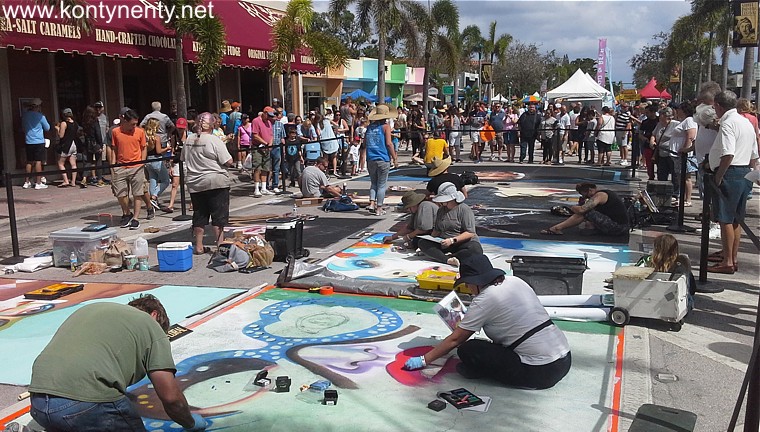
On a Sunday morning, I embarked on my big new ship. Honestly, I do not like it in such giants, resembling a roomy wardrobe, where you can stuff 4,000 noisy passengers. But in such situations, the choice, unfortunately, is determined by the route and price.
W niedzielny poranek zaokrętowałem się na mój wielki, nowy statek. Szczerze mówiąc, to ja wcale nie gustuję w takich olbrzymach, przypominających pojemną szafę, w której można upchać 4 tysiące hałaśliwych pasażerów. Ale w takich sytuacjach niestety o wyborze decydują trasa i cena.
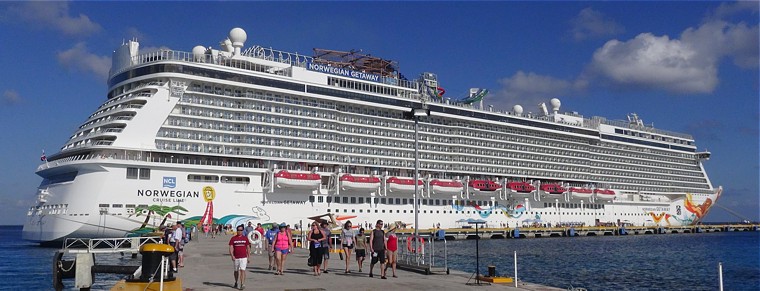
The first island we visited was Honduran Roatan, where as the only of these 4,000 passengers of our ship I decided to climb to the highest peak of the island - above all for the view, but also to see the villages and people living there.
Pierwszą wyspą, którą odwiedziliśmy był honduraski Roatan, gdzie jako jedyny z tych 4 tysięcy pasażerów postanowiłem wspiąć się na najwyższy szczyt wyspy - przede wszystkim dla widoku, ale także aby zobaczyć po drodze wioski i żyjących w nich ludzi.
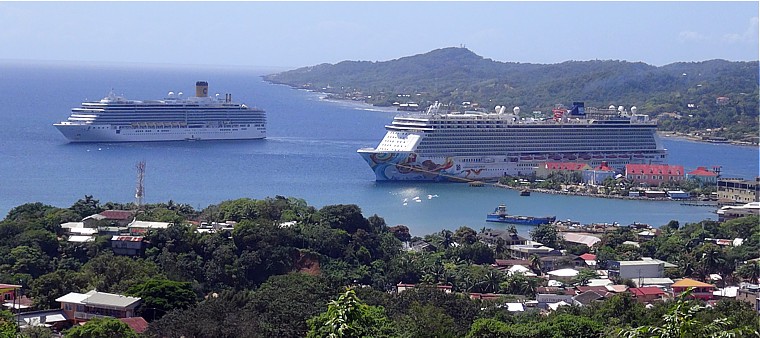
It was also an opportunity to look at the life of Roatan residents and to make some unique photos. Is it possible to imagine that such a little girl would do her homework while guarding her mother's market stall? Look at the picture below ...
Była to także okazja, aby przypatrzeć się życiu mieszkańców Roatanu i zrobić przy okazji kilka niepowtarzalnych zdjęć. Bo czy można sobie wyobrazić, aby u nas taka mała dziewczynka odrabiała lekcje pilnując jednocześnie bazarowego straganu swojej mamy? Popatrzcie na zdjęcie poniżej...
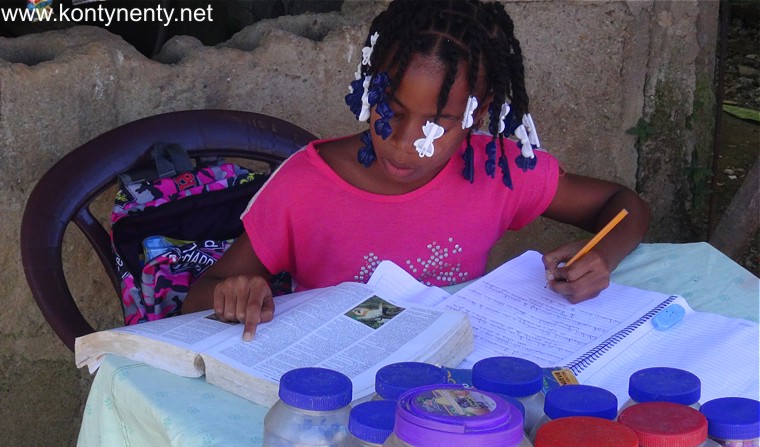
The next island on which our ship moored was Harvest Caye, belonging to Belize. This is a miniature of a tropical paradise isolated from the rest of the world, which has been adapted to the needs of tourists. Palms, beaches, pools and... the atmosphere of a beautiful tourist ghetto, from which you can not move anywhere:
Kolejną wysepką, na której zacumował nasz statek był Harvest Caye, należący do Belize. To odcięta od reszty świata miniatura tropikalnego raju, który przystosowano do potrzeb turystów. Na pasażerów czeka tu masa (dodatkowo płatnych) rozrywek. Palmy, plaże, baseny i... atmosfera pięknego turystycznego getta, z którego nigdzie nie można się ruszyć:
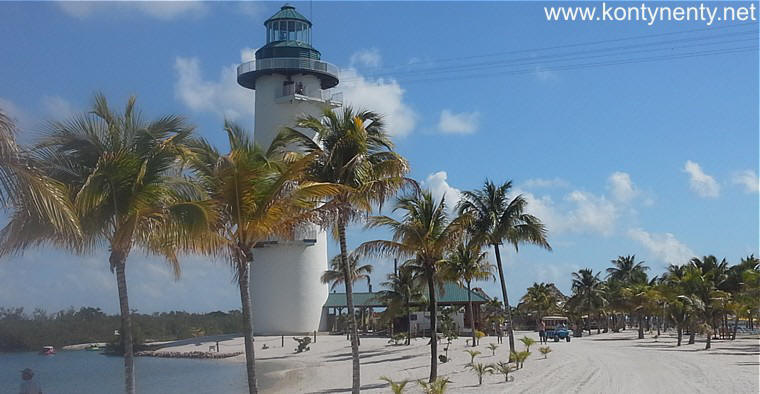
Then a similar port appeared on our route - Costa Maya, only that it was located not on the island but on the coast of the Yucatán peninsula. Costa Maya is a stylized tourist town with numerous shops and restaurants:
Podobnie wyglądał kolejny port na naszej trasie - Costa Maya, tyle tylko, że położony był nie na wyspie, a na wybrzeżu Półwyspu Jukatan. Costa Maya to stylizowane turystyczne miasteczko z licznymi sklepami i restauracjami:
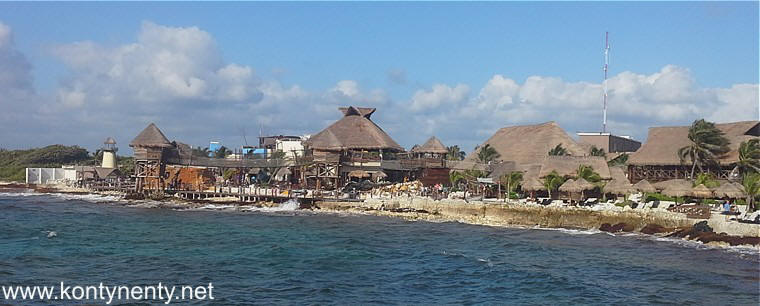
But you can also get to know the Mexican folklore: colorful costumes made of bird feathers and watch the exciting aerial dance of voladores - men fluttering on ropes unwrapping the 30-meter mast. I have seen these performances several times in my life, but they have always aroused my admiration.
Ale można tu poznać także meksykański folklor: barwne kostiumy wykonywane z piór ptaków i obejrzeć emocjonujący napowietrzny taniec voladores - mężczyzn fruwających na linach odwijających się z 30-metrowego masztu. Widziałem te popisy już kilkakrotnie w moim życiu, ale zawsze na nowo budziły mój podziw.
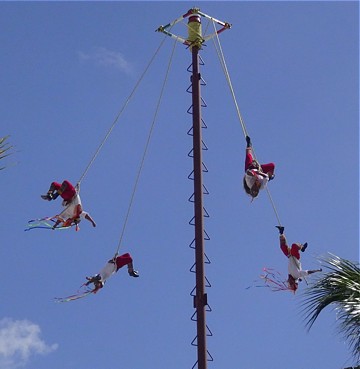
Chętni za opłatą mogli pocałować w nos delfina:
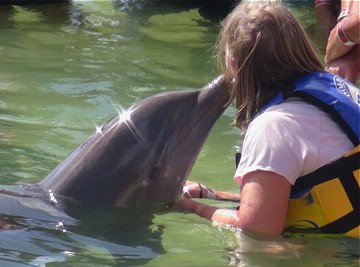
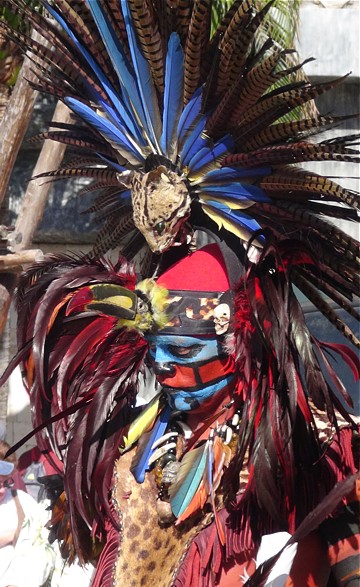
Costa Maya
The last visited port on the route of our cruiser was located on the large Mexican island of Cozumel. A beautiful promenade with numerous monuments runs here along the coast.
Ostatni odwiedzany port na trasie naszego rejsu był położony na dużej meksykańskiej wyspie Cozumel. Wzdłuż wybrzeża przebiega tu piękna promenada z licznymi pomnikami.
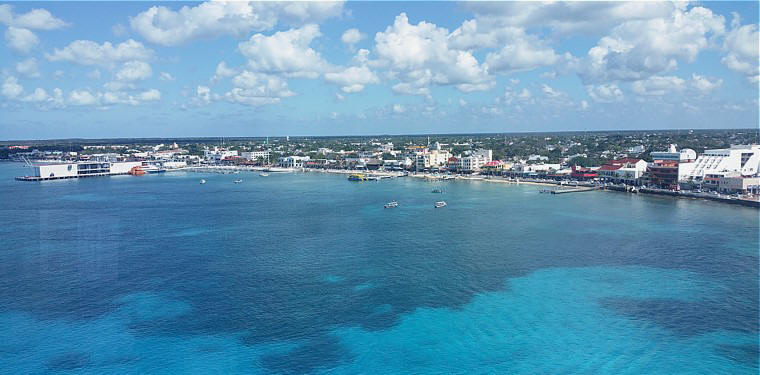
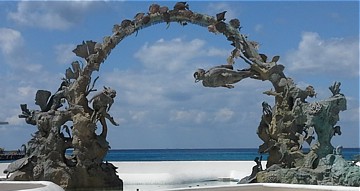
Jest wśród nich pomnik poświęcony wybitnemu badaczowi głębin morskich - Jacquesowi Cousteau, który "odkrył" mało niegdyś znany Cozumel, a dokładniej - otaczające go piękne rafy koralowe dla świata.
Cozumel ma kilka zamkniętych dla ruchu deptaków, konne dorożki dla strudzonych upałem i osobliwy pomnik meksykańskiego Janosika - Pancho Villa siedzącego na ławce przed sklepem, przy którym można się fotografować:
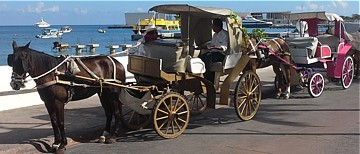
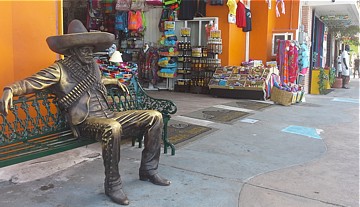
Among the monuments there is one dedicated to the outstanding explorer of the deep sea - Jacques Cousteau, who "discovered" the once-not-famous Cozumel, or more precisely, the beautiful coral reefs surrounding it. Cozumel has several pedestrian streets closed for traffic, horse carriages for heat-stressed and a strange statue of Pancho Villa sitting on a bench in front of the shop where you can take photos with him...
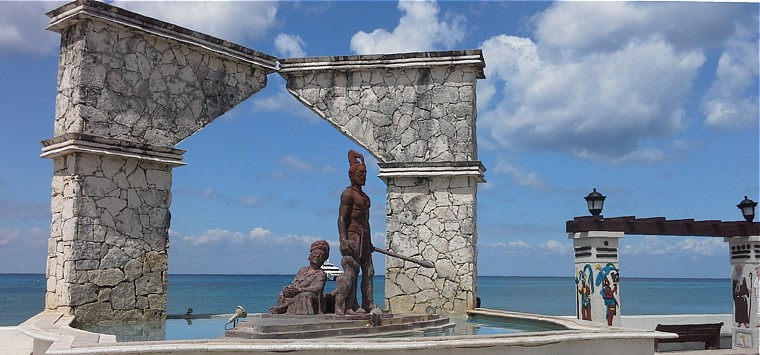
From Cozumel our ship returned to Miami, where I boarded a cheap flight to Havana, the capital of Cuba. I wanted to check how Cuba looks like after 40 years since my first visit. It turned out that not much has changed, and some areas of Havana look even worse than before. Basic food items are still available for pennies, but for coupons. Along the seaside promenade - the Malecon (photo below) you will many ruined buildings with windows covered with boards.
Z Cozumelu nasz statek wrócił do Miami, gdzie wsiadłem do samolotu taniej linii lecącego do Hawany - stolicy Kuby. Chciałem sprawdzić jak wygląda Kuba po 40 latach od mojej pierwszej wizyty. Okazało się, że niewiele się zmieniło, a niektóre rejony Hawany wyglądają gorzej niż dawniej. Podstawowe artykuły żywnościowe wciąż są dostępne za grosze, ale na kartki. Wzdłuż nadmorskiej promenady - Maleconu (zdjęcie poniżej) straszą rudery z oknami zabitymi deskami.
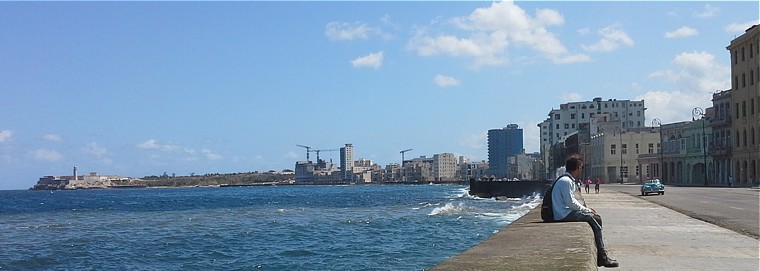
At its eastern end, over the port channel Malecon breaks at a right angle. There is a small fort of San Salvador, turned into a museum. And on the other side of the canal you will see guarding the entrance to the deep port Fortress of the Three Kings Hill (Tres Reyes del Morro) with a lighthouse:
Na swoim wschodnim krańcu, nad portowym kanałem Malecon załamuje się pod kątem prostym. Stoi tam mały fort San Salvador, zamieniony na muzeum. A po drugiej stronie kanału strzeże wejścia do głębokiego portu Forteca Wzgórza Trzech Króli (Tres Reyes del Morro) z latarnią morską:
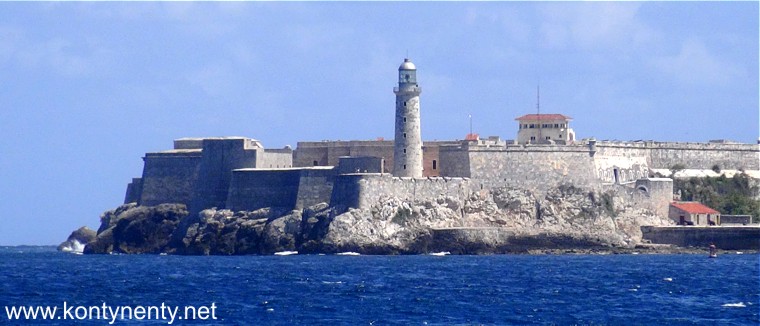
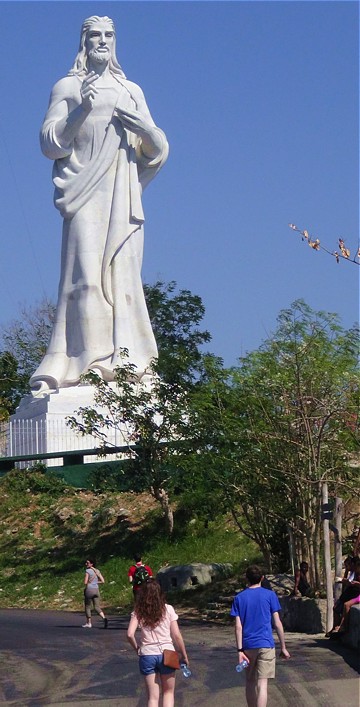
Forteca udostępniona jest do zwiedzania (wstęp 5 CUC) a na druga stronę kanału - do dzielnicy Casablanca można przepłynąć małym promem odpływającym często z oszklonego terminalu za przystanią wycieczkowców. Za przejazd płaci się tylko 1 CUP w gotówce - przy wejściu na prom. I tu pora przypomnieć, że na Kubie wciąż są dwie waluty: CUC [czyt. kuk] które dostaje zagraniczny turysta wymieniając przywiezioną twardą walutę (lepiej przywieźć euro, bo nie lubiany dolar jest obciążony tutaj dodatkowym 10% podatkiem) oraz CUP - w którym wypłacają pensje Kubańczykom. Za 1 CUC można dostać w casas de cambio lub u ludzi praktycznie 24 CUP.
Ponad przystanią Casablanca wysoko na zboczu stoi biały, 20-metrowy pomnik Cristo de la Habana - na pewno wart zobaczenia.
The fortress is open to visitors (entry fee 5 CUC) and to the other side of the canal - Casablanca district - you can cross canal the by a small ferry that often leaves the glassed terminal behind the cruise terminal. Only 1 CUP is paid for travel - at the entrance to the ferry. And here it is time to recall that in Cuba there are still two currencies: CUC [read kuk] which gets a foreign tourist exchanging imported hard currency (it is better to bring the euro, because the unliked dollar is burdened with an additional 10% tax) and CUP - in which they pay salaries to Cubans. For 1 CUC you can get in casas de cambio or from the people practically 24 CUP.
Overlooking the Casablanca ferry dock high on the slope stands the 20-metre monument of Christ de la Habana - well worth to see.
After Fidel's death, cruise ships started visiting Havana at the time I was there just one of them sailed from the port and I could photograph him in the company of Neptune standing on the plinth:
Po śmierci Fidela do Hawany nareszcie zaczęły zawijać statki wycieczkowe - akurat jeden taki wypływał z portu i mogłem go sfotografować w towarzystwie stojącego na cokole całkiem ładnego Neptuna:
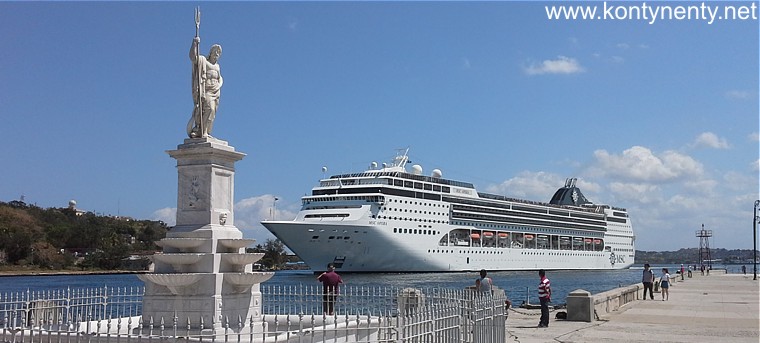
The very center of the Old Town presents itself nicely with several well-kept squares surrounded by arcaded buildings. On one of these squares stands a renovated Catholic cathedral:
Ładnie prezentuje się samo centrum Starego Miasta z kilkoma dobrze utrzymanymi placami otoczonymi przez podcieniowe budowle. Na jednym z tych placów stoi odnowiona katolicka katedra:
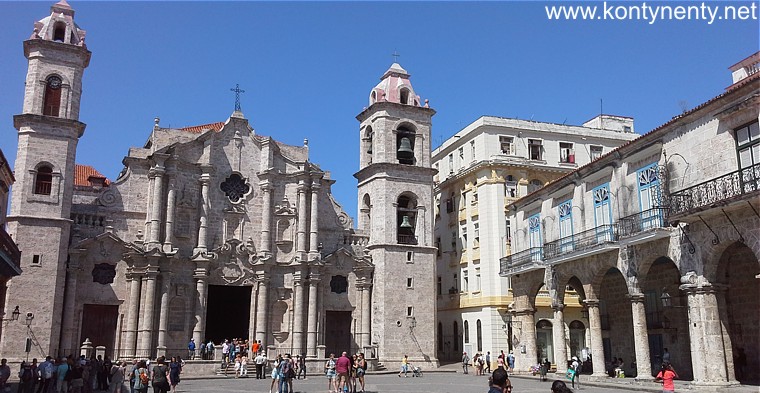
To this area of the city, tourist groups are brought in so the people will bring from Cuba a positive image of the country . And yet most of the streets of the vast Old Havana look different - as in the picture below. In such a lively street, I lived in a private accommodation ("casa particular") with very nice local people.
W ten rejon miasta przywozi się turystyczne grupy, by wywiozły z Kuby pozytywny obraz kraju. A przecież większość uliczek rozległej Starej Hawany wygląda inaczej - tak jak na zdjęciu poniżej. W takiej uliczce tętniącej życiem mieszkałem na prywatnej kwaterze ("casa particular") u bardzo sympatycznych ludzi.
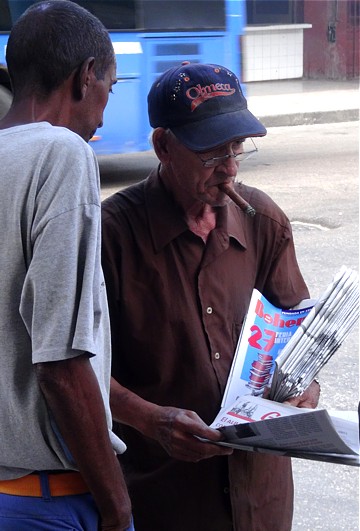
Ciekawe, że spacerując tymi zaniedbanymi uliczkami nawet po zmroku nie czułem zagrożenia. Turyści w tym rejonie pojawiają się rzadko, na pojedynczego cudzoziemca nikt nie zwraca uwagi. To daje możliwość przyglądania się do woli tego, co dzieje się wokół. Można też dyskretnie zrobić zdjęcie - na przykład takiemu gazeciarzowi z cygarem w zębach. Zwróciłem uwagę na to, że sprzedawał on założoną przez Fidela gazetę "Gramna".
It is interesting that walking through these neglected streets, even after dark, I did not feel a threat. Tourists in this region appear rarely, nobody pays attention to a single foreigner. It gives you the opportunity to look at the will of what is happening around you. You can also discreetly take a picture - for example, a newspaper man with a cigar in his teeth. I noticed that he was selling the "Gramna" newspaper that Fidel founded.
Ulice miast Kuby to prawdziwe muzeum motoryzacji. Obok archaicznych pojazdów z różnych okresów kursują tam wciąż rowerowe i motocyklowe riksze. Wciąż widzi się wypucowane fiaty 126p polskiej produkcji i wysłużone radzieckie łady.
Streets of Cuba are a real museum of motorization. In addition to archaic vehicles from various periods there are still cycling and motorcycle rickshaws. One can still see the polished Fiats 126 of Polish production and well-worn Soviet ladas.
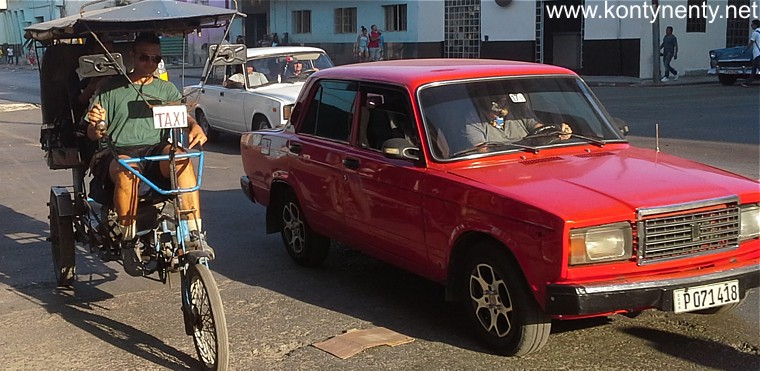
What may positively surprise in the city landscape are the renovated and painted in pastel colors the great old cruisers made before the socialist era. Among them, the aristocracy are cabriolets. They operates as vehicles for rent, you can take it for a tour around the city with local driver. Unfortunately, this is a fairly expensive service - you pay from $ 40 per hour.
To, co może pozytywnie zaskoczyć w krajobrazie miasta to wyremontowane i pomalowane na pastelowe kolory wielkie stare krążowniki szos sprzed ery socjalizmu. Wśród nich arystokracją są kabriolety. Funkcjonują one jako pojazdy do wynajęcia, można nimi odbyć wycieczkę po mieście z kubańskim kierowcą. Niestety jest to dość droga usługa - płaci się od 40 dolarów za godzinę.
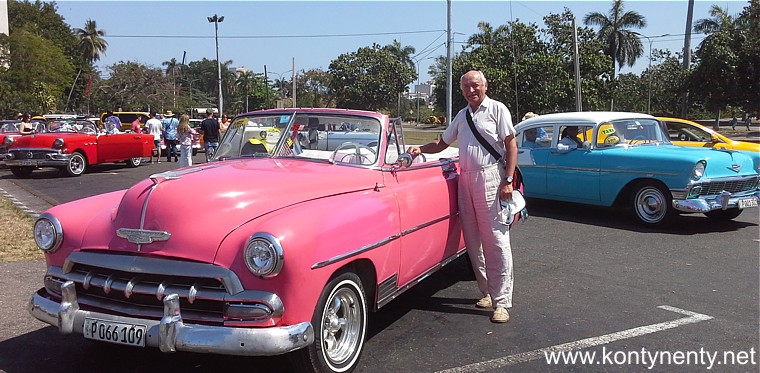
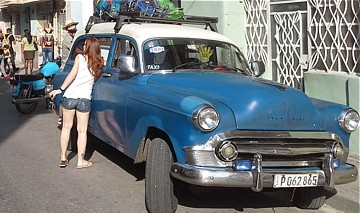
Niektóre archaiczne pojazdy funkcjonują tu wciąż jako zbiorowe taksówki i takim starym autem, wypełnionym zbieraniną turystów wybrałem się do miasteczka Vinales. Chciałem zobaczyć słynne kubańskie Mogoty. 180 km dystansu taka landara pokonuje w 3 godziny.
Some archaic vehicles still function here as collective taxis and I went to the small town of Vinales with such an old car filled with a foreign tourists. I wanted to see the famous Cuban Mogotes. 180 km of distance such a junk defeats in 3 hours.
Mogotes are limestone hills of various shapes - sometimes very fancy. It is not a large area and if you have two days you can walk around it. Alternatively, the most interesting places can be reached by rented bicycle or by shared taxi:
Mogoty to wapienne wzgórza o różnych kształtach - czasem bardzo fantazyjnych. Nie jest to duży obszar i jeśli ma się ze dwa dni czasu to można je obejść pieszo. Alternatywnie do najciekawszych miejsc można dojechać wypożyczonym rowerem lub składkową taksówką:
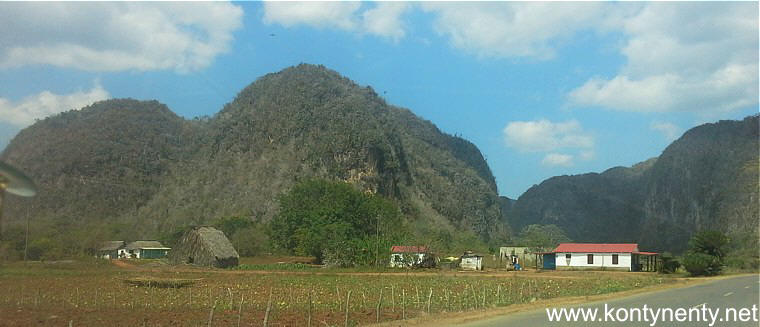
When on the next day I marched along Salud street to the public bus stop, which for 1 CUP took me to the airport, the florists who were always in the morning in this street said goodbye to me. Sunflowers are very popular in Cuba. Maybe because other cut flowers in the heat there will not last long. I thought to myself: this lovely Cuba!
Kiedy następnego dnia maszerowałem ulicą Salud do przystanku publicznego autobusu, który za 1 CUP miał mnie zawieźć na lotnisko żegnały mnie kwiaciarki urzędujące zawsze rano w tej ulicy. Bardzo popularne na Kubie są słoneczniki. Może dlatego, że inne kwiaty cięte w panującym tam upale długo nie przetrwają. Pomyślałem sobie: sympatyczna ta Kuba!
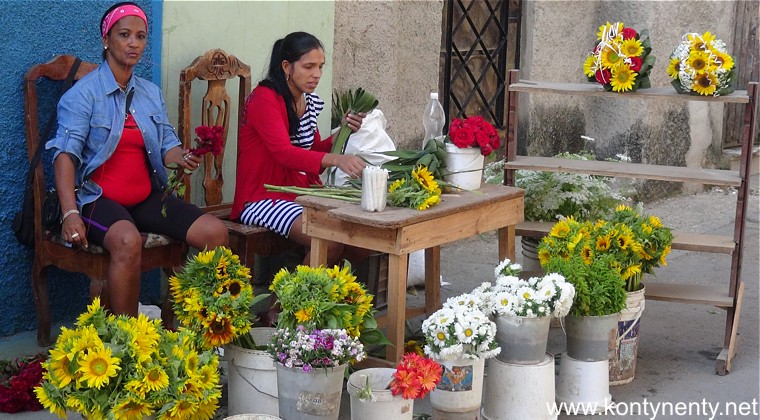
Then another cheap airline will took me to Cancun on Yucatan Peninsula. It was already my fourth visit to Mexico, but as usual I chosen such a places, who were not visited before. Cancun is well-known holiday destination, with nice beaches and luxury hotels. See- and sun lovers are coming here by planes from all over the world. The recreational part of Cancun lies actually on a long, narrow island connected by bridges to the mainland. I wandered this island up to "kilometer 18"
Potem kolejna tania linia lotnicza zabrała mnie do Cancun na Jukatanie. Była to moja czwarta wizyta w Meksyku, ale jak zawsze wybrałem takie miejsca, których nie widziałem przedtem. Cancun jest znaną miejscowością wczasową, z pięknymi plażami i licznymi hotelami. Przylatują tu samolotami amatorzy morza i słońca z całego świata. Wypoczynkowa część Cancunu leży właściwie na długiej, wąskiej wyspie połączonej mostami z lądem stałym. Wędrowałem po tej wyspie aż do "kilometro 18"
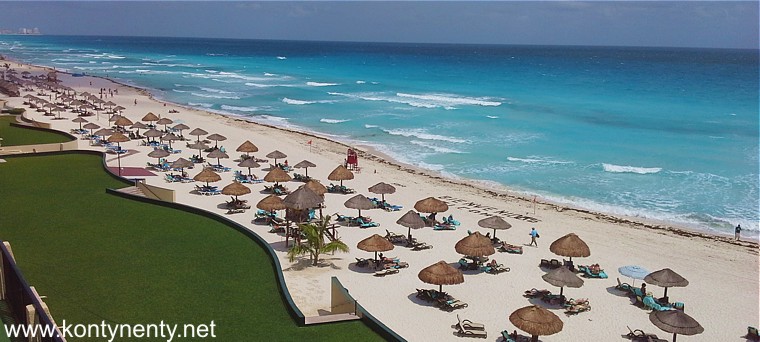
In Cancun began my big, epic bus trip, which after traveling over 5000 kilometers was to lead me to Los Angeles, California. It was a big challenge. The first stage - 4.5 hours of driving - led to the colonial town of Merida, where I lived in the nice Hostal Ermita - one of the nicest hostels on my route. Ermita is a nice place to meet other independent travelers. There was even a small swimming pool available for travelers:
W Cancun rozpoczęła się moja wielka autobusowa podróż, która po przebyciu ponad 5000 kilometrów miała mnie doprowadzić do Los Angeles w Kaliforni. To było wielkie wyzwanie. Pierwszy etap - 4,5 godziny jazdy - wiódł do kolonialnego miasta Merida, gdzie zamieszkałem w sympatycznym Hostal Ermita - jednym z najsympatyczniejszych hosteli na moim szlaku. Do dyspozycji podróżników był tu nawet mały basen:
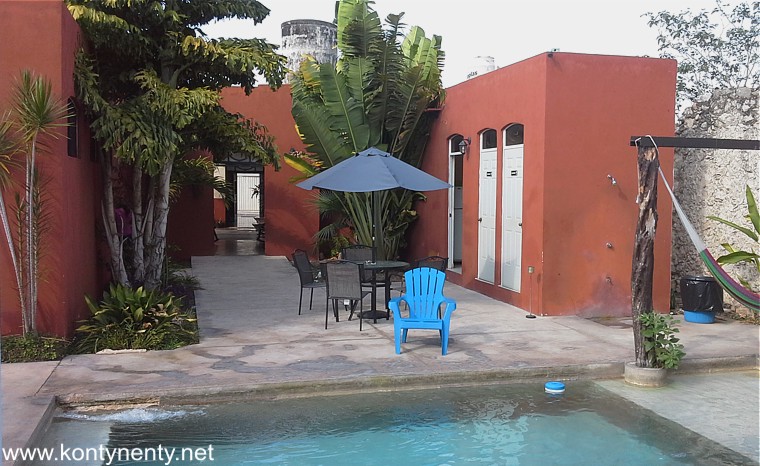
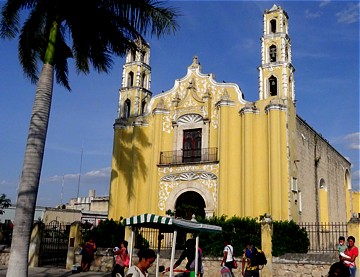
W Meridzie jest ładna katedra o szerokiej fasadzie, kilka kolonialnych kościołów - jak ten na zdjęciu obok i arkady wokół rynku i uliczki pełne kolorowych, parterowych domów. Ale wydarzeniem pierwszego dnia był koncert typowego meksykańskiego zespołu muzycznego - kapeli mariachis na głównym placu starego miasta (zdjęcie poniżej). Pięknie grali...
In Merida there is a cathedral, a few colonial churches - like the one in the picture, and small streets full of colorful, one-story houses. But the event of the first day was a concert of a typical Mexican band - mariachis band on the main square of the old town (see picture below).
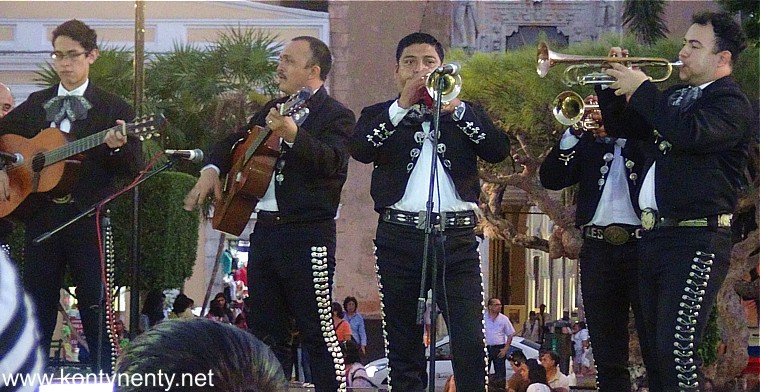
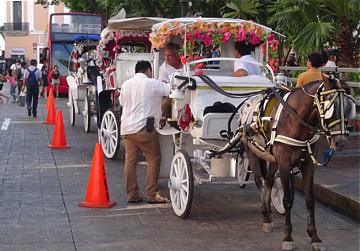
Przy tym samym placu na romantyczne pary i bogatych turystów czekają eleganckie dorożki. Ci, którzy wolą tańszy sposób zwiedzania miasta mogą wybrać czerwony double-decker, który ma początkowy przystanek tuż za nimi...
In the same square, elegant horsecarts are waiting for romantic couples and rich tourists. Those who prefer a cheaper way of exploring the city can choose a red double-decker, which has an initial stop right behind them...
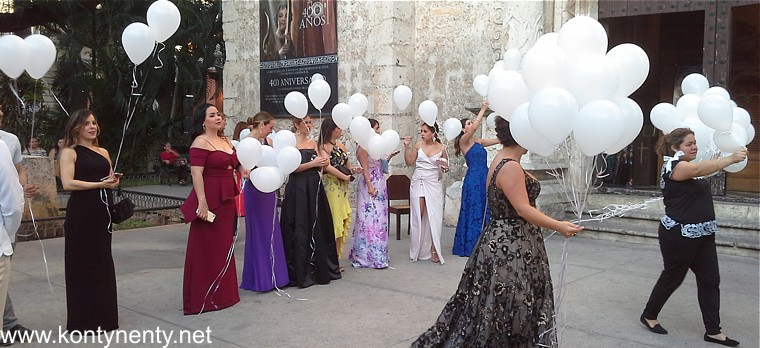
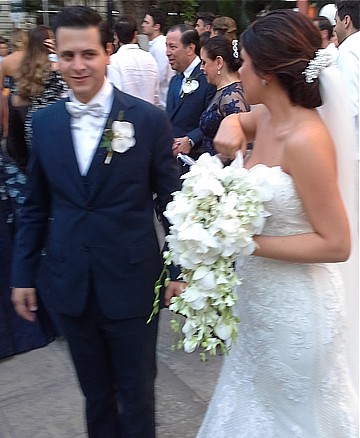
Przypadkiem przed jednym z kościołów trafiłem na ślub. Na państwa młodych czekał przed wyjściem szpaler przyjaciół z białymi balonikami, które zostały wypuszczone w powietrze, gdy para ukazała się w drzwiach kościoła.
It happened by coincidence that I was in front of one of the churches to see local marriage ceremony . A group of friends with white baloons were waiting for the just married outside the church to released them when the charming pair appeared...
Po zmroku najważniejsze budowle miasta Meridy są pięknie iluminowane.
After dark, the most important buildings of the city of Merida are beautifully illuminated.
Z Meridy zrobiłem sobie całodzienną wycieczkę do ruin miasta Majów w Uxmal - to 1,5 godziny jazdy autobusem za 65 pesos.
From Merida, I made a day trip to the ruins of the Mayan city in Uxmal - it's a 1.5 hour bus ride for 65 pesos each way:
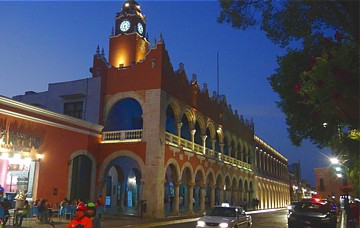
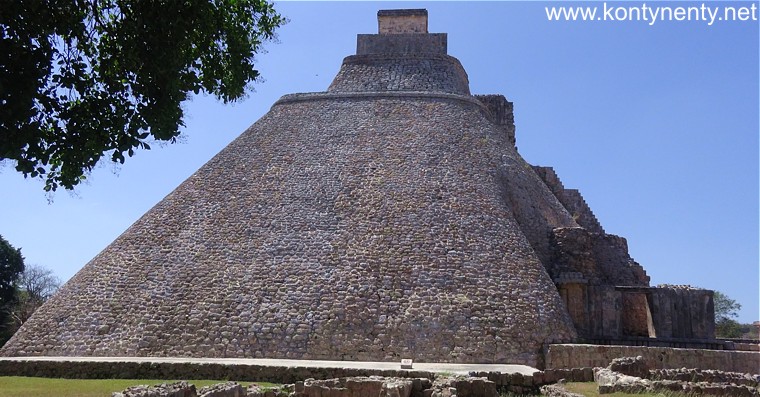
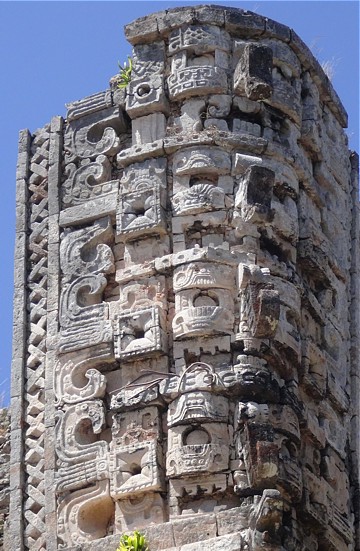
Kiedy po raz pierwszy byłem na Jukatanie w 1989 roku nie miałem dość czasu i pieniędzy, aby zboczyć do Uxmal. Nadrobiłem to teraz i jestem przekonany, że warto tam zajrzeć. Przy bramie trzeba kupić dwa różne bilety płacąc łącznie 243 pesos. Zaraz za wejściem do kompleksu otwiera się widok na imponującą, wysoką prawie na 40 metrów piramidę czarownika (zdjęcie powyżej). Potem wszyscy turyści kierują swe kroki do pałacu gubernatora (zdjęcie poniżej), Na ścianach budowli zachowały się wspaniałe płaskorzeźby...
When I was in Yucatan for the first time in 1989, I did not have enough time and money to make a side trip to Uxmal. I have made it now and I am convinced that it is worth to be there. At the gate you have to buy two different tickets. paying a total of 243 pesos. Immediately behind the entrance to the complex, there is a view of the impressive, nearly 40 meters high magician's pyramid (photo above). After that, all tourists are heading to the governor's palace (picture below). On the walls of the buildings there are wonderful reliefs...
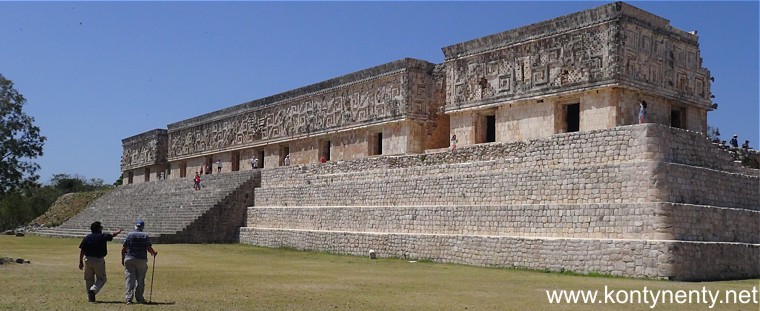
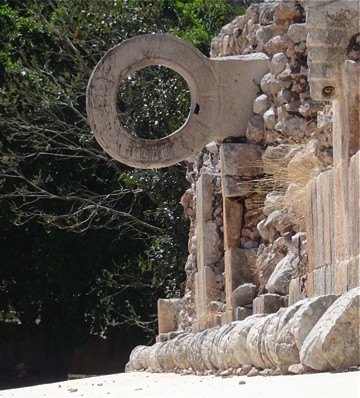
Zwiedzenie kompleksu ruin w Uxmal zabrało mi nieco ponad 2 godziny. To były jednak dwie godziny spędzone w niesamowitym upale. Zabierzcie ze sobą odpowiedni zapas wody! Niezależnie od czapki czy kapelusza warto posmarować nos i policzki sunscreenem.
W Uxmal zachowało się boisko do gry w pelotę. Przez umieszczone wysoko kamienne ucho widoczne na zdjęciu obok trzeba było przerzucić ciężką piłkę odbijaną kolanami, biodrami i przedramionami. Kapitana przegranej drużyny pozbawiano głowy. Brrr,,,
Visiting the
complex of ruins in Uxmal took me just over 2 hours. This, however, were two
hours spent in the incredible heat. Take an adequate supply of water with
you! Regardless of the hat or cap, it is worth to rub the nose and cheeks
with sunscreen.
In Uxmal, the pelota playing court has survived. The heavy ball, bent over
knees, hips and forearms, was placed through the high stone ring visible in
the picture. The captain of the lost team was deprived of his head. Brrr,,,
Wystająca ponad dywan roślinności piramida przypominała mi Tikal w Gwatemali:
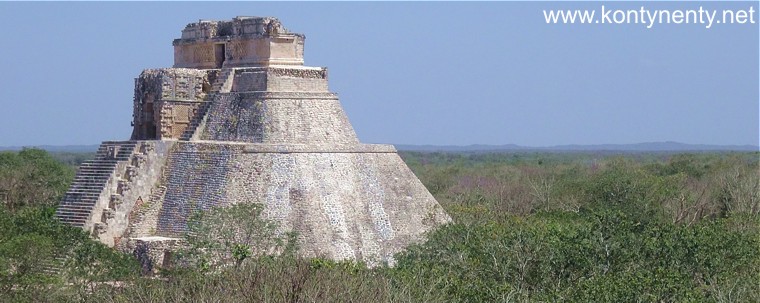
PaI returned to Merida, and on the next day, I took a bus to Palenque, Chiapas. The trip lasted 9 hours. This city is also famous for its monuments from the Mayan civilization. At the entrance to Palenque you will find such a monument of Maya:
Z Uxmal wróciłem do Meridy, by następnego dnia pojechać autobusem do Palenque w stanie Chiapas. Podróż trwała aż 9 godzin. To miasto również słynie z zabytków z okresu cywilizacji Majów. U wjazdu do Palenque znobaczycie taki pomnik Maja:
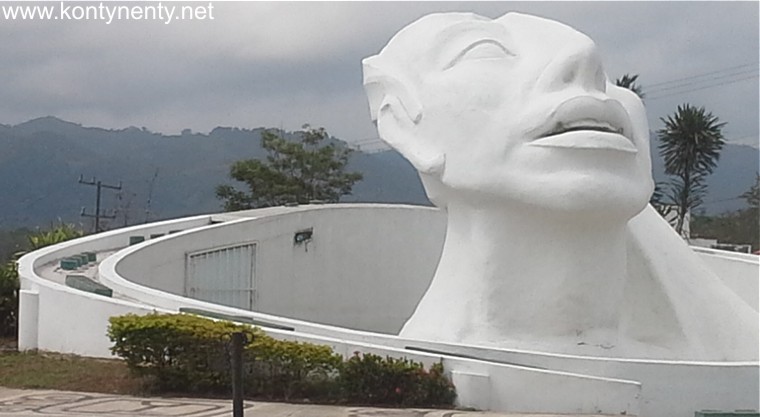
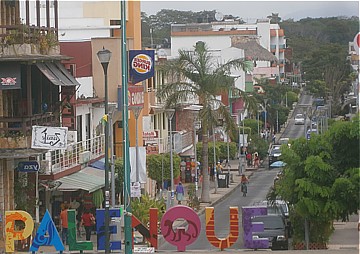
Palenque jest niewielkie - można je obejść w pół godziny. Przed małym kościółkiem Indianki sprzedają własnoręcznie wyprodukowane kolorowe serwetki i torby, a turyści fotografują się przy napisie z nazwą miasteczka. Takie napisy z nazwami widziałem ustawione w wielu miastach Meksyku.
Palenque is small - you can get around in half an hour. In front of a small church indigenous ladies sell hand-made colored rugs and bags, while tourists photograph themselves at the inscription with the town's name. I've seen such inscriptions with names set up in many cities in Mexico.
Chleb, taki, jaki jadamy w Polsce jest nieosiągalny. Tostowy chleb można dostać w kilku sklepach - m.in. popularnym supermarkecie Oxxo (34 pesos za duże opakowanie), ale miejscowi wciąż wolą tradycyjne placuszki z kukurydzianej mąki - tortillas, produkowane półautomatycznie w tortilleriach i sprzedawane na wagę po 16,50 pesos za kilogram.
Toast bread can be obtained in several stores - including a popular Oxxo supermarket (34 pesos for a large pack), but the locals still prefer the traditional corn tortillas, made semi-automatically in tortillerias and sold at 16.50 pesos per kilogram.
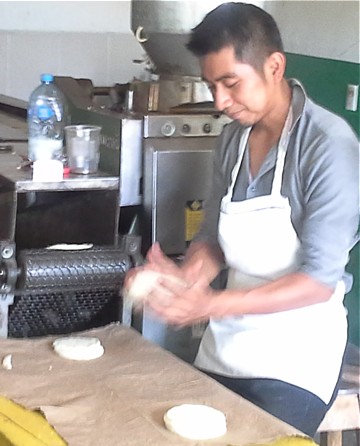
Famous ruins of Palenque are located 7 kms out of the town - frequent minibuses take there tourists for 20 pesos. Entry tickets cost 103 pesos. The most impressive in the complex is the Pyramid of Inscriptions:
Słynne ruiny Palenque znajdziecie 7 kilometrów za miastem. Często kursujące mikrobusy dowożą tam turystów za 20 pesos. Wstęp kosztuje 103 pesos. Najbardziej imponująca budowlą kompleksu jest Piramida Inskrypcji:
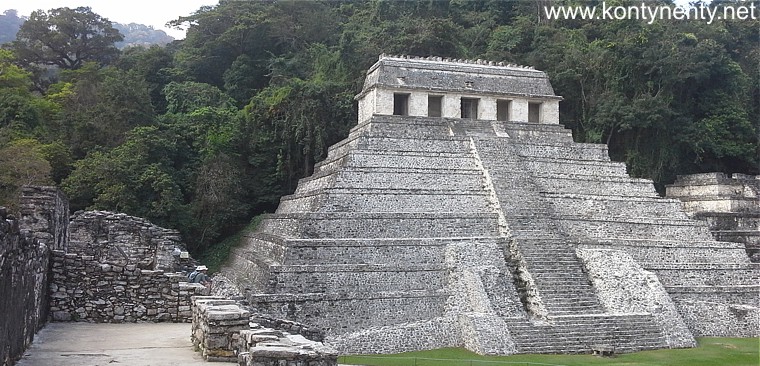
I was also interested in a relatively well-preserved palace with many bas-reliefs on the walls:
Mnie zaciekawił także stosunkowo dobrze zachowany pałac z wieloma płaskorzeźbami na ścianach:
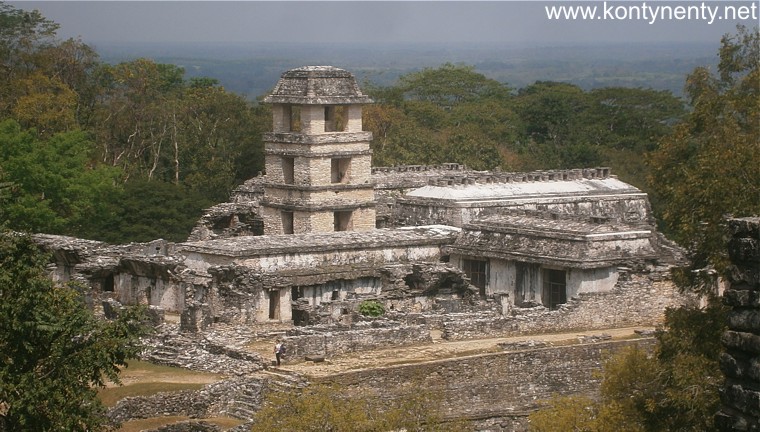
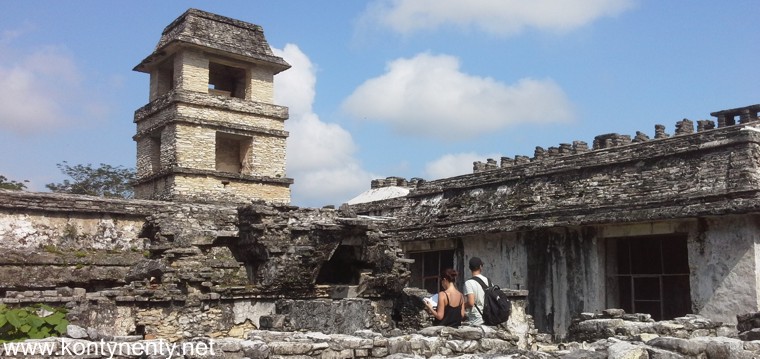
Wydobyty z piramidy sarkofag miejscowego króla eksponowany jest w ciekawym muzeum zbudowanym przy dojazdowej szosie. Ale w Palenque jest do oglądania znacznie więcej budowli, na niektóre można wchodzić dla lepszych widoków. Poniżej - grupa Cruz:
The sarcophagus of the local king, excavated from the pyramid, is displayed in an interesting museum built on the access road. But in Palenque, there are many more buildings to see, and some can be climbed for better views. Below - Cruz group:
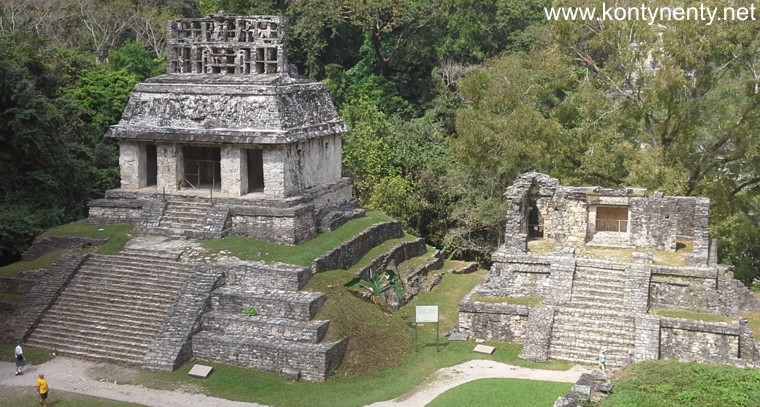
Tourist agencies in Palenque also offer trips to nearby waterfalls. I paid 180 pesos for the transport itself and went with them first to the nice 35-meter waterfall Misol-ha, under which the path goes to the small cave:
Agencje turystyczne w Palenque oferują także wycieczki do pobliskich wodospadów. Zapłaciłem 180 pesos za sam transport i pojechałem z nimi najpierw do ładnego 35-metrowego wodospadu Misol-ha, pod którym przechodzi sie ścieżką do małej groty:
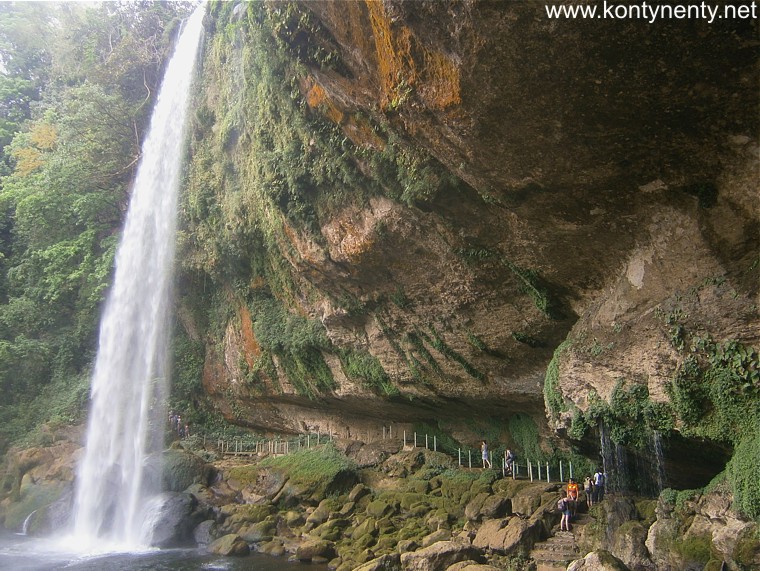
As part of the same trip, we then went to the Agua Azul waterfalls. These are even more spectacular. It is actually a whole stream of small waterfalls and cascades along which a convenient path was built for tourists' convenience:
W ramach tej samej wycieczki pojechaliśmy potem do wodospadów Agua Azul. Te są jeszcze bardziej spektakularne. Jest to właściwie cały ciąg niewielkich wodospadów i kaskad wzdłuż których wybudowano dla wygody turystów wygodną ścieżkę:
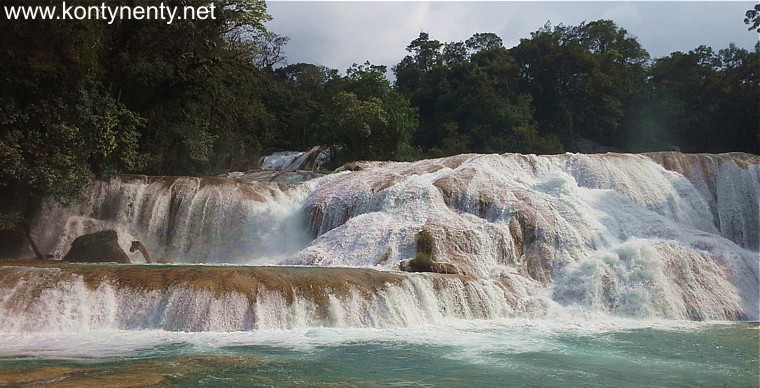
For admission to Misol-ha you have to pay an additional 30 pesos, and Agua Azul - 40.
On the next day, I drove the bus further north to reach the large city of
Villahermosa after just two hours:
Za wstęp do Misol-ha trzeba zapłacić dodatkowo 30 pesos, a do Agua Azul - 40.
Kolejnego dnia pojechałem autobusem dalej na północ, by już po dwóch godzinach dotrzeć do dużego miasta Villahermosa. Na głównym placu stoi tam ładny ratusz:
Główną atrakcją Villahermosy jest park, w którym ustawiono (wśród innych eksponatów) sprowadzone z La Venta głowy Olmeków. O ich zobaczeniu marzyłem od wielu lat. I marzenie się spełniło. Głowy - jak widać na zdjęciu - mają około dwóch metrów wysokości. Niestety jest ich tam zaledwie kilka.
The main attraction of Villahermosa is the park, where (among other exhibits) the heads of the Olmecs brought from La Venta ore on display. I have dreamed of seeing them for many years. And the dream came true. The heads - as you can see in the picture - are about two meters high. Unfortunately, there are only a few of them.
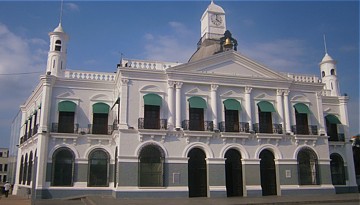
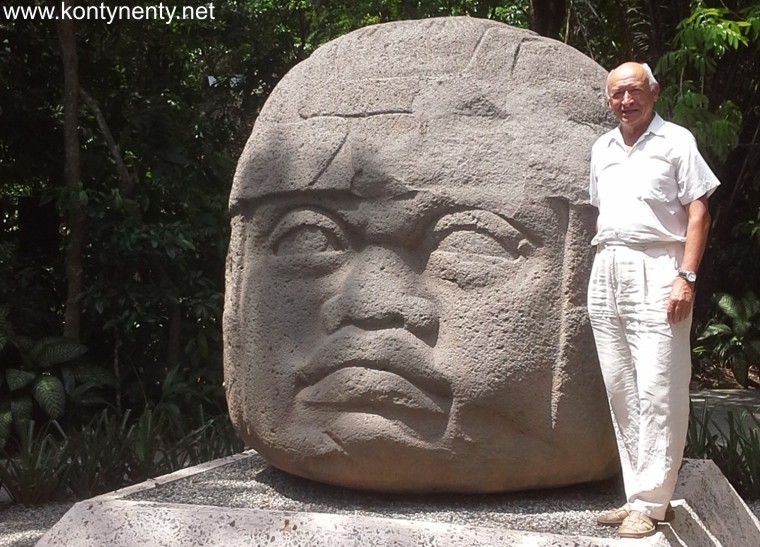
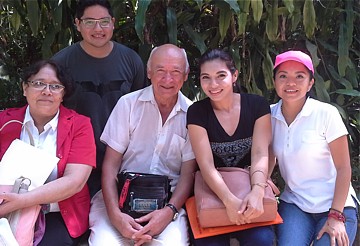
W parku La Venta spotkałem kilka grup studentów, którzy prosili mnie o udzielenie wywiadu (taką mieli zadaną pracę domową). No to udzieliłem - jednej grupie, drugiej grupie, trzeciej... Czwartej niestety musiałem odmówić. :) Ale byli bardzo sympatyczni...
In the La Venta park, I met few groups of students who asked me for an interview (this had such a homework). Well, I gave - one group, the second group, the third ... Unfortunately, I had to refuse the fourth group... But they were very nice ...
I was going from Villahermosa 8.5 hours by next bus to the port city of Veracruz, known to me only from the westerns. It turned out that the Plaza de Armas is surrounded by beautiful arcades:
Z Villahermosa jechałem autobusem 8,5 godziny do portowego miasta Veracruz, znanego mi wcześniej tylko z westernów. Okazało się, że tamtejszy Plaza de Armas otoczony jest pięknymi arkadami:
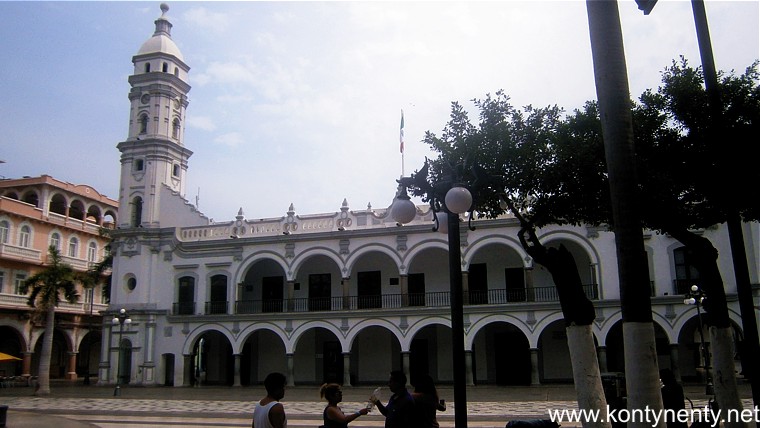
Są tu także liczne parki, a w nich egzotyczne drzewa z niezwykłymi kwiatami - popatrzcie na zdjęcie obok - nie wiem nawet, jak to się nazywa, ale na pewno może wywołać zachwyt...
There are also numerous parks here, and in them exotic trees with unusual flowers - look at the picture on the right column - I do not even know what it's called, but it can certainly trigger admiration ...
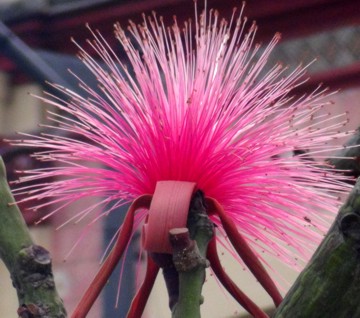
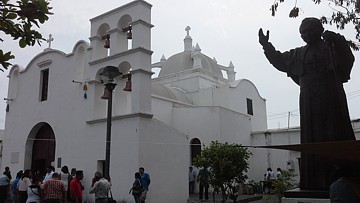
Byłem mile zaskoczony, gdy okazało się, że najstarszy kościół w Veracruz to kościół Santo Cristo de Buen Viaje czyli inaczej Kościół Podróżników. Do tego przed kościołem ujrzałem pomnik polskiego papieża - Jana Pawła II.
I was pleasantly surprised when it turned out that the oldest church in Veracruz is the church of Santo Cristo de Buen Viaje or the Church of the Travelers. In addition in front of the church I saw a monument of the Polish Pope - John Paul II.
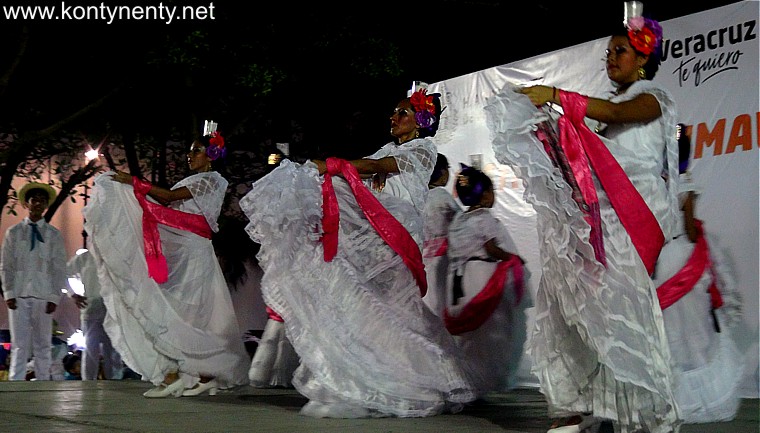
And in the evening at Plaza de Armas there was a great fiesta - performances of Mexican folk bands lasting several hours. The music rang, the skirts skipped, the shoes boasted the fandango rhythm! The fun was excellent...
In the morning I have to jump on the next bus - to Tampico. It took me all day to get there, but I still had a chance to see the old part of the city - nicely illuminated in the evening. Due to the iron balconies it reminded me New Orleans:
A wieczorem na Plaza de Armas była wielka fiesta - trwające kilka godzin występy meksykańskich zespołów folklorystycznych. Grzmiała muzyka, furkotały spódnice, trzewiki wybijały rytm fandanga! Zabawa była doskonała...
A wcześnie rano trzeba było jechać dalej - do Tampico. Ten etap podróży zabrał mi niemal cały dzień, ale mimo to zdążyłem obejrzeć starą część miasta, pięknie iluminowaną wieczorem. Żelazne balkoniki domów przypomniały mi Nowy Orlean:
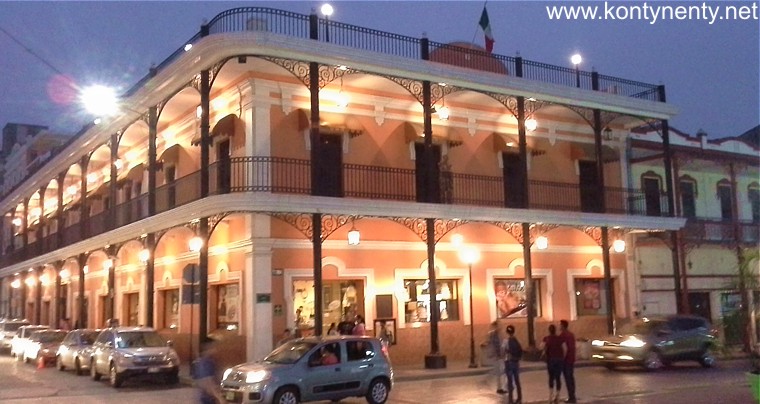
My trail led me onward to the Mexican city of Monterrey, which I knew from the TV black & white series "Zorro" (1957). When I got there after many hours of bus ride it turned out that the real Monterrey is located at the foot of the picturesque mountains and has many nice public buildings - including the state palace surrounded by fountains:
Mój szlak wiódł dalej do meksykańskiego miasta Monterrey, które znałem z serialu "Znak Zorro" (1957) emitowanego tuż po pojawieniu się w Polsce telewizji. Gdy dotarłem tam po wielu godzinach jazdy autobusem okazało się, że prawdziwe Monterrey położone jest u stóp malowniczych gór i ma wiele ładnych budynków publicznych - między innymi otoczony fontannami pałac rządu stanowego:
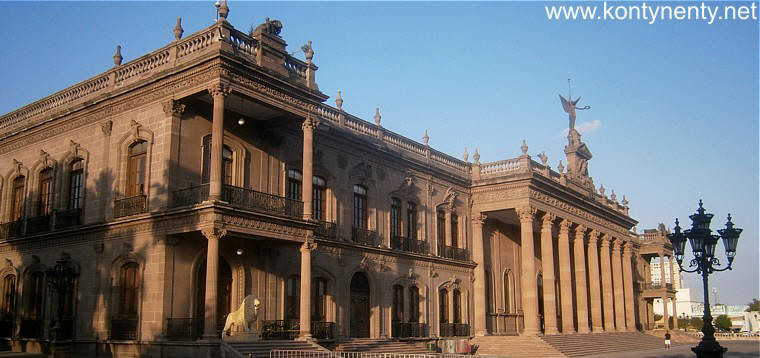
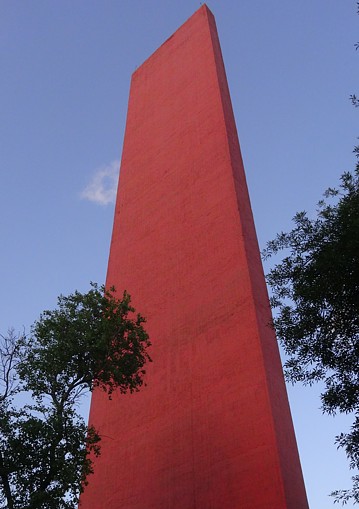
Faro del Comercio
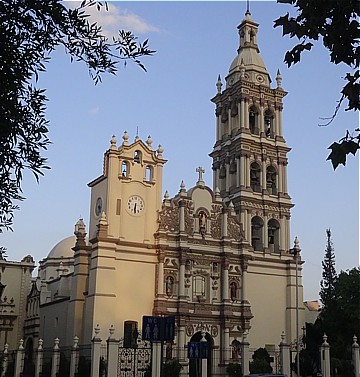
Monterrey ma także ładną katedrę (na zdjęciu powyżej), a na skwerze naprzeciw katedry kontrowersyjny 70-metrowy obelisk w kolorze ochry nazywany El Faro del Comercio. Ponad centralną częścią miasta dominuje Cerro de la Silla - masyw górski z charakterystycznymi zębami (zdjęcie poniżej). Monterrey leży na wysokości 540 metrów nad poziomem morza i upał jest tu mniej dokuczliwy.
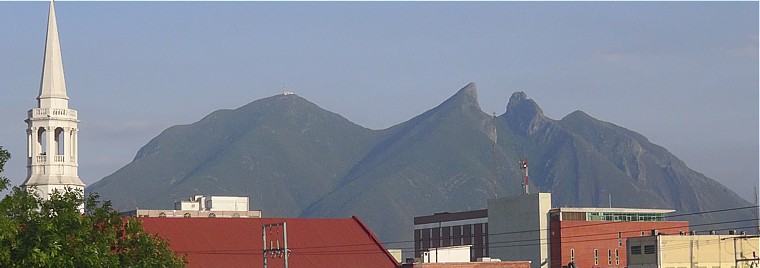
Monterrey also has a nice cathedral (pictured above), and on the square opposite the cathedral a controversial 70-meter obelisk in ocher color called El Faro del Comercio. Cerro de la Silla - a mountain range with characteristic teeth is dominating above the central part of the city (photo up left). Monterrey lies at an altitude of 540 meters above sea level and the heat here is less annoying.
The American Greyhound bus line has a branch in Mexico and a service from Monterrey to the US border. I used it and crossed this border in Laredo. Was this how I imagined the border river of Rio Grande? Look at the photo below:
Amerykańska linia autobusowa Greyhound ma swój oddział w Meksyku i oferuje serwis z Monterrey do granicy USA. Skorzystałem z niego i przekroczyłem tę granicę w Laredo. Czy tak wyobrażałem sobie graniczną rzekę Rio Grande? Popatrzcie na zdjęcie poniżej:

The little town of Laredo on the American side of the border is small and full of signboards in Spanish. There are many exchange offices exchanging currencies - mainly Mexican pesos. I stayed here only for a short time, I walked under the arcades stretching along the streets and departed soon - again by bus...
Miasteczko Laredo po amerykańskiej stronie jest niewielkie i pełne napisów w języku hiszpańskim. Funkcjonuje tu wiele kantorów wymieniających waluty - przede wszystkim meksykańskie pesos. Zatrzymałem się tu na krótko, pospacerowałem pod podcieniami ciągnącymi się wzdłuż ulic i ruszyłem w dalszą drogę - znów autobusem...
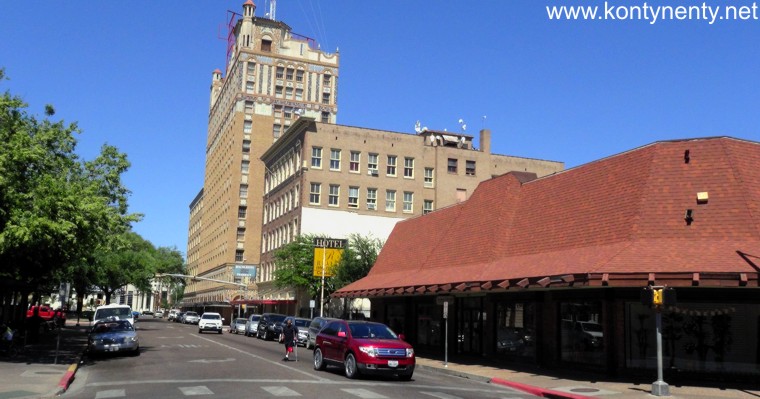
Greyhound's bus brought me to San Antonio, Texas. I was here many years ago - in 1981, when I was traveling with the same Greyhound across the US from the ocean to the ocean. But it was necessarily a very short stopover. However, I managed to visit the famous Alamo mission. I directed my first steps there and now, but in the evening the mission was already closed:
Autobus Greyhounda dowiózł mnie do San Antonio w Teksasie. Byłem tu już wiele lat temu - w 1981 roku, gdy z tym samym Greyhoundem przemierzałem USA od oceanu do oceanu. Ale to był z konieczności bardzo krótki stopover. Zdążyłem jednak wtedy zwiedzić słynną misję Alamo. Tam i teraz skierowałem swoje pierwsze kroki, ale pod wieczór misja była już zamknięta:
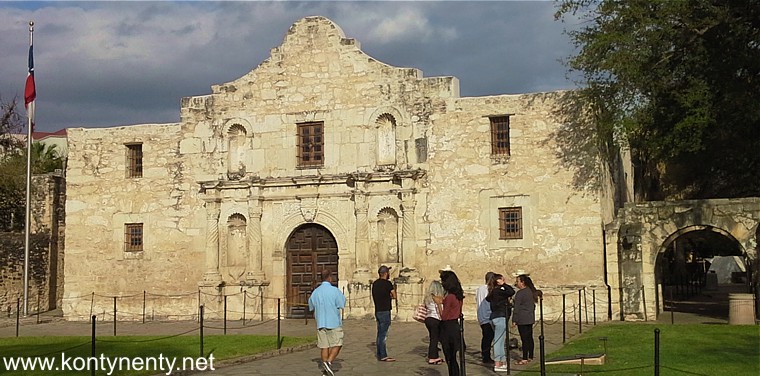
In fact, I stopped this time in San Antonio to hike the Mission Trail - a trail connecting the four former Catholic missions founded by the Spaniards. The group of these four missions is on the UNESCO World Heritage Sities list. I started in the morning from the Alamo mission. After over an hour of walking, I came to the mission of Concepcion:
Tak naprawdę to zatrzymałem się tym razem w San Antonio by przejść Mission Trail - szlak łączący cztery dawne misje katolickie założone jeszcze przez Hiszpanów. Zespół tych czterech misji jest na liście World Heritage Sities UNESCO. Wyruszyłem rano od misji Alamo. Po ponad godzinie marszu dotarłem do misji Concepcion:
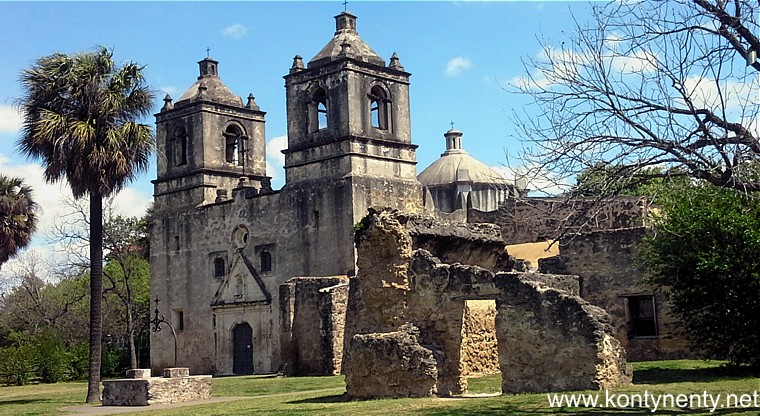
All these missions are alive - services for the local population are celebrated there. And admission to everyone is free. After visiting Cancepcion, I walked comfortable bicycle path built along the San Antonio River to the next mission - San Jose. This one is the biggest and in my opinion the most interesting on the whole route:
Wszystkie te misje żyją - odprawia się w nich nabożeństwa dla miejscowej ludności. I wstęp do wszystkich jest bezpłatny. Po zwiedzeniu Cancepcion pomaszerowałem wygodna ścieżką rowerową wybudowana wzdłuż rzeki San Antonio do następnej misji - San Jose. Ta jest największa i moim zdaniem najciekawsza na całym szlaku:
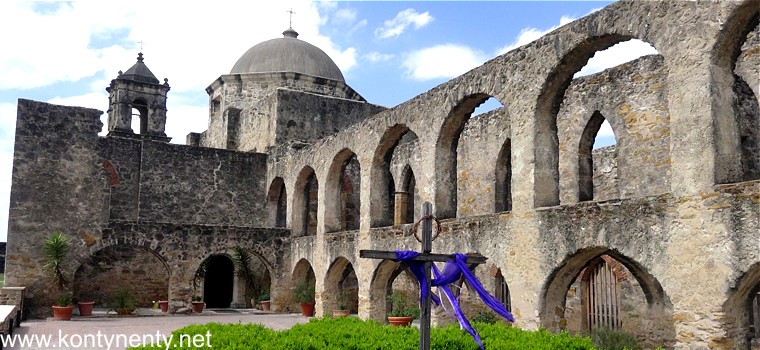
In San Jose delights the carved facade of the church, the side "window of the rose" and impresses the great size of the mission. Now I was still over an hour's walk to the San Juan Capistrano mission:
W San Jose zachwyca rzeźbiona fasada kościoła, boczne, pięknie zdobione "okno róży" i imponują wielkie rozmiary misji z kwaterami Indian wzdłuż murów. Teraz czekała mnie jeszcze ponad godzina marszu do misji San Juan Capistrano:
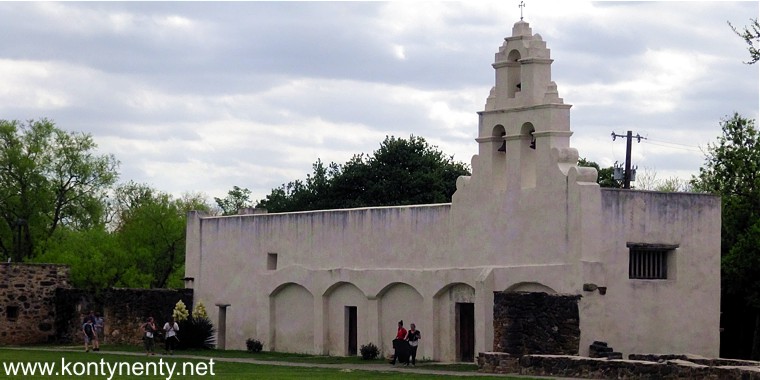
In San Juan, I found the mission church closed, because it is the area is the national park and the ranger went somewhere - sorry. I noticed that San Juan is a smaller and rather modest mission - probably the least interesting in the whole chain... The last leg of the walk was the shortest one - I went under an hour among riverside meadows full of blooming flowers before I reached the Espada mission. Cozy church, they opened there mini-museum:
W San Juan zastałem misyjny kościół zamknięty, bo jest to teren parku narodowego i ranger gdzieś akurat wyszedł - sorry. Odnotowałem, że San Juan jest mniejszą i skromną misją - chyba najmniej ciekawą w całym łańcuchu... Ostatni odcinek marszu był najkrótszy - szedłem poniżej godziny wśród nadrzecznych łąk pełnych kwitnących kwiatów nim dotarłem do misji Espada. To mała, ale ciekawa misja z przytulnym kościółkiem, jest tu też mini-muzeum:
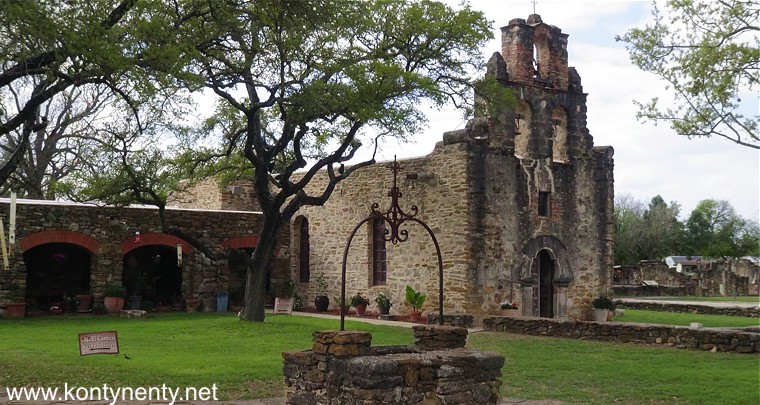
And here - in the last mission on the Mission Trail I met a lovely ranger, Carmelita. "Did you walk on foot 18 miles from the Alamo? Usually, people are riding this trail on bicycles! - she did not want to believe me. In the end, she congratulated me on an unusual feat. And she checked that the last bus comes back to San Antonio in 15 minutes - at 17.20. I was happy and happy - it was a special day!
I tu - w ostatniej misji na Mission Trail spotkałem uroczą rangerkę Carmelitę. -Przeszedłeś na piechotę tych 18 kilometrów od Alamo?Zazwyczaj ludzie jadą tym szlakiem na rowerach! - nie chciała mi wierzyć. W końcu pogratulowała mi niecodziennego wyczynu. I sprawdziła, że ostatni autobus wraca stąd do San Antonio za 15 minut - o 17.20. Byłem zadowolony i szczęśliwy - to był wyjątkowy dzień!
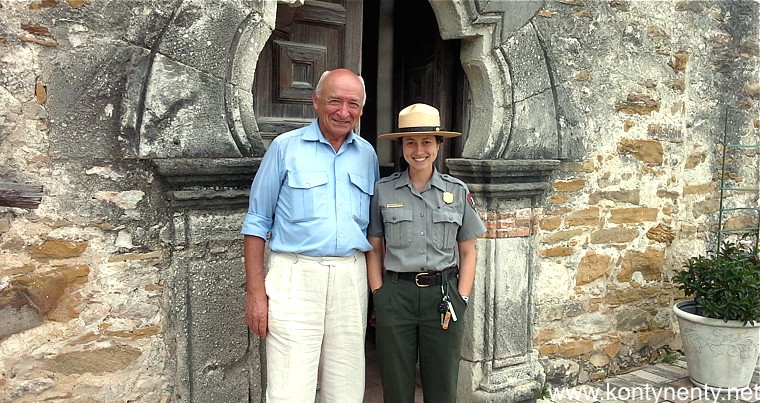
The next morning, the most difficult stage of the entire trip, which is quite a challenge, began - a 28-hour bus trip to Los Angeles. Among the crying negro children and dark-skinned passengers with an oversize bodies. Once on the way, I changed the bus once and moved the time twice. Texas, New Mexico, Arizona, California. It went quite well! Then I rested in a friend's house. They even find a time to show me the curiosity: Crystal Cathedral in Anaheim near Los Angeles:
Następnego ranka rozpoczął się bodaj najtrudniejszy etap całej podróży, będący nie lada wyzwaniem - 28-godzinna podróż autobusem do Los Angeles. Wśród płaczących murzyńskich dzieci i ciemnoskórych pasażerów o ponadnormatywnej tuszy. Raz po drodze zmieniałem autobus i dwa razy przesuwałem czas. Teksas, Nowy Meksyk, Arizona, Kalifornia. Poszło zupełnie nieźle! Odpocząłem potem w domu przyjaciół. Zdążyli mi jeszcze pokazać ciekawostkę: Kryształową Katedrę w Anaheim pod Los Angeles:
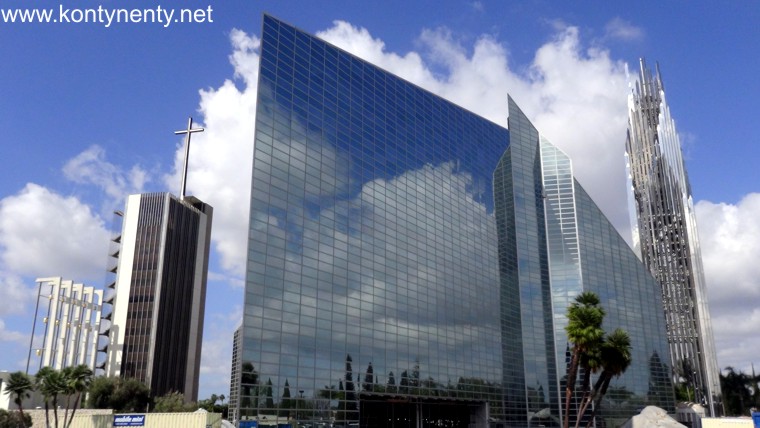
Two days later Norwegian Airlines took me to Gdansk via Oslo. One more great trip ended successfully. It was the time to think about the next one! :)
Norwegian Airlines przywiozły mnie do Gdańska via Oslo. Jeszcze jedna wspaniała podróż została zakończona sukcesem. Pora była pomyśleć o następnej! :)
Pisane na gorąco wiadomości i fotki z tej trasy możecie znaleźć w moim dzienniku podróży
In April 2018 I returned from the sea voyage around the British Isles! This wasn't of course an expedition ...:) A small ship leaving Amsterdam took me on a comfortable and well-organized cruise, in the last expensive cabin. It consisted that until now, busy with world-wide traveling, I had no opportunity to explore smaller and larger islands scattered around England. The ship turned out to be an old junk, built in 1985 and was sold couple of times, but I admit that it has maintained an elegant line:
W kwietniu 2018 wróciłem z morskiej podróży dookoła Wysp Brytyjskich! To nie była oczywiście żadna trudna ekspedycja... :) Niewielki statek odpływający z Amsterdamu zabrał mnie w wygodny rejs w najtańszej kabinie. Tak się składało, że dotychczas, zajęty światowym wojażowaniem nie miałem okazji poznać mniejszych i większych wysp rozsianych wokół Anglii. Statek okazał się staruszkiem, zbudowanym w 1985 roku, ale przyznacie, że zachował elegancką linię:
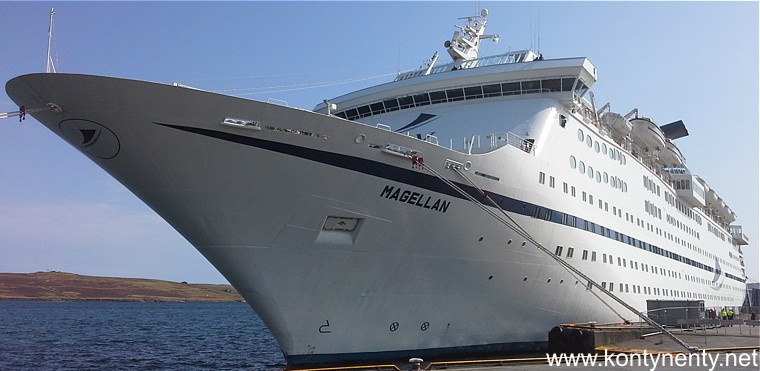
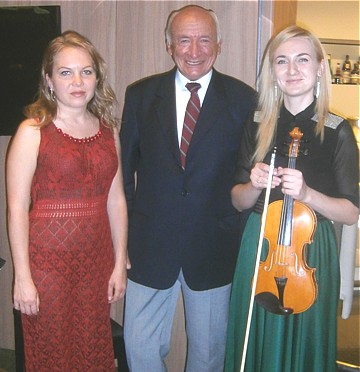
Co było najlepszego na tym statku? Wcale nie jedzenie, ale muzyka klasyczna, której mogłem słuchać każdego wieczoru. Dwie utalentowane artystki z Ukrainy: Anna (skrzypce) i Elina (fortepian) pięknie wykonywały popularne utwory wszystkich europejskich klasyków. Zadziwiał mnie ich szeroki repertuar - nie zdarzyło się podczas rejsu, aby jakiś utwór powtarzały. Podziwiałem ich kunszt i cieszyłem się, gdy na moją prośbę zabrzmiała także muzyka Chopina.
What was the best on this ship? Not food at all, but classical music that I could listen to each evening. Two talented artists from Ukraine: Anna (violin) and Elina (piano) beautifully performed popular works of all European classics. I was amazed by their wide repertoire - it did not happen during the cruise that they repeat any piece. I admired their art and I was very glad when Chopin's music sounded at my request.
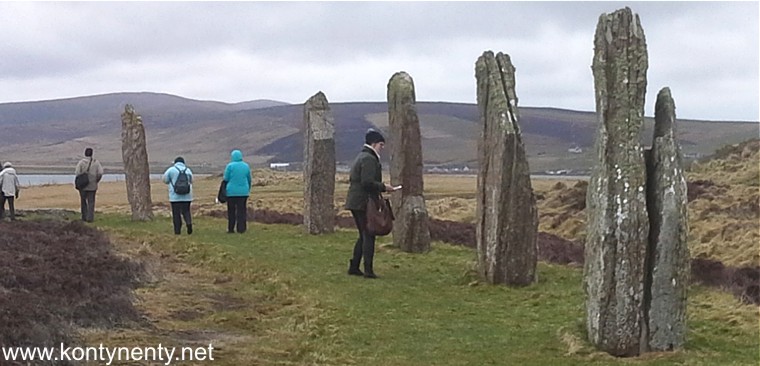
The first port we visited was Kirkwall in Orkney, where during the Second World War was the great naval base of Scapa Flow. Today, there is no trace of it, and the few tourists who come here admire the monuments from the previous era: a 100-meter stone circle in Brodgar (pictured above) and a settlement from the Neolithic age Skara Brae (below). Both of these objects are placed on the UNESCO World Heritage list.
Pierwszym portem, który odwiedziliśmy był Kirkwall na Orkadach, gdzie podczas drugiej wojny światowej była wielka baza marynarki wojennej Scapa Flow. Dziś nie ma po niej śladu, a nieliczni turyści, którzy tu docierają podziwiają zabytki z ubiegłej ery: 100-metrowy krąg kamienny w Brodgar (na zdjęciu powyżej) i osadę z epoki neolitu Skara Brae (poniżej). Oba te obiekty umieszczone są na liście World Heritage UNESCO.
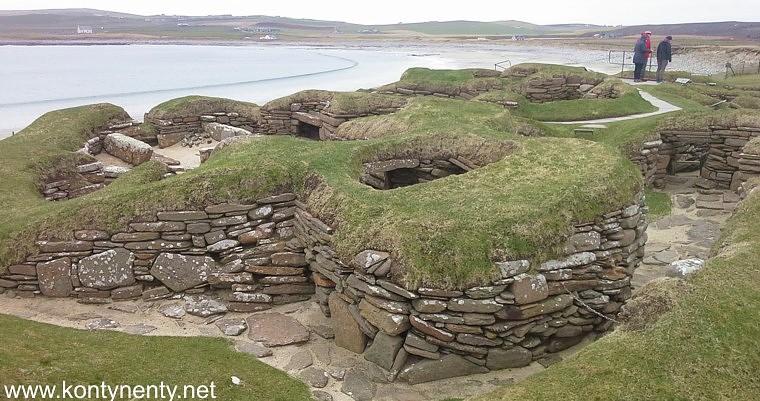
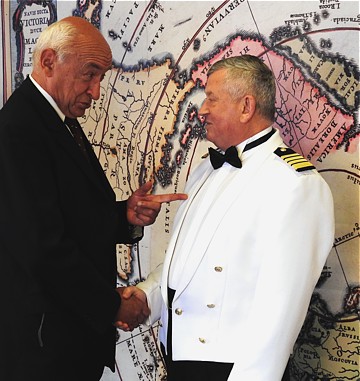
Podczas oficjalnego koktajlu miałem okazję poznać naszego kapitana - Valentina Żukowa. Nie skończyło się na stereotypowej wspólnej fotografii przy mapie. Rozmawialiśmy o podróżach. Gdy powiedziałem kapitanowi, że przejechałem Rosję od Murmańska do Władywostoku, kapitan odpowiedział: - A ja od Petersburga do Sachalinu!
During the official cocktail I had the opportunity to meet our captain - Valentin Zhukov. It did not end with a stereotypical joint photography near the map. We talked about travels. When I told the captain that I traveled Russia from Murmansk to Vladivostok, the captain replied: - And me - from Petersburg to Sakhalin!
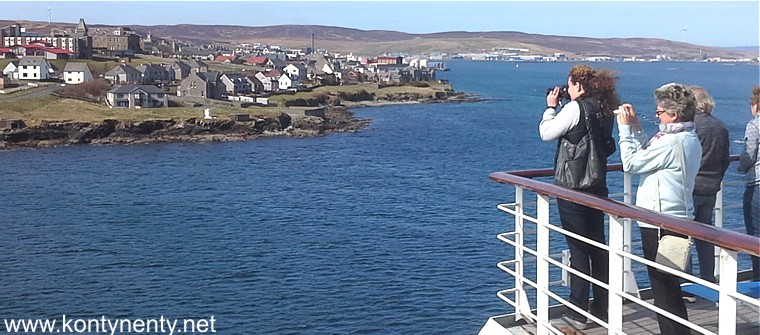
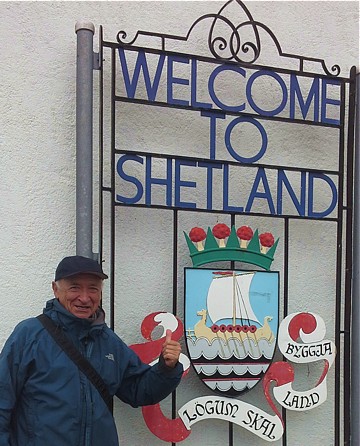
Następnego dnia dotarliśmy do portu Lerwick na Szetlandach - najbardziej wysuniętej na północ grupie brytyjskich wysp. Jak widać na zdjęciu powyżej była piękna pogoda i z pokładu mogliśmy podziwiać surowy krajobraz Szetlandów, pozbawiony zupełnie drzew. W miasteczku jest do zobaczenia niewielki Fort Charlotte z armatami na murach, a w portowym basenie pływają foki. Musiałem sobie zrobić pamiątkowe zdjęcie przy herbie Szetlandów.
On the next day we reached the port of Lerwick on the Shetland Islands - the northernmost group of British islands. As you can see in the picture above, the weather was beautiful and from the deck we could admire the raw Shetland landscape, deprived of trees altogether. There is a small Fort Charlotte in the town with cannons on the walls and seals are swimming in the port's dock. I had to take a souvenir photo at the coat of arms of Shetland.
Scotland also has islands. Going south, we then visited one of them - the Isle of Mull in the Hebrides. There are not many human settlements here, and the highlight of the island is the small, colorful town of Tobermory. There is no dock for big ships in Tobermory - we were transported from the ship to the village by motorboats:
Szkocja też ma wyspy. Płynąc na południe odwiedziliśmy potem jedną z nich - wyspę Mull w grupie Hebrydów. Niewiele tu ludzkich osad, a ozdobą wyspy jest niewielkie, kolorowe miasteczko Tobermory, schowane w niewielkiej zatoce. W malowniczym Tobermory nie ma przystani dla dużych statków - ze statku na ląd przewożono nas motorówkami:
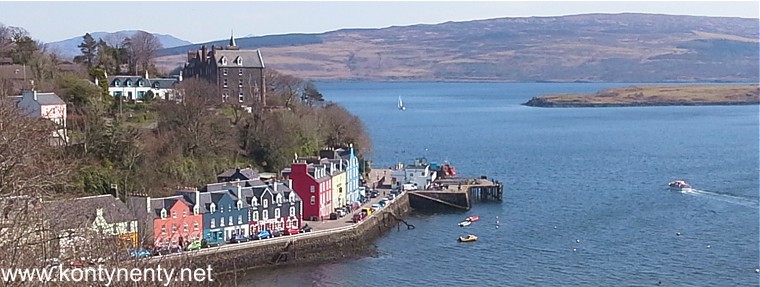
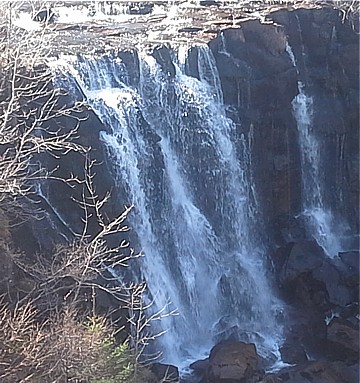
Z Tobermory zrobiłem sobie dwie piesze wycieczki. Trasa pierwszej wiodła do latarni morskiej zbudowanej na północ od miasta. Trasa ta oferuje piękne widoki - między innymi na zatokę i kotwiczące w niej statki (zdjęcie poniżej). Po powrocie do miasteczka skierowałem się na południe, gdzie w rezerwacie Aros znaleźć można kilka ładnych wodospadów, mających do kilkunastu metrów wysokości. Na zdjęciu obok jeden z nich - tzw. Upper Fall.
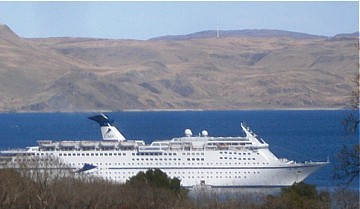
I made two hiking trips from Tobermory. The first route led to the lighthouse built north of the city. This route offers beautiful views - including the bay and anchoring ships (photo above). After returning to town, I headed south, where in the Aros reserve you can find several nice waterfalls, up to several meters high. In the picture on the left column one of them - the so-called Upper Fall.
Drugim szkockim portem, który odwiedziliśmy był Greenock, gdzie na nabrzeżu czekał na nas grający na kozie (kobzie) piper w tradycyjnej spódniczce z tartanu. Greenock jest niewielkim miasteczkiem będącym dla morskich turystów bazą wypadową dla wyjazdów do niedalekiego Glasgow - największego miasta Szkocji. Powrotny bilet autobusowy kosztuje 5,75 funta, a przejazd trwa 45 minut. W Glasgow najciekawszym obiektem jest wielka gotycka katedra z grobem Św. Mungo. Słyszeliście o takim świętym?. Poza tym na centralnym placu miasta - George Square budzi podziw wielki gmach giełdy handlowej.
The second Scottish port we visited was Greenock, where a piper in a traditional tartan skirt was waiting for us on the wharf (bagpipe). Greenock is a small tourist town for tourists visiting Glasgow. The return bus ticket costs 5.75 pounds, and the journey takes 45 minutes. In Glasgow, the most interesting object is the great Gothic cathedral with the tomb of Saint Mungo... Did you hear about such a saint? :)

Then we visited Belfast - the capital of Northern Ireland. This was my first stay in this part of Ireland. I was interested not so much in the city, but the opportunity to see the so-called Giant's Causeway - a great natural attraction that can be seen a hundred kilometers north of Belfast, on a very picturesque stretch of the coast. At the tourist information office in Belfast's main square they offer cheap trips to this place - cost £ 25 (on the ship it costs min. 59 £):
Potem odwiedziliśmy Belfast - stolicę Irlandii Północnej. Był to mój pierwszy pobyt w tej części Irlandii. Interesowało mnie nie tyle miasto, ale możliwość zobaczenia tzw. Grobli Olbrzyma - wielkiej atrakcji przyrodniczej którą można zobaczyć sto kilometrów na północ od Belfastu, na bardzo malowniczym odcinku wybrzeża. Pod biurem informacji turystycznej na głównym placu Belfastu oferują tanie wycieczki do tego miejsca - koszt to 25 funtów. Na statku oferują taką wycieczke za minimum 59 funtów:
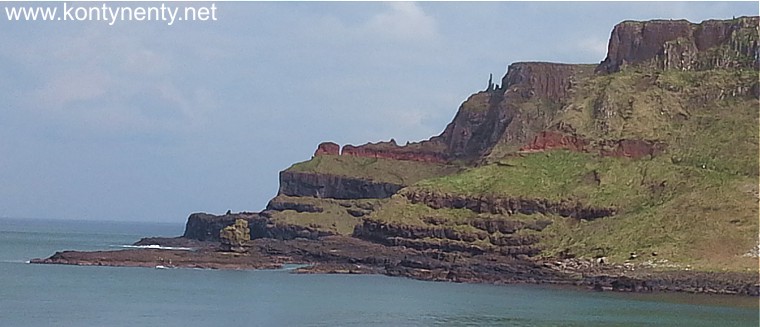
Giant's Causeway is placed on the UNESCO World Heritage list. Hexagonal
basalt columns are "stuck" vertically on the shore to the surface of the
earth. They were so bizarrely formed during the volcanic eruptions millions
years ago.
If you will not enter through the Visitor's Center but through the tunnel,
then the access to this attraction will be free for you - this option is
used by the majority of visitors :)
Grobla Olbrzyma umieszczona jest na liście World Heritage UNESCO. To sześciokątne bazaltowe kolumny "wbite" pionowo na brzegu w powierzchnię ziemi. Zostały one tak przedziwnie uformowane podczas wybuchu wulkanu miliony lat temu.
Jeżeli nie będziecie wchodzić prze Visitor's Center tylko przez tunel, to wstęp do tej atrakcji będzie dla was bezpłatny - z tego wariantu korzysta większość odwiedzających :)
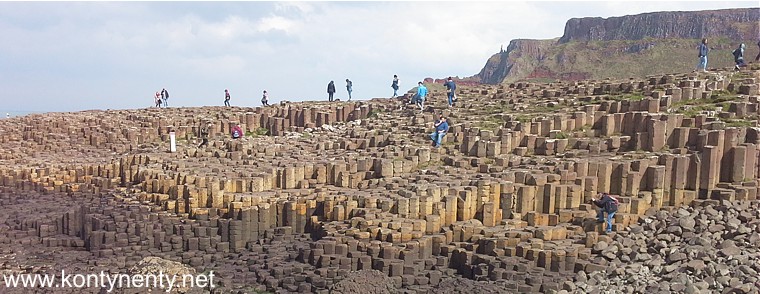
Numerous tourist routes have been led along the Irish mountainous coast. One of them leads to a rope bridge connecting the coast with a small island. They demand 8 pounds for the walk through the bridge. But I passed through many similar and much longer bridges in the Himalaya, so here I took only the pictures:
Wzdłuż irlandzkiego górzystego wybrzeża poprowadzono wiele szlaków turystycznych. Jeden z nich prowadzi do linowego mostu łączącego wybrzeże z niewielka wyspą. Za przejście po moście żądają 8 funtów. Ale ja przechodziłem przez wiele podobnych i znacznie dłuższych mostów w Himalajach, więc tutaj poprzestałem na zdjęciach:
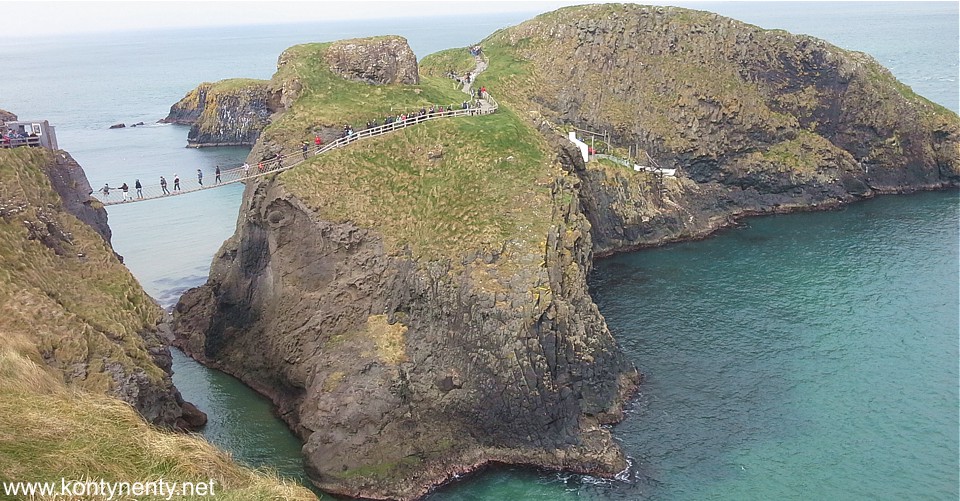
On our way back, we stopped at the Dark Hedges estate to see and photograph the avenue of amazing trees, in which, among other things, pictures of the movie "Game of Thrones" were taken. You admit that it makes an impression:
W powrotnej drodze zatrzymaliśmy się w posiadłości Dark Hedges, by obejrzeć i sfotografować aleję niesamowitych drzew - buków, w której wykonywano między innymi zdjęcia do filmu "Gra o tron". Buki posadzono w 1775 roku. Przyznacie, ze robi ona wrażenie:
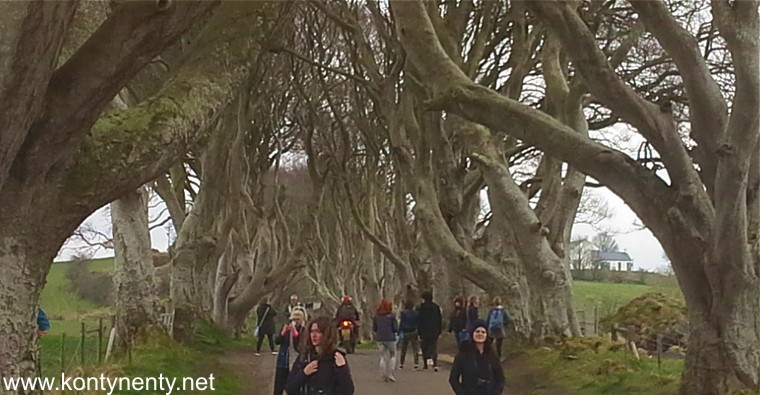
The next day, our ship arrived at the port of Cobh in the Republic of Ireland. The commuter train for 10 euros (return ticket) took me to visit Cork - the second largest city in Ireland that did not impress me - maybe because the weather was rainy. After returning to Cobh, I visited the interesting cathedral there - it impressed me more than the Cork churches. From the port of Cobh thousands of Irish emigrants were departing heading for America. "Titanic" also set out from this port on his last, tragic sail. On each anniversary of this event a group of ladies in fancy costumes appears here - they would like to have a photograph with me:
Kolejnego dnia nasz statek zawinął do portu Cobh w Republice Irlandii. Stąd pociągiem podmiejskim za 10 euro (bilet powrotny) pojechałem zwiedzić Cork - drugie co do wielkości miasto Irlandii, które mnie nie zachwyciło - może również dlatego, że pogoda była deszczowa. Po powrocie do Cobh zwiedziłem tamtejszą ciekawą katedrę - bardziej mi zaimponowała niż kościoły Cork. Z portu Cobh wyruszały statki z tysiącami irlandzkich emigrantów zmierzających do wymarzonej Ameryki. Stąd również wyruszył w swój ostatni, tragiczny rejs "Titanic". W każdą rocznicę tego wydarzenia pojawia się tutaj grupa pań w strojach z epoki - zechciały się ze mną sfotografować:
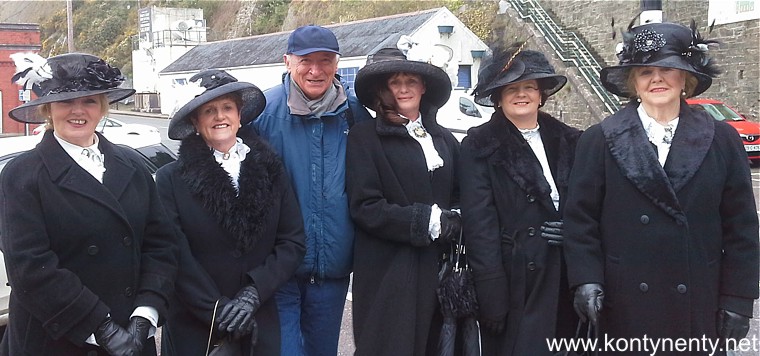
When on the next day we came to the entrance to the English Channel, it turned out that the rough sea - waves high up to 6 meters would prevent us from previously scheduled landings from motorboats on the Isles of Scilly and St. Peter Port on Guernsey. It happens. The captain offered us instead to visit the French port of Rouen on the Seine. The first time I was in Rouen in 1972. Now, once again, I had the opportunity to appreciate the size of the cathedral, which is the pride of the city:
Gdy następnego dnia znaleźliśmy się u wlotu do Kanału La Manche okazało się, że stan morza - fale wysokie na 6 metrów uniemożliwi nam planowane wcześniej lądowania z motorówek na Wyspach Scilly i w St. Peter Port na Guernsey. Tak bywa, większość pasażerów to byli ludzie w podeszłym wieku... Kapitan zaoferował nam w zamian odwiedzenie francuskiego portu Rouen na Sekwanie. Pierwszy raz byłem w Rouen w 1972 roku. Teraz raz jeszcze miałem okazje docenić rozmiary katedry, która jest ozdobą miasta:
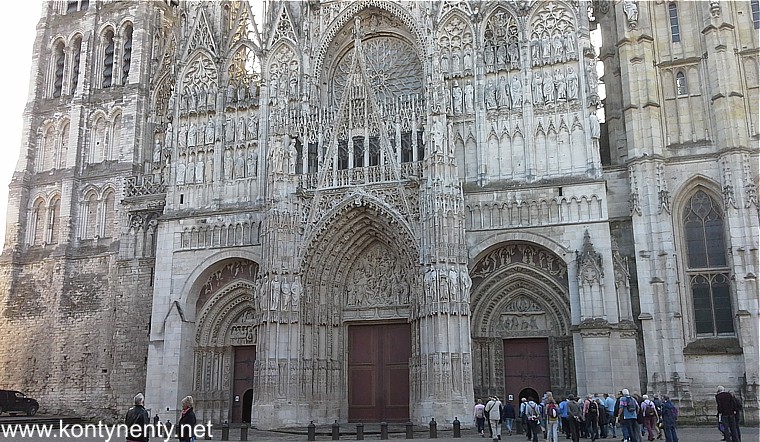
Another French port - Honfleur welcomed us with beautiful weather. The town is small but very picturesque - it was appreciated by, among others, painters - Impressionists. The old port, around which the restaurants and cafes spread out, seemed particularly romantic:
Inny francuski port - Honfleur powitał nas piękną pogodą. Miasteczko jest małe, ale bardzo malownicze - docenili to między innymi malarze - impresjoniści, którzy tu mieszkali i tworzyli. Szczególnie nastrojowy wydał mi się stary port, wokół którego rozłożyły się restauracje i kawiarnie:
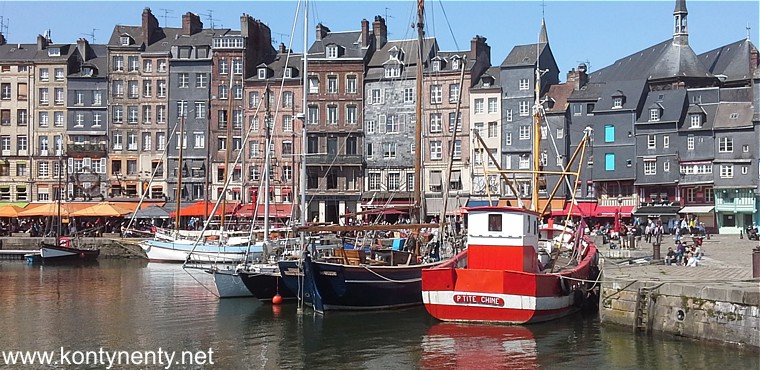
We returned from Honfleur to England to moor in the Tilbury harbor on the River Thames. From here, there are 45 kilometers to London. A budget traveler walks 1.5 km on foot from the terminal to Tilbury station, he buys a return ticket to London for £ 12 and after 45 minutes is already in the capital of Great Britain, next to the Tower castle. That day I walked around London about 20 kilometers on foot. It was nice to see again old, well-known places and to state that many new skyscrapers had arrived.
Z Honfleur zawróciliśmy do Anglii, by zacumować w porcie Tilbury na Tamizie. Stąd do Londynu jest jeszcze 45 kilometrów. Budżetowy podróżnik idzie 1,5 km pieszo z terminalu do stacji Tilbury, kupuje za 12 funtów powrotny bilet do Londynu i po 45 minutach jazdy jest już w stolicy Wielkiej Brytanii, tuż obok zamku Tower. Tego dnia zrobiłem piechotą po Londynie około 20 kilometrów. Rozpocząłem od katedry Św. Pawła i spaceru nad Tamizą. Miło było przypomnieć sobie stare, znane miejsca i stwierdzić, ze przybyło wiele nowych wieżowców.
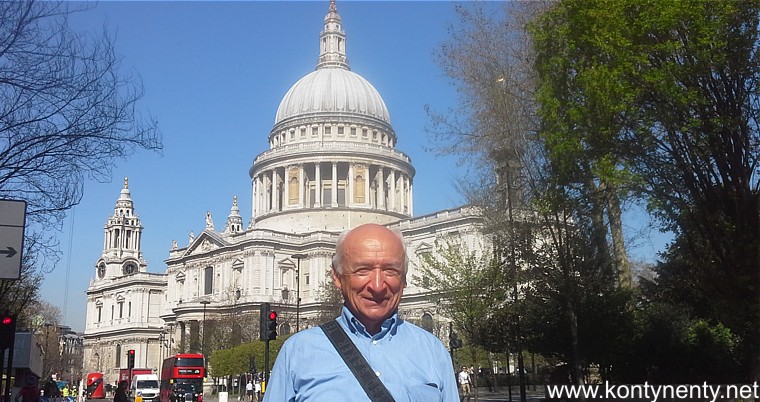
After 12 days of sailing, our ship returned to Amsterdam again. We said goodbye to him at 2 pm. And that the return flight to Gdansk was leaving only at 8 pm we had enough time to walk along the well-known channels of this city. Amsterdam enjoyed the eyes with fresh green. Crowds of tourists, thousands of bicycles, rows of historic tenement houses so similar to those of Gdańsk and churches towering above the buildings... In sunny weather it was worth to refresh the image of this beautiful city:
Po 12 dniach żeglugi nasz statek zawinął ponownie do Amsterdamu. Pożegnaliśmy go o godz. 14.00. A że powrotny samolot do Gdańska odlatywał dopiero o 20.00 to był czas na spacer wzdłuż dobrze znanych kanałów tego miasta. Amsterdam cieszył oczy świeżą zielenią. Tłumy turystów, tysiące rowerów, rzędy zabytkowych kamieniczek tak podobnych do tych gdańskich i wystające ponad zabudowę wieże kościołów... Przy słonecznej pogodzie warto było odświeżyć sobie obraz tego pięknego miasta:
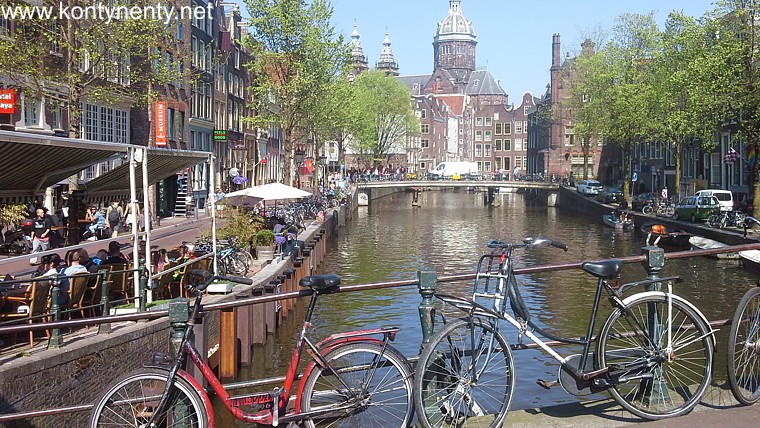
In May 2018 I returned from an interesting expedition to the East Tibet. Years ago a journalist asked me if I still have travel dreams after visiting all the countries of the world and twelve trips around the globe. I mentioned then that I dream of meeting with the imperial penguins and a land trip along the main range of the Himalaya from Yunan to Kashgar. I tried to deal with this second project many times, but the Chinese authorities have always refused to let me pass through Eastern Tibet. And this year, there is finally a hope for crossing the Chengdu section - Lhasa! The expedition began in Chengdu, where chairman Mao is still present in the main square:
W maju 2018 odbyłem ciekawą wyprawę do Wschodniego Tybetu. Kiedyś pewien dziennikarz zapytał mnie, czy po odwiedzeniu wszystkich krajów świata i dwunastu podróżach wokół globu mam jeszcze jakieś podróżnicze marzenia. Wspomniałem wtedy, że marzy mi się spotkanie z cesarskimi pingwinami oraz lądowa podróż wzdłuż głównego pasma Himalajów od Yunanu do Kaszgaru. Wiele razy próbowałem zmierzyć się z tym drugim projektem, ale zawsze chińskie władze odmawiały mi zezwolenia na przejazd przez Wschodni Tybet. I oto w tym roku zaświtała w końcu nadzieja na przejechanie odcinka Chengdu - Lhasa! Ekspedycja zaczęła się w Chengdu, gdzie na głównym placu wciąż stoi przewodniczący Mao:
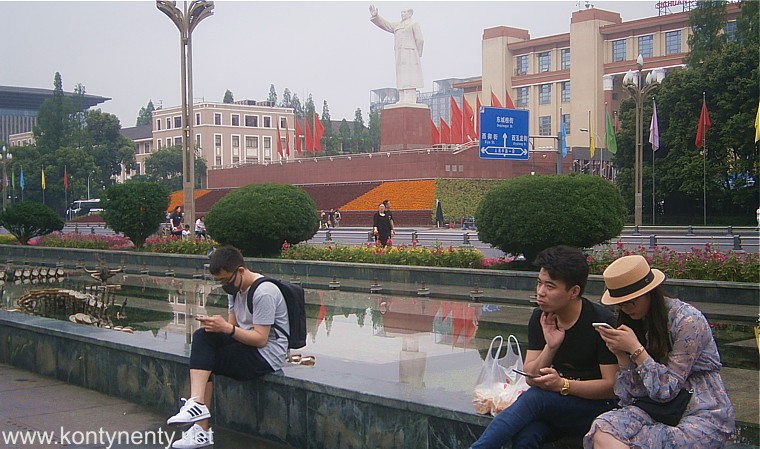
On the next day, along with three other travelers, we set off west on the famous G318 National Highway. High mountains quickly appeared in the landscape. We drove through numerous viaducts and tunnels, the longest of which was the Erlangshan Tunnel, which is 8,600 meters long. The Chinese are still improving this road, near Luding a record high bridge is suspended 235 m above the Dadu River. Its span is 1100 meters long. We admired him from the special terrace:
Następnego dnia razem z trójką innych podróżników wyruszyliśmy samochodem na zachód słynną szosą G318. Szybko w krajobrazie pojawiły się wysokie góry. Jechaliśmy przez liczne wiadukty i tunele, z których najdłuższy był Erlangshan Tunel, mający 8600 metrów długości. Chińczycy wciąż ulepszają tę drogę, koło Ludingu powstaje rekordowo wysoki most zawieszony 235 m nad rzeką Dadu. Jego przęsło ma 1100 metrów długości. Podziwialiśmy go ze specjalnego tarasu:
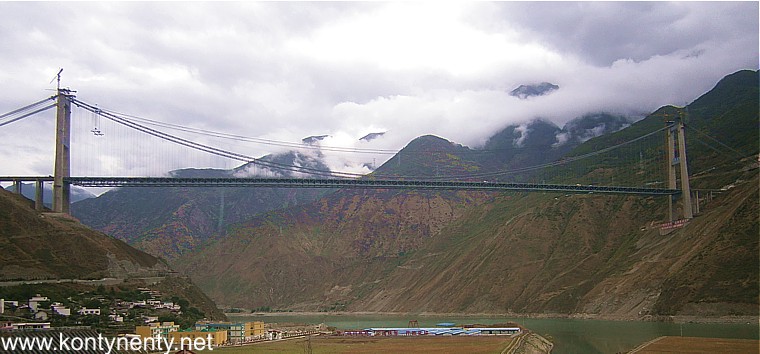
Two hours later, we arrived at Kangding, a village squeezed in the deep mountain valley. Above him, on the hillside, the roofs of the restored Tibetan gompa gilded. The temple was closed, but we had a great view of the city and the surrounding mountains from here:
W dwie godziny później dotarliśmy do wciśniętego w głęboką górską dolinę kuracyjnego miasteczka Kangding. Ponad nim na zboczu złociły się dachy odrestaurowanej tybetańskiej gompy. Świątynia wprawdzie była zamknięta, ale mieliśmy stąd świetny widok na miasto i okoliczne góry:
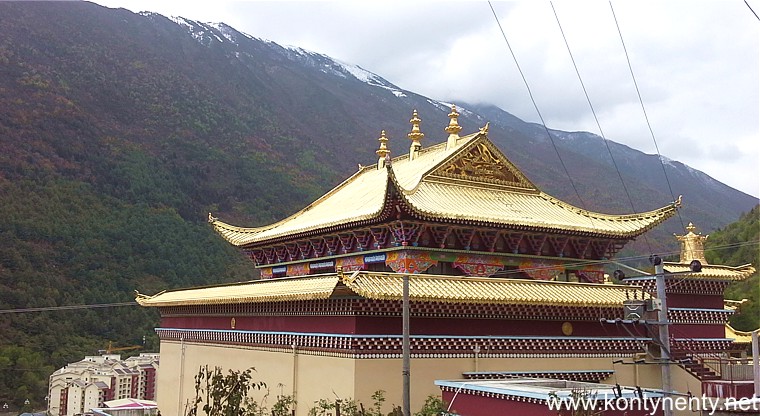
After leaving the city we began climbing to the Zheduo Pass - 4298 m above sea level. There was still snow on the pass in May, and even continued to fall. We stopped there, however, for a quarter of an hour, just like the others, to photograph ourselves at the white Tibetan chorten built there. There was a humming in my head:
Po wyjeździe z miasta rozpoczęła się wspinaczka na przełęcz Zheduo - 4298 m npm. Na przełęczy w maju leżał jeszcze śnieg, a nawet w dalszym ciągu popadywał. Zatrzymaliśmy się tu jednak na kwadrans, by podobnie jak inni sfotografować się przy wzniesionych tu białych, tybetańskich czortenach. W głowie mi szumiało ze względu na brak aklimatyzacji do takiej wysokości:
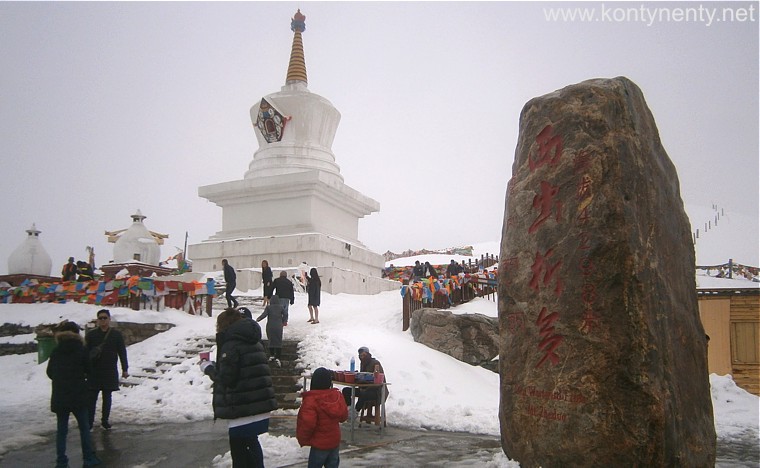
We spent the night in a primitive hotel in Xinduqiao, at kilometer 2916 of the legendary G318, which runs from Shanghai, through Lhasa to the border crossing of Tibet - Nepal in Zhangmu. When I was ordering this trip, the Chinese agency promised to ensure that the road traveled to Lhasa. The matter was complicated when they applied to the authorities for permission to transit foreigners through East Tibet ...
Noc spędziliśmy w prymitywnym hoteliku w Xinduqiao, na kilometrze 2916 legendarnej szosy G318, która biegnie z Szanghaju, przez Lhasę do przejścia granicznego Tybet - Nepal w Zhangmu. Kiedy zamawiałem tę wycieczkę chińska agencja obiecała zapewnić przejazd tą szosą aż do Lhasy. Sprawa się skomplikowała, gdy wystąpili do władz o zezwolenie na przejazd cudzoziemców przez Wschodni Tybet...
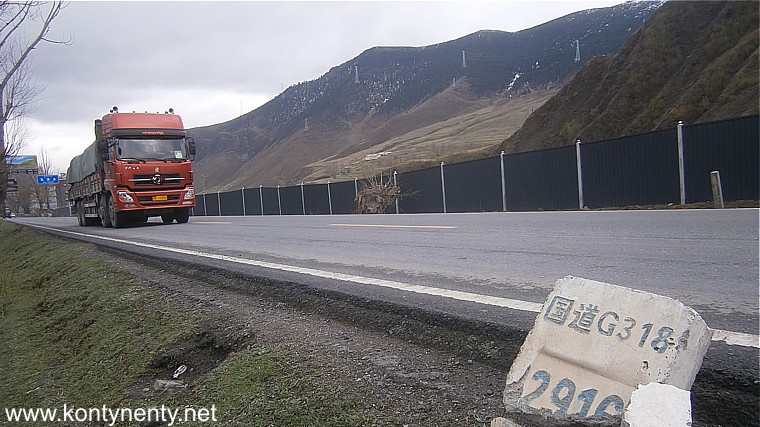
The next day, at kilometer 2922, we had to temporarily say goodbye to our G318. We turned right, in S215. We were still in the circle of Tibetan culture and religion as it was evidenced by the lines of prayer flags and inscriptions in the Tibetan alphabet carved on the rocks above the mountain river:
Następnego dnia, na kilometrze 2922 musieliśmy chwilowo pożegnać naszą szosę G318. Skręciliśmy w prawo, w S215. Pozostawaliśmy wciąż w kręgu kultury i religii tybetańskiej o czym świadczyły sznury modlitewnych chorągiewek i napisy w tybetańskim alfabecie wyryte na głazach nad górską rzeką:
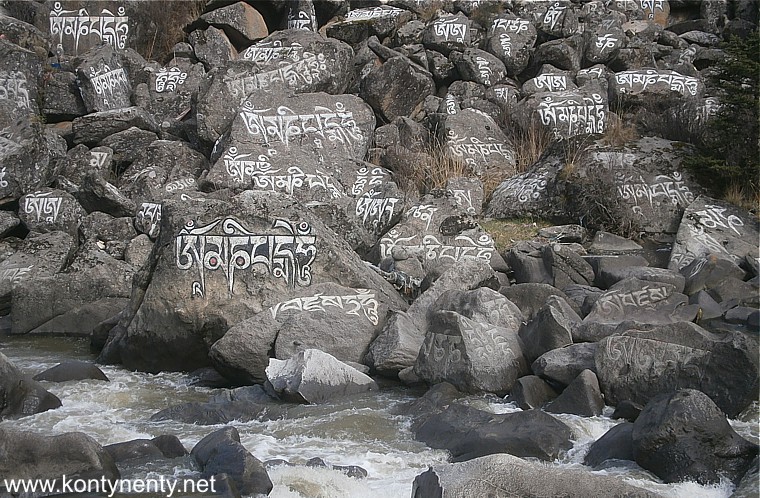
These inscriptions heralded that we are approaching an important place of worship. And indeed - we soon got to the nice town of Batang where you can find many examples of Tibetan architecture. The most important object in Batang (3700 m above the sea) is the Tibetan monastery of Lhagang, which is a destination for many pilgrims:
Te napisy zwiastowały, że zbliżamy się do ważnego miejsca kultu. I rzeczywiście - wkrótce dotarliśmy do ładnego miasteczka Batang w którym można znaleźć wiele przykładów tybetańskiej architektury. Najważniejszym obiektem w Batangu, leżcym na wysokości 3700 m jest tybetański klasztor Lhagang, będący celem wędrówki wielu pielgrzymów:
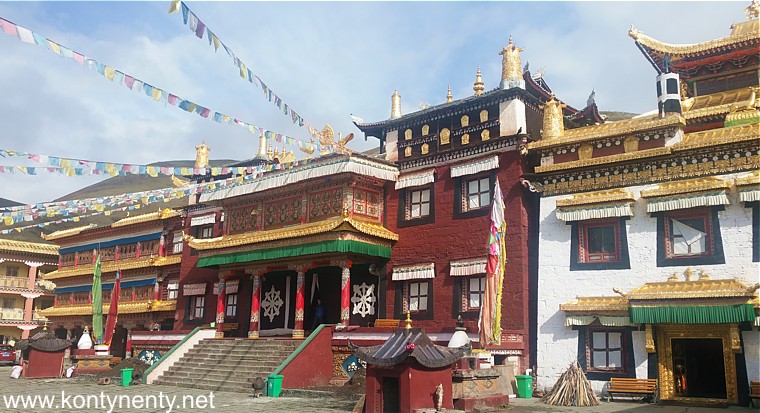
On the same day, driving interior roads, in many places washed by mountain rivers, we reached the Tibetan village of Jiaji, picturesquely situated on the slope above the river. The Chinese travel magazine placed it on the list of the six most beautiful Chinese villages. For good reason. A stone-built watchtower dominates the village:
Jeszcze tego samego dnia podrzędnymi drogami w wielu miejscach podmytymi przez górskie rzeki dotarliśmy do tybetańskiej wioski Jiaji rozłożonej malowniczo na zboczu ponad rzeką. Chiński magazyn turystyczny umieścił ją na liście 6 najpiękniejszych chińskich wsi. Nie bez powodu. Nad wioską dominowała wzniesiona z kamienia forteczka - watchtower:
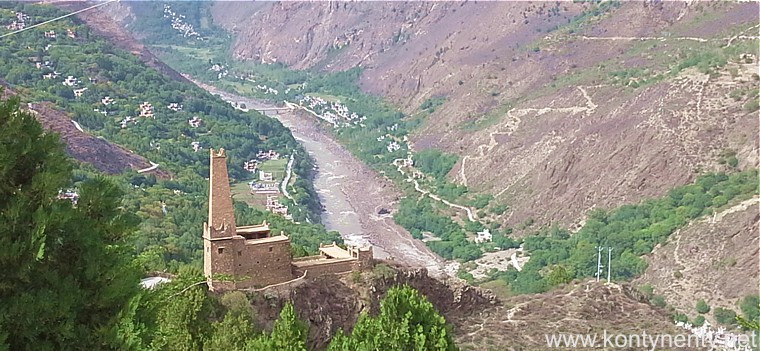
The next day passed us on a ride through high mountains, whose most beautiful fragment was a ridge with four peaks - these were the Four Sisters. We were lucky for the weather that day:
Dzień następny upłynął nam na jeździe przez wysokie góry, których najpiękniejszym fragmentem był grzbiet z czterema szczytami - to były Cztery Siostry. Mieliśmy tego dnia szczęście do pogody - niebo było błękitne, a widoczność znakomita:
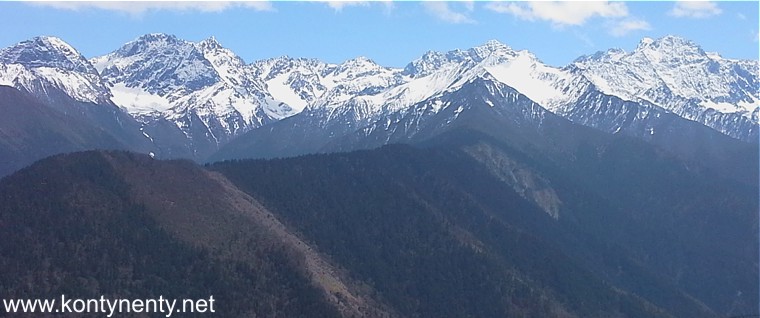
The Chinese agency that received us behaved very decently - in the absence of the permission granted by the authorities to cross overland a large section of the G318 highway, they bought tickets for our flight over the "forbidden" zone. We landed at the little-known Nyingchi airport, located between snow-capped mountain peaks. Landing conditions are very difficult here. Only 4 deg. Celsius on the ground. On the way we were almost touching snowy peaks:
Chińska agencja, która nas przyjmowała zachowała się bardzo przyzwoicie - wobec nie udzielenia przez władze zezwolenia na przejazd lądem znacznego odcinka szosy G318 zakupiła nam na swój koszt bilety na przelot ponad "zakazaną" strefą. Wylądowaliśmy na mało znanym lotnisku Nyingchi, położonym między ośnieżonymi górskimi szczytami. Warunki lądowania są tu bardzo trudne, ale jakoś poszło! Tylko 4 stopnie Celsiusa. Po drodze lecieliśmy tuż nad ośnieżonymi szczytami:
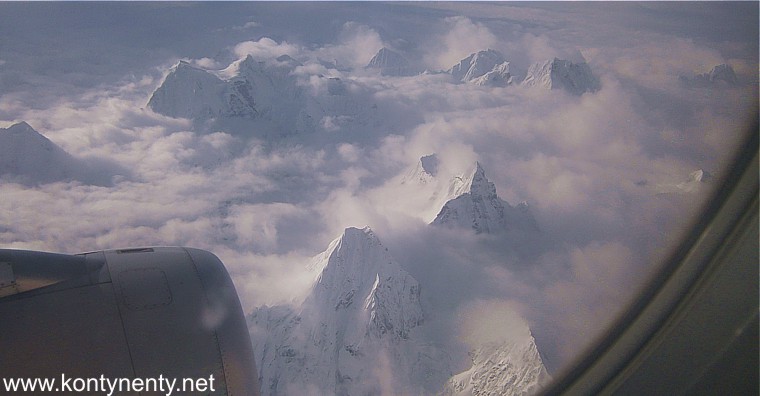
After meticulously registering our permits we boarded a new car, and moved with the new driver to the east. The airport was at an altitude of 2,900 m, and soon we were to climb the Sekim La Pass at an altitude of 4600 m. On the way, we admired the mountain panoramas, but the snow-covered mountain itself was not very impressive. In Tibet, there are cords of prayer flags hanging in such places. In my head it was again buzzing and the breathing became short:
Po skrupulatnym zarejestrowaniu naszych permitów nowym samochodem, z nowym kierowcą ruszyliśmy na wschód. Lotnisko było na wysokości 2900 m, a wkrótce przyszło się nam wspinać na przełęcz Sekim La na wysokości 4600 m. Po drodze podziwialiśmy górskie panoramy, ale samo przełęcz, pokryta śniegiem nie była zbyt efektowna. W Tybecie w takich miejscach rozwieszone są sznury modlitewnych chorągiewek. W głowie znowu szumiało, a oddech stał się krótki:
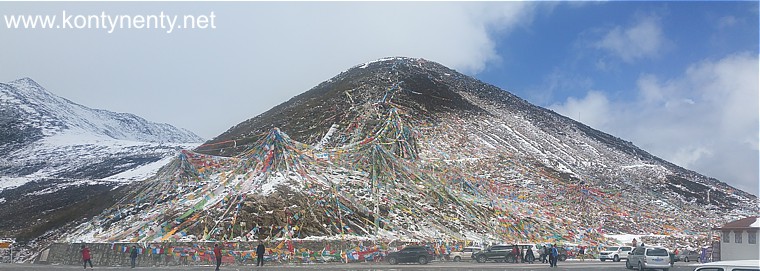
The Chinese driver stopped at our every request. When we came down from the pass into the valley, I asked him to stand by when passing Tibetan temple. I met in it very nice monks, the silence and the extraordinary atmosphere of the old monastery:
Chiński kierowca zatrzymywał się na każdą naszą prośbę. Gdy zjechaliśmy z przełęczy w dolinę poprosiłem, by stanął przy mijanej tybetańskiej świątyni. Spotkałem w niej bardzo sympatycznych mnichów, ciszę i niezwykłą atmosferę starego klasztoru:
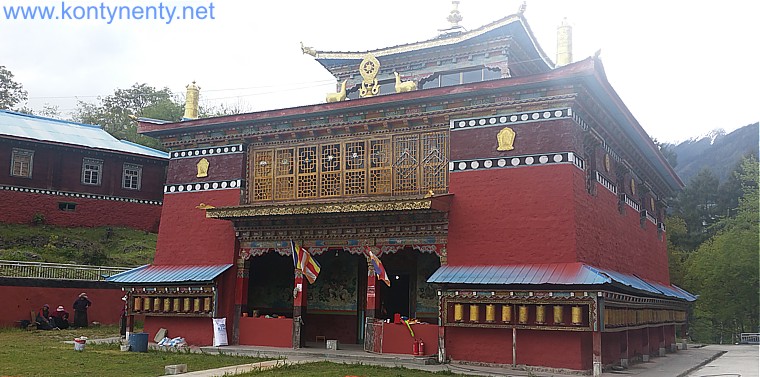
After the night spent in a small hotel (for breakfast, like everywhere in China - a rice soup, steamed buns and boiled eggs - yes, you can survive!) we moved further east to reach the mountain lake Ranwu, famous for its beauty:
Po nocy spędzonej w podrzędnym hoteliku (na śniadanie jak wszędzie - ryżowa zupka, buły na parze i gotowane jajka - da się przeżyć) ruszyliśmy dalej na wschód, by dotrzeć wkrótce do słynącego z urody górskiego jeziora Ranwu:
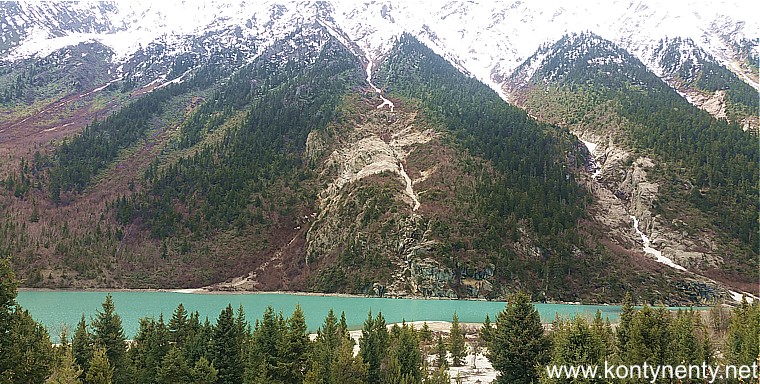
In the vicinity of this lake are two large glaciers: Laigu and Mitoi. In order to reach the lake at the foot of the glacier in both cases it is necessary to walk several dozen minutes, which requires some effort at this altitude. But it is worth! Of the two, I liked the Mitoi Glacier more:
W sąsiedztwie tego jeziora są dwa duże lodowce: Laigu i Mitoi. Aby dojść do jeziora u podnóża lodowca w obu przypadkach konieczne jest kilkadziesiąt minut marszu, co na tej wysokości wymaga nieco wysiłku. Ale warto! Z tych dwóch bardziej podobał mi się Lodowiec Mitoi:
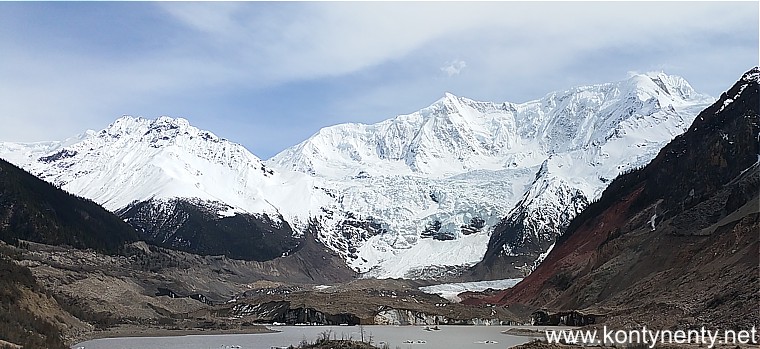
Somewhere here we have reached kilometer 3879 of the famous G318 highway. 3879 minus 2922 is 957 km - this was the length of the section of this road forbidden to us by the Chinese authorities. The length of this highway between Chengdu and Lhasa is 2144 km. Therefore, the administration has pushed us to fly almost the half of the planned route. However, side trips have come... The real plague of East Tibet's roads are whole families of black pigs roaming on the road. You can meet some yaks and cows as well, but those have more respect for the passing car:
Gdzieś tutaj osiągnęliśmy kilometr 3879 słynnej szosy G318. 3879 minus 2922 to 957 km - taka była długość odcinka tej szosy zabronionego przez chińskie władze. Długość tej szosy między Chengdu i Lhasą to 2144 km. Administracja zamieniła nam zatem na przelot samolotem blisko połowę zaplanowanej trasy. Doszły jednak za to boczne odcinki... Może Wam się uda przebyć tę trasę w całości? Prawdziwą plagą dróg Wschodniego Tybetu są całe rodziny czarnych świń wałęsające się na szosach. Spotkać można także jaki i zwykłe krowy, ale te mają więcej respektu dla przejeżdżającego samochodu:
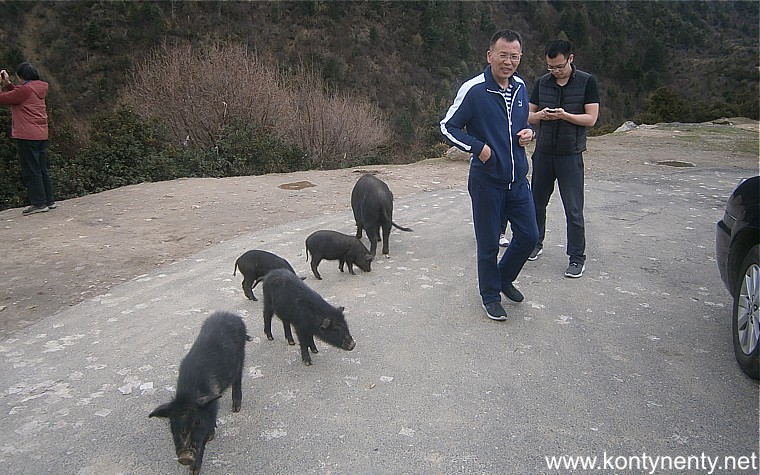
We turned back to the west. We were accompanied by mountain rivers with hanging bridges, numerous tunnels and really fabulous landscapes. Eastern Tibet turned out to be completely different than the central part that I traveled in 1987. There, nature was modest and raw. Here, the lush green of high forests, canyons, foamy rivers reigned... It was a nice surprise for me:
Zawróciliśmy na zachód. Towarzyszyły nam górskie rzeki z rozwieszonymi wiszącymi mostami, liczne tunele i naprawdę bajeczne krajobrazy. Wschodni Tybet okazał się zupełnie inny, niż ten centralny, który przemierzyłem w 1987 roku. Tam przyroda była skromna i surowa. Tu zaś, w części kraju praktycznie nieznanej zagranicznym turystom królowała bujna zieleń wysokich lasów, kaniony, spienione rzeki... To było dla mnie miłe zaskoczenie:
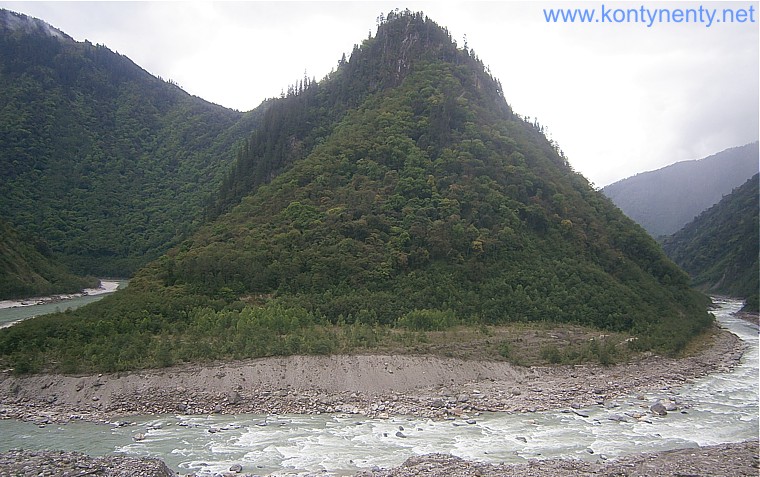
On the further route to Lhasa, we defeated one more high pass - Mila Pass at an altitude of 5013 meters above sea level. Here we set the road record for the height of this trip. It was May 8th but here everything was still covered by snow. We experienced great sunny weather and the view from the pass was just sensational:
Na dalszej trasie do Lhasy pokonaliśmy jeszcze jedną wysoką przełęcz - Mila Pass na wysokości 5013 metrów npm. Tu ustanowiliśmy drogowy rekord wysokości tej wyprawy. Był dzień 8 maja, a tu wszystko dookoła pokryte było jeszcze śniegiem. Trafiliśmy na wspaniałą, słoneczna pogodę i widok z przełęczy był rewelacyjny:
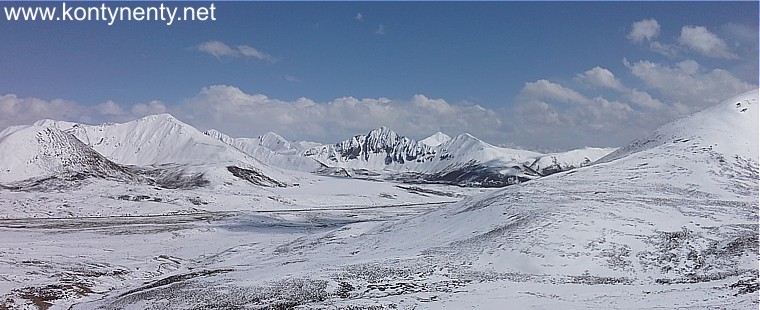
Lhasa, watched again after 31 years, surprised me with a completely different landscape. I visited again the famous Tibetan monasteries and Potala - the winter palace of the Dalai Lama. The monasteries have changed little. But on the streets there were shops with mirrored windows, and in front of Potala a magnificent monument of the "liberators of Tibet" was built with a dancing fountain launched after dark. The Potala itself is splendidly illuminated in the evening:
Lhasa, oglądana ponownie po 31 latach zaskoczyła mnie zupełnie odmiennym krajobrazem. Zwiedzałem ponownie słynne tybetańskie klasztory i Potale - zimowy pałac dalajlamy. W klasztorach niewiele się zmieniło. Ale na ulicach przybyły sklepy o lustrzanych witrynach, a naprzeciw Potali wybudowano okazały pomnik "wyzwolicieli Tybetu" (chyba wiecie kto "wyzwolił" Tybet?) z uruchamianą po zmroku tańczącą fontanną. Sama zaś Potala wieczorem jest wspaniale iluminowana:
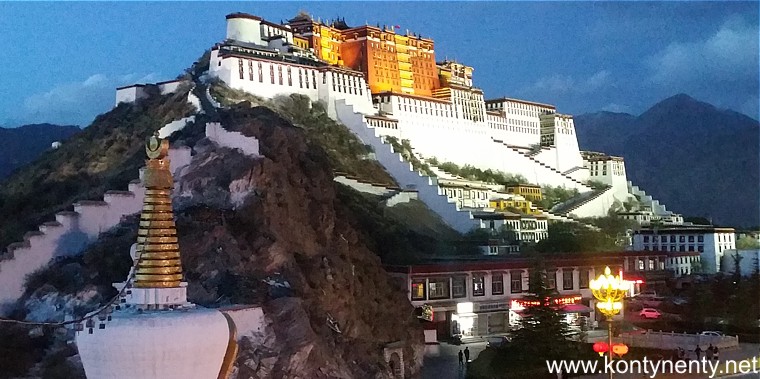
But for me it was even more interesting to meet people around the Jokhang temple, filling the streets of Bakhor Bazar, sitting in front of the gates of Tibetan monasteries. These people are very nice here. And the difference is easy to see when you will go down from the Tibetan Plateau, called the Roof of the World, to the lowlands of China ...
Ale dla mnie jeszcze ciekawsze były spotkania z ludźmi, krążącymi wokół świątyni Jokhang, wypełniającymi uliczki Bakhor Bazar, siedzącymi przed bramami tybetańskich klasztorów. Ci ludzie są tu bardzo sympatyczni. A różnicę łatwo się dostrzega, gdy potem zjedzie się z Tybetańskiego Płaskowyżu, nazywanego Dachem Świata na dół - do Chin...
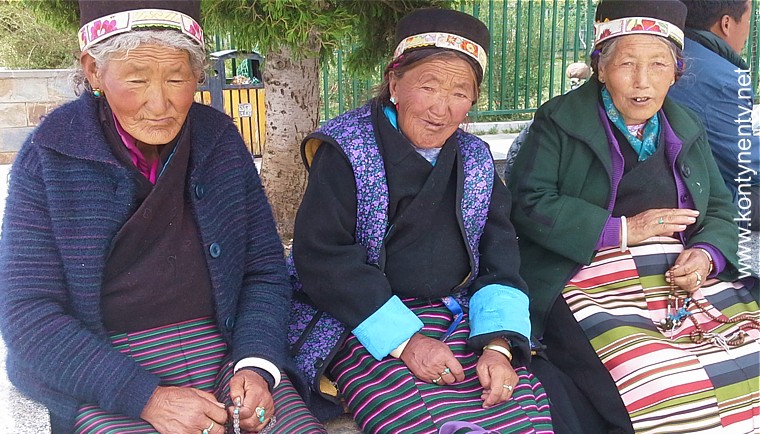
From the capital of Tibet, I intended to go on the transtibetan railway to Lanzhou in Gansu Province. When in 1987 I was for the first time in Tibet, this railway did not exist... Traveling now the highest railway in the world was an additional attraction of this trip. Let me remind you that just recently the primacy in this field was held by the Andean railway designed by Ernest Malinowski - I rode it in 1984. I to not eas to get the tickets for this train. We started from Lhasa station at 9 am.
Ze stolicy Tybetu chciałem wrócić koleją transtybetańską - do Lanzhou w prowincji Gansu. Kiedy po raz pierwszy w 1987 roku byłem w Tybecie ta kolej jeszcze nie istniała... Przejazd najwyższą obecnie koleją świata był więc dodatkową atrakcją tej podróży. Przypomnę, że jeszcze niedawno prymat w tej dziedzinie dzierżyła andyjska kolej zaprojektowana przez Ernesta Malinowskiego - jechałem nią w 1984 roku. Nie jest łatwo o bilety na ten pociąg, ale załatwiła nam je chińska agencja. Ze stacji Lhasa ruszyliśmy o 9.00
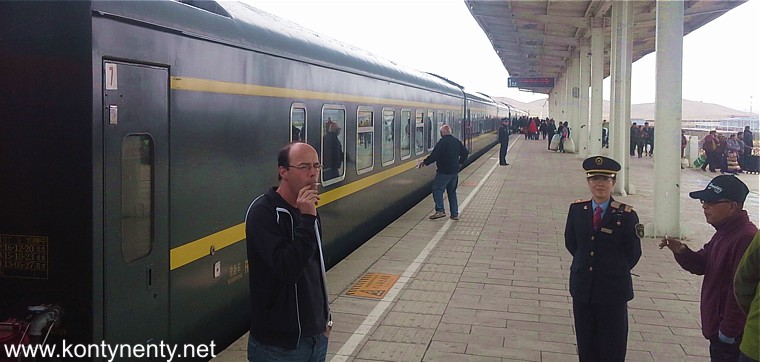
Sorry, this famous train is disappointing... Except the big, panoramic windows I was not impressed. They do not offer any soap or towel. You must bring your own toilet paper. There is one European toilet in the car but for some stupid reason they are closing it on every station. Yes - there is an individual screen for every berth, but they do not offer ANY program. There is a hot water distibutor in each car but the offered water is only warm, so your tea or coffee has no full value... The conductor is rather rude and does not speak any English. They do not give ANY announcements through the loudspeakers and any form of the timetable is available.
Przepraszam, ale ten słynny pociąg mnie rozczarował. Poza panoramicznym oknem i nadmuchem powietrza wzbogaconego tlenem nie było tu nic rewelacyjnego. W sypialnym wagonie nie dawali ani mydła, ani ręcznika, nie było papieru toaletowego. W wagonie jest jedna "europejska" próżniowa toaleta, ale z jakiegoś durnego powodu zamykali ją na każdej stacji. Nad każdym łóżkiem jest ekranik, ale nie oferują żadnego programu. W każdym wagonie jest samowar, ale leci z niego tylko ciepła, a nie gorąca woda. Konduktorka trafiła się nam niezbyt grzeczna, nie znała ani słowa po angielsku. Przez system głośników nie nadawali żadnych komunikatow. Rozkład jazdy był nieosiągalny.
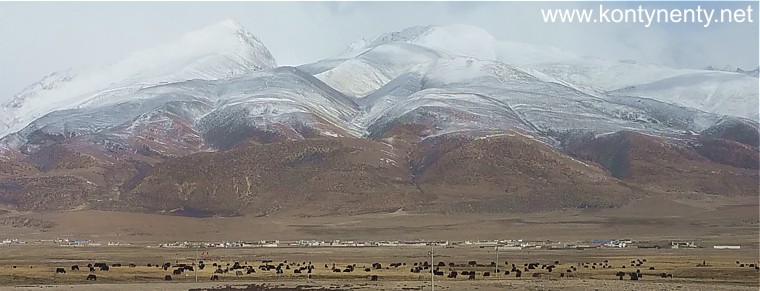
But I must honestly say that I spent a great day going through the Roof of the World, enjoing sunny wearher and the landscapes of the snowy mountains, pastures with thousands of black yaks (see the picture above), remote settlements. A pleasant surprise was a view of the Co Nag Lake:
Ale muszę uczciwie powiedzieć, że spędziłem w tym pociągu fantastyczny dzień jadąc po "Dachu Świata" przy słonecznej pogodzie, ciesząc oczy krajobrazami ośnieżonych gór, pastwisk z tysiącami czarnych jaków (na zdjęciu powyżej) i zagubionych osiedli. Miłym zaskoczeniem był widok jeziora Co Nag:
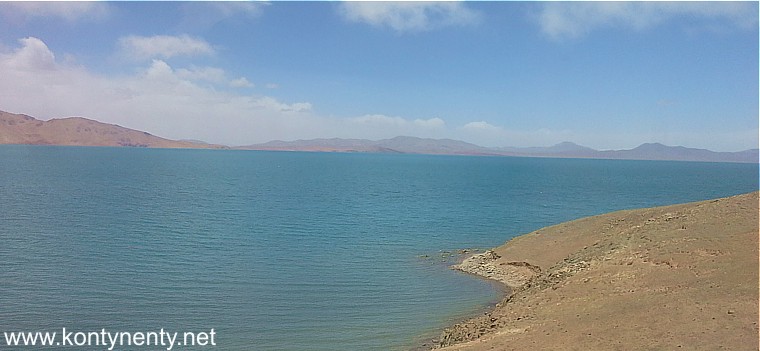
It was 3.40 pm
when we passed little and completely deserted Tanggula station - the highest
Railway Station in the world on the level 5068 m. Why they do not stop here
or just slow down for the pictures? Chinese are not proud of their
record?
Then we started the slow descend, but still riding on the level 4500 - 4600
m - till the evening. I saw many wild donkeys an Tibetan antelopes... And
the long chain of lorries climbing up the parallel road G109 to Tibet...
Była godzina 15.40 gdy bez zatrzymywania minęliśmy maleńką i kompletnie pustą stację Tanggula - najwyżej położoną stację kolejową świata (poziom 5068 m npn). Dlaczego nie zatrzymują tu pociągi - chośby dla zdjęć? Czy Chińczycy nie są dumni ze swego rekordu? Potem zaczęliśmy stopniowo zjeżdżać w dół, jadąc jednak wciąż na poziomie 4500 - 4600 m - aż do wieczora. Widziałem z okna wiele dzikich osłów i tybetańskie antylopy. I długi łańcuch wyładowanych ciężarówek wspinających się szosą G109 do Tybetu...
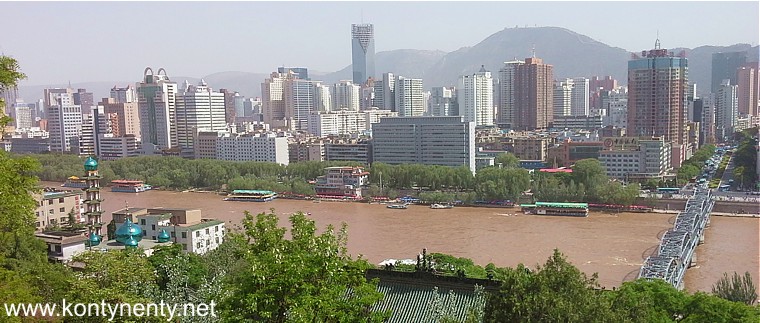
I got off the train in the big city of Lanzhou on the Yellow River (Huang Ho) - see picture above. Seeing all the interesting places is enough here for half a day, so I decided to use the time for a trip to the Tibetan monastery Labrang in Xiahe, 240 km away. This is a very interesting and large monastery, where there are currently around 1200 monks:
Z legendarnego pociągu wysiadłem w wielkim mieście Lanzhou nad Żółtą Rzeką (Huang Ho) - zdjęcie powyżej. Na zobaczenie wszystkich ciekawych miejsc wystarczy tu pół dnia, dlatego postanowiłem wykorzystać czas na wycieczkę do tybetańskiego klasztoru Labrang w Xiahe, odległego o 240 km. To bardzo ciekawy i duży klasztor, gdzie mieszka obecnie około 1200 mnichów:
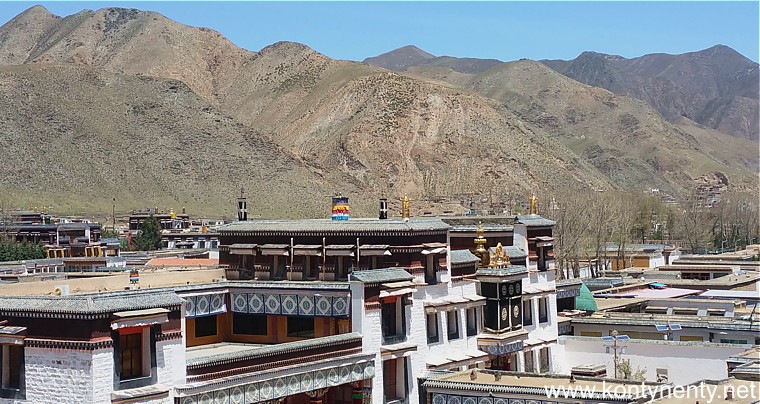
The next train
took me to Chengdu, and from there I returned by plane to Poland. It was a
great, pioneering expedition, which deserves a more extensive report - I
hope it will soon be created. For now, hot news and photos from this tour
can be found in my
in my travel log
Kolejnym pociągiem pojechałem do Chengdu, a stamtąd samolotem wróciłem do Polski. To była wspaniała, pionierska wyprawa, która zasługuję na obszerniejszą relację - mam nadzieję, ze taka wkrótce powstanie. Na razie pisane na gorąco wiadomości i fotki z tej trasy znajdziecie w moim dzienniku podróży
At the end of May 2018 I flew to Bucharest and Sofia for free, to see how these capitals look 41 years after my last visit. And to see something new on the occasion. Where do I get these free tickets from? The Booking.com website has systematically paid to my account at Wizzair 10% of the value of each accommodation booked through them. Well, I collected enough for free tickets... It was a short, relaxing trip... Something that was not there before in Bucharest is a monstrous public building erected at the time of Nicolae Ceausescu. Apparently, only gives way the size of the Pentagon:
W końcu maja 2018 poleciałem za darmo do Bukaresztu i Sofii, by sprawdzić, jak te stolice wyglądają po 41 latach od mojej ostatniej wizyty i przy okazji zobaczyć coś nowego. Skąd te bezpłatne bilety? Portal Booking.com systematycznie odprowadzał na moje konto w Wizzair po 10 % wartości każdego rezerwowanego za ich pośrednictwem noclegu. No i nazbierało się na bezpłatne bilety... Za pół roku te zgromadzone środki by przepadły. To była krótka, relaksowa podróż... Czymś, czego nie było przedtem w Bukareszcie jest monstrualny budynek publiczny wzniesiony w czasach Nicolae Ceausescu. Podobno ustępuje wielkością tylko Pentagonowi:
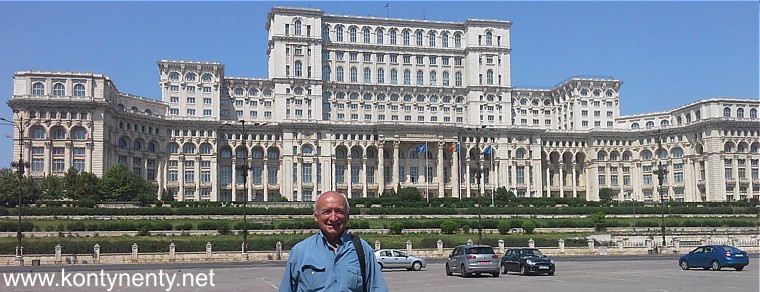
Jak zawsze podczas moich podróży nie tylko zwiedzałem turystyczne atrakcje, ale szukałem także kontaktu z ludźmi. Coraz więcej, szczególnie młodych ludzi mówi tu po angielsku. Ale spotkać na ulicy kogoś, kto jak na przykład na Ukrainie nosi ludowy strój jest niezwykle trudno. Udało mi się to właściwie tylko raz - koło ortodoksyjnej katedry w Bukareszcie. Popatrzcie na zdjęcie obok - zauważyłem, że te panienki do ludowego stroju nosiły pantofelki na wysokich obcasach :)
As always during my travels, I not only visited tourist attractions, but also looked for contact with people. More and more, especially young people, speak English here. But meet someone on the street who, like in Ukraine, wears folk outfits is extremely difficult. I did it only once - near the orthodox cathedral in Bucharest. See the picture on the right column:
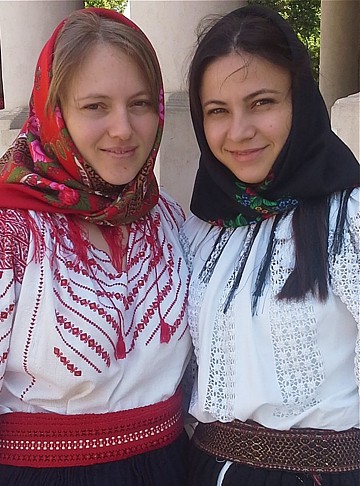
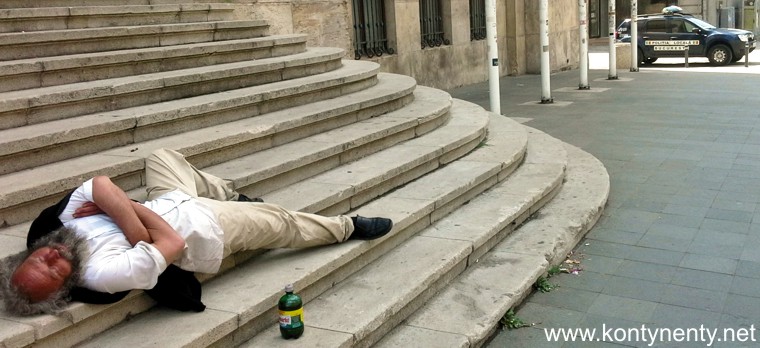
Freedom and individual rights are sometimes used here in a caricatural form. Such a drunken gentleman slept in the city center on the stairs of the historical museum. And a dozen yards away a police car was standing...
Wolność i prawa jednostki wykorzystywane są tu czasami w sposób karykaturalny. Taki podpity jegomość spał w centrum miasta na schodach muzeum historycznego. A kilkanaście metrów dalej stał policyjny samochód...
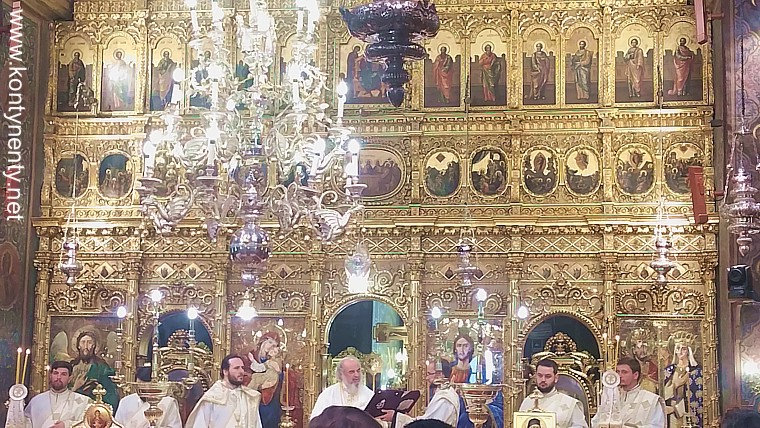
In Bucharest, the ornate interiors of Orthodox churches made the most impression on me, especially when they were filled with faithful and prayerful singing - on the photo above you see the interior of the cathedral.
Then I traveled from Bucharest to the historic Brasov, the capital of the district, and I have to confess that I liked this city more than the capital of Romania. It is very beautifully located and has a nice Old Town:
W Bukareszcie największe wrażenie zrobiły na mnie wspaniale zdobione wnętrza prawosławnych kościołów, szczególnie wtedy, gdy wypełnione były wiernymi i modlitewnym śpiewem - na zdjęciu powyżej interior katedry.
Z Bukaresztu pojechałem koleją do historycznego Braszowa - stolicy okręgu i musze wyznać, że miasto to podobało mi się bardziej od stolicy Rumunii. Jest bardzo pięknie położone i ma ładną Starówkę. A za murami rzuca się w oczy słynny Czarny Kościół:
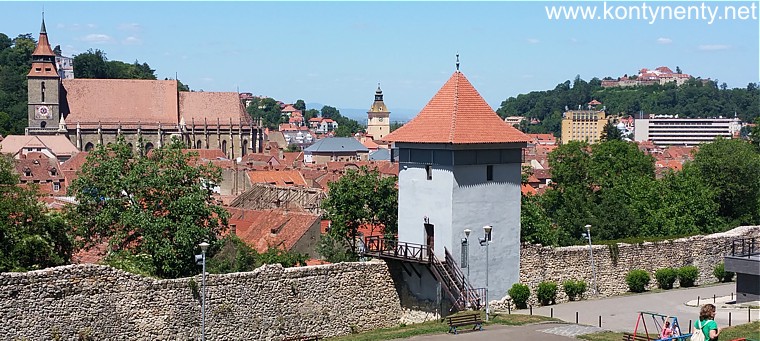
I made two half-day trips from Brasov. The first allowed me to visit the medieval castle Bran (picture on the right column). It is known in the literature as the seat of a vampire - Dracula. Bran is very picturesque and has interesting interiors, but I was surprised by the small size of this castle.
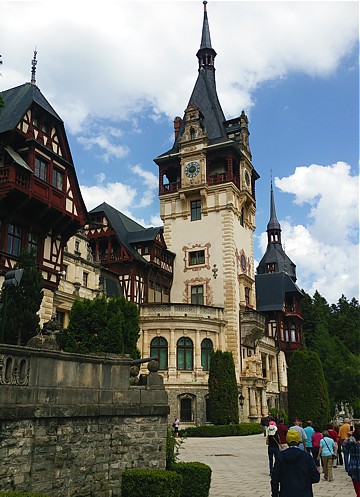
The second excursion allowed me to see the castle, (in fact the palace) Peles in the mountain resort of Sinaia (photo above). It has richly furnished interiors and is one of the tourist pearls of Romania ..
Z Braszowa zrobiłem dwie półdniowe wycieczki. Pierwsza pozwoliła mi zwiedzić średniowieczny zamek Bran. Słynie on w literaturze jako siedziba wampira - Draculi. Pierwowzorem tej literackiej, fikcyjnej postaci jest dawny właściciel zamku Vlad Tepes. Bran jest bardzo malowniczy i ma ciekawe wnętrza, ale zaskoczyły mnie stosunkowo małe rozmiary tego zamku:
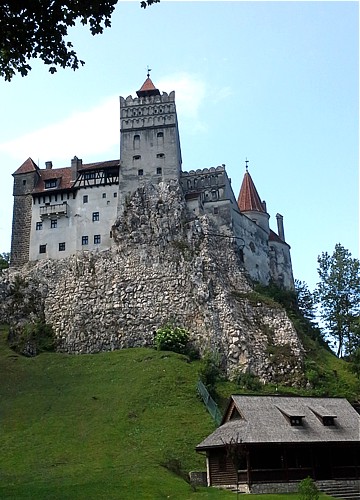
Druga wycieczka pozwoliła mi zobaczyć zamek, a właściwie pałac Peles w górskim kurorcie Sinaia (zdjęcie na lewej kolumnie). Ma on bogato wyposażone wnętrza i jest jedną z turystycznych perełek Rumunii..
Then I came back from Brasov by train to Bucharest - just to change to the green international bus (Flixbus company) going to Sofia. It was a 7 hour bus ride in quite a good standard - for only 12 euros. The capital of Bulgaria surprised me with its beautiful fountains, which can be admired at many points of the city center:
Z Braszowa wróciłem pociągiem do Bukaresztu - tylko po to, aby przesiąść się na międzynarodowy autobus firmy Flixbus jadący do Sofii. To było 7 godzin autobusowej jazdy w całkiem niezłym standardzie - za zaledwie 12 euro. Stolica Bułgarii zaskoczyła mnie swoimi pięknymi fontannami, które można podziwiać w wielu punktach śródmieścia:
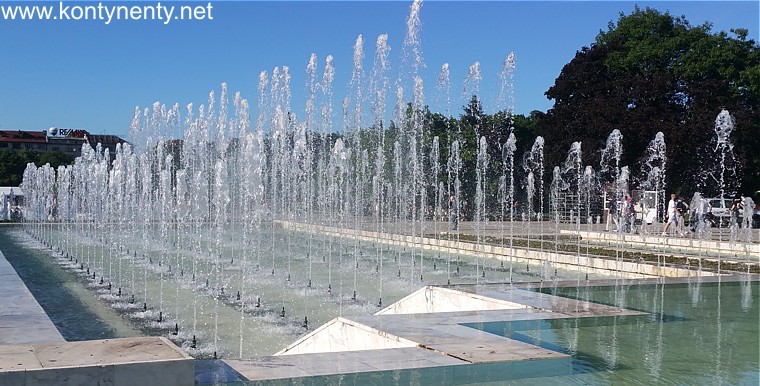
A nice metro has appeared in the capital of Bulgaria, which can be used even to get to the airport. But the center of Sofia is very compact and you can easily explore it on foot. The city's icon is, as many years ago, the great cathedral of Alexander Nevsky (pictured below.) But it is a dark and dead temple with blackened paintings, which is today rather a monument than a place of worship:
W stolicy Bułgarii przybyło ładne metro, którym można szybko dojechać nawet na lotnisko. Ale centrum Sofii jest bardzo zwarte i bez trudu można je zwiedzać na piechotę. Miejscem towarzyskich spacerów jest zamknięty dla ruchu Bulwar Witosza. Ikoną miasta jest jak przed laty wielki sobór Aleksandra Newskiego (na zdjęciu poniżej. Ale to ciemna i martwa świątynia o poczerniałych malowidłach, będąca dziś raczej zabytkiem, niż miejscem kultu:
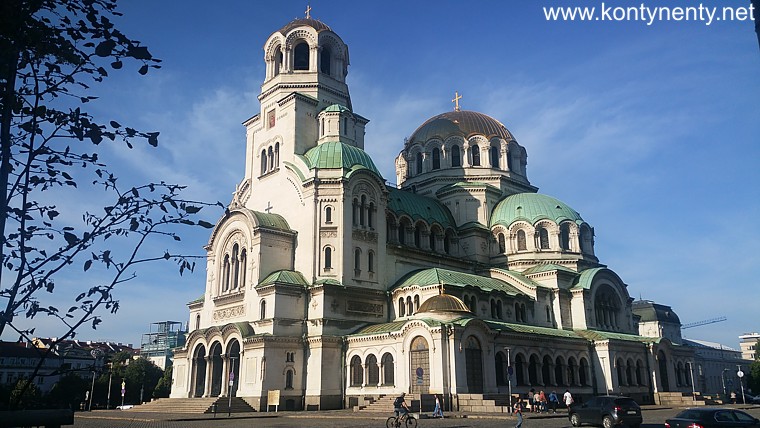
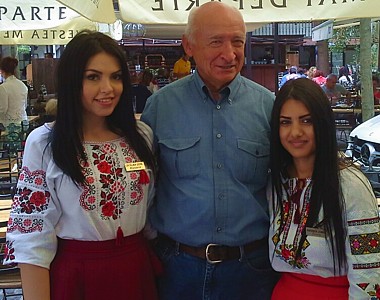
Krótki pobyt w stolicy Bułgarii pozwolił mi przypomnieć sobie smak bułgarskiego wina i... zsiadłego mleka, które jest tutaj tak gęste, że nie wylewa się z odwróconego kubka. Z Sofii przez Ateny wróciłem samolotami tanich linii do Gdańska.
To była bardzo sympatyczna podróż - również dzięki spotkaniom z ludźmi różnych narodowości, różnego wieku i temperamentu. Więcej szczegółów i więcej zdjęć znajdziecie w moim dzienniku podróży.
A short stay in the capital of Bulgaria allowed me to recall the taste of
Bulgarian wine and ... curdled milk, which is so thick here that it does not
spill out of the inverted cup. From Sofia through Athens, I returned to
Gdańsk.
It was a very nice trip - also thanks to meetings with people of different
nationalities, different ages and temperaments. You can find more details
and more photos in my
travel log.

My travel portal was celebrating its 20th anniversary this year! For twenty years I have been reporting on my expeditions to the farthest corners of the globe, telling other dreamers how to travel cheaply and interestingly. When it was created during the early internet era, it was one of the first websites in Poland on such topics. The biggest reward for my huge twenty years of work is a letter from one of the readers: "... I studied your fascinating site two nights and I have the impression that I have not seen everything yet ..." Why I established my travel website (in Polish)?
Mój podróżniczy portal obchodził w 2018 roku 20-lecie! Od dwudziestu lat relacjonuję na nim moje wyprawy do najdalszych zakątków globu, podpowiadając innym marzycielom, jak tanio i ciekawie podróżować. Kiedy powstawał w czasach wczesnego internetu był jedną z pierwszych w Polsce witryn o takiej tematyce. Największą nagrodą za moją ogromną, dwudziestoletnią pracę jest list jednego z czytelników: "... studiowałem pana fascynującą stronę dwie noce i mam wrażenie, że jeszcze wszystkiego nie obejrzałem..." Po co stworzyłem moje podróżnicze strony?
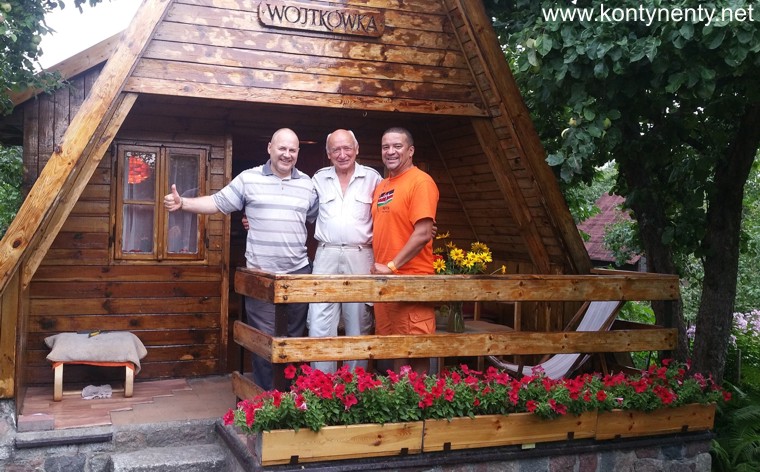
Polish Traveller's Summit in my Wojtkówka! It is not me, but the young and enterprising Ukrainian traveller Mr Orest Zub who invented, that there should be a meeting of the three top Polish travellers. According to him there are only three Polish globertotters, who visited all countries of the world (he is thinking about members of the UN): Mr Slawek Muturi. Mr Mariusz Majewski and... me. We met on August 1st - see the picture above... And here you can see the organizer - Mr Orest:
Spotkanie na szczycie największych polskich podróżników w mojej Wojtkówce! To nie ja, ale młody i przedsiębiorczy ukraiński podróżnik pan Orest Zub wymyślił, że powinniśmy zorganizować spotkanie trzech "największych polskich podróżników", którzy odwiedzili wszystkie kraje świata - jako kryterium przyjął listę krajów - członków ONZ. No i spotkaliśmy się 1 sierpnia: pan Mariusz Majewski z Płocka, pan Sławek Muturi z Warszawy i... ja. Popatrzcie na zdjęcie powyżej - oto polska "wielka trójka".
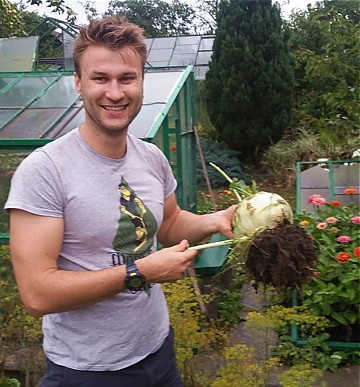
Organizator spotkania w podziękowaniu za swoją inicjatywę został wyróżniony przywilejem wyrwania największej kalarepy, która tego lata wyrosła w Wojtkówce (zdjęcie obok), którą następnie wspólnie degustowaliśmy.
Każdy z nas trzech podróżuje na swój sposób i finansuje swoją podróżniczą pasję z innych źródeł - trudno wiec porównywać nasz podróżniczy dorobek. Po powitaniu moich gości wyjaśniłem, że ja uznaję prawo każdego podróżnika do poznawania świata według własnej recepty, nie oceniam ich dokonań i z nikim na tym polu nie współzawodniczę. Nie konkuruję o lepszą pozycję na jakiejkolwiek liście...
Rozmawialiśmy o naszych planach, dzieląc się doświadczeniami. Moim gościom smakowała bardzo fasolka szparagowa świeżo zebrana na grządkach Wojtkówki, rzodkiewka i deser z czarnych porzeczek:
I was happy that "Wojtkówka" was accepted by all of them as a meeting place. I was also happy to offer my distinguished guests the products "made in Wojtkówka" - we were drinking juices, eating fresh fruits and vegetables picked in my garden, talking about the world and about travelling. There were also a champagne toast for the First Polish Summit and for our future travels.
Był oczywiście toast szampanem za Pierwszy Polski Szczyt i za nasze kolejne podróże (Sławek już następnego dnia odleciał do Grenlandii). Uważam, że było to bardzo udane spotkanie - wśród kwitnących kwiatów Wojtkówki. Czasu było niestety niewiele. Żegnając się wieczorem wszyscy wraziliśmy nadzieję, że niezadługo spotkamy się ponownie - być może w powiększonym gronie - by kontynuować wymianę doświadczeń i poznać się jeszcze lepiej...
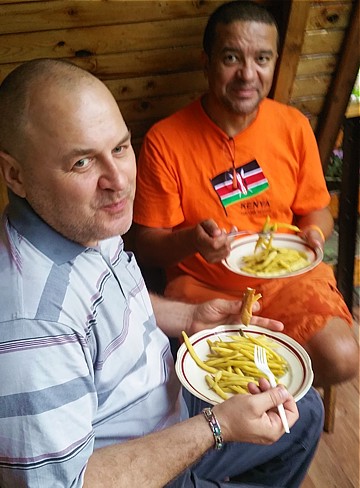
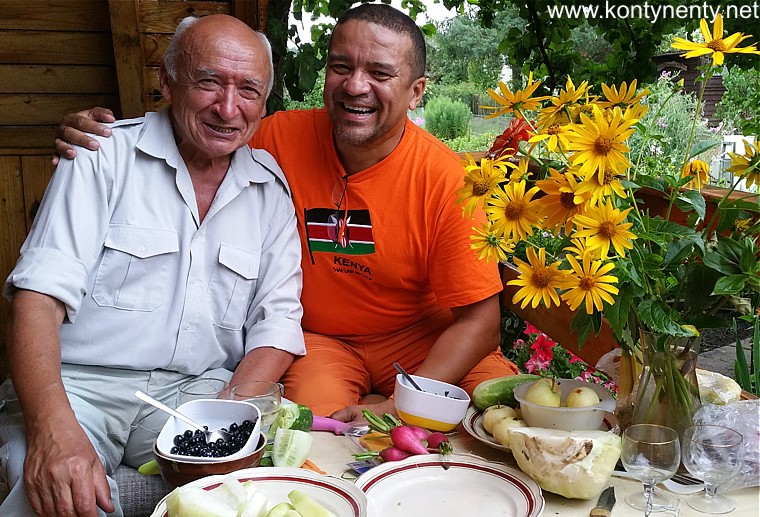
We had in 2018 lovely, hot and sunny summer in Poland! In my Wojtkówka flowers were in full blossom and vegetables grow very fast. And me - if only the weather is sunny - I worked on the open air, enjoying the views and sounds of this - the most pleasant, I think - season of the year. The fresh greenery is all around.
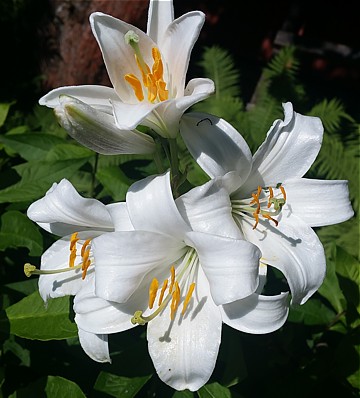
A lot of work is still waiting for me in Wojtkówka - not just cleaning up the garden, but also annual restoration of the cottage. I like to work there, if only the weather is good!
Mieliśmy w tym roku w Polsce wspaniałe, gorące i słoneczne lato! W mojej Wojtkówce kwitły kwiaty i szybko wzrastały warzywa, a ja - gdy tylko pogoda sprzyjała - całe dnie pracowałem na świeżym powietrzu, ciesząc na nowo oczy i uszy widokami i odgłosami lata.
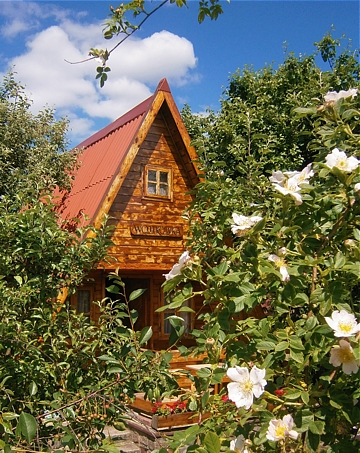
In the evenings when the sun peeks through the side windows of my Wojtkówka I wrote my articles and worked on the details of my next voyages. That's because 3 or 4 new voyages were still scheduled for the second part of the year 2018. Very often I have visitors - my friends and the readers of my book. I can offer them fresh fruits and vegetables picked straight from the beds - like green lettuce, radish and strawberries.
The first traveler from outside of Poland who came to Wojtkówka this season was very friendly Nadya from Minsk in Belarus. She really liked my strawberries (see picture at the bottom). But Nadya is also very brave, passionate traveller with a lot of experience in hitchhiking and low-budget travel. She smiles all the time and always is ready to help. She has also the soul of the artist - I was surprised to find out, that she is designing and publishing many lovely postcards. For me Nadya is ideal Couchsurfing guest:
Wieczorami, gdy zachodzące słońce zaglądało do Wojtkówki przez boczne okienka pisałem artykuły i pracowałem nad szczegółami moich kolejnych podróży. Odwiedzali mnie znajomi i przyjaciele, których częstuję świeżymi warzywami zrywanymi prosto z grządki - po dorodnych rzodkiewkach i szczypiorku ostatnio powodzenie mają zielona sałata i rzodkiewki... Tak wygląda tu typowe śniadanie:
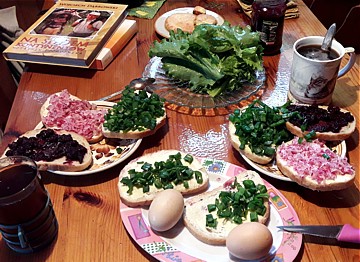
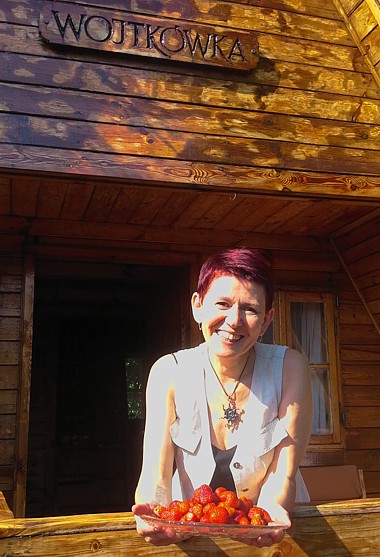
Pierwszą podróżniczką spoza Polski, która zawitała do Wojtkówki w tym sezonie była bardzo sympatyczna Nadia z Mińska na Białorusi. To właśnie ona - na zdjęciu obok. Bardzo jej smakowały moje truskawki!
Ale Nadia jest także podróżniczką - pasjonatką, z dużym doświadczeniem jeśli chodzi o autostop i ogólnie - podróże niskobudżetowe. Pokazałem jej stary Gdańsk i spędziliśmy razem dużo czasu... Na jej przyjazd zakwitła w Wojtkówce pierwsza tegoroczna róża:
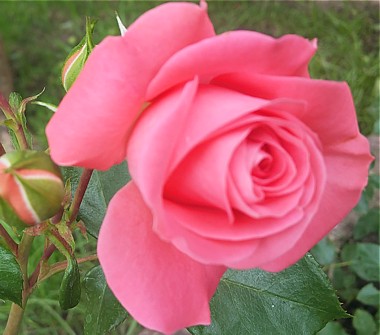
At the end of August 2018 I came back full of new, positive impressions from my next trip to Russia. I always wanted to see the great river Volga - so important for Russian history and culture. And this dream came true. At the beginning I flew from Kaliningrad through Moscow to Samara - a millionth city in the middle of Volga lenght. There, nice Natasza waited for me, and guided me all day around the monuments of her city.
W ostatnich dniach sierpnia 2018 wróciłem pełen nowych, pozytywnych wrażeń z kolejnej podróży do Rosji. Zawsze chciałem zobaczyć wielką rzekę Wołgę - tak ważną dla rosyjskiej historii i kultury. No i udało się zrealizować to marzenie. Na początku poleciałem z Kaliningradu przez Moskwę do Samary - milionowego miasta w środkowym biegu Wołgi. Tam czekała na mnie sympatyczna Natasza, która cały dzień oprowadzała mnie po zabytkach swojego miasta.
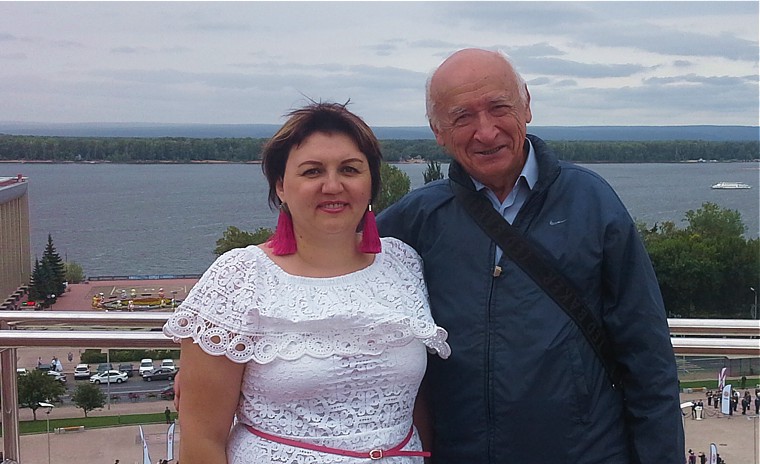
Samara has many beautiful orthodox sobor's and churches (including a Polish catholic church built by exiles), there is a 35-meter-deep bunker built for Stalin, but I liked the coastal promenade on the Volga most - with its monuments, fountains and flower beds:
Samara ma wiele pięknych cerkwi i kościołów (w tym kościół polski zbudowany przez zesłańców), jest tam zagłębiony na 35 metrów bunkier przeznaczony dla Stalina, ale mnie najbardziej podobała się kilkukilometrowa nadbrzeżna promenada nad Wołgą - z pomnikami, fontannami i rabatami kwiatów:
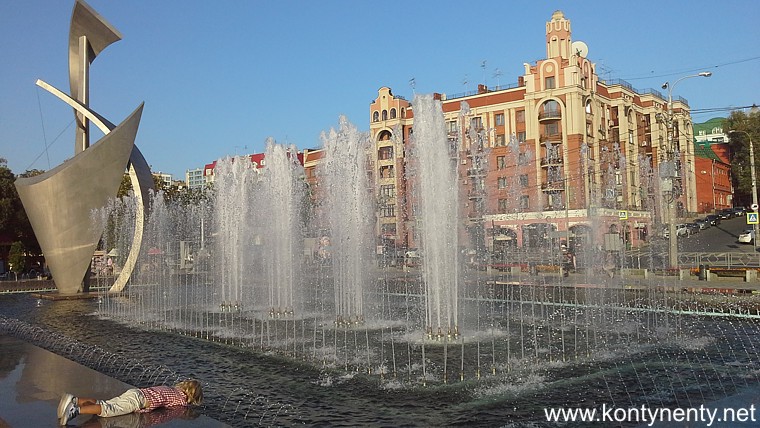
In the evening, a small river ship "Cezar" taking up to 150 passengers came to the pier in Samara. This old junk was built in 1955 - he was heavily worn and decorated inside with the kitsch scenes from the life of Caesar and Cleopatra, but I liked him immediately - for the family atmosphere on the deck. We were departing Samara at sunset time.
Wieczorem do przystani w Samarze nadpłynął niewielki rzeczny statek "Cezar" zabierający do 150 pasażerów. Zbudowano tego staruszka w 1955 roku - był mocno sfatygowany i ozdobiony wewnątrz kiczowatymi scenami z życia Cezara i Kleopatry, ale polubiłem go od razu za rodzinną atmosferę panującą na pokładzie. Opuszczaliśmy Samarę o zachodzie słońca.
Taki miałem widok na wielką Wołgę z mojej kajuty:
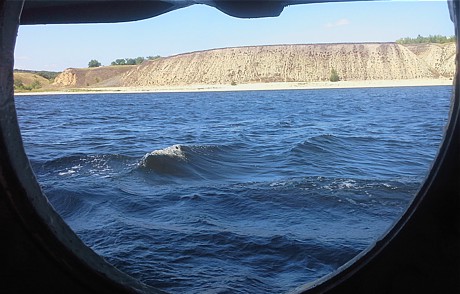
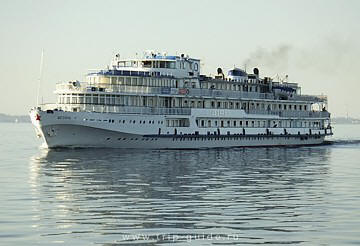
In the morning we were awakened by the chirping of birds (through the ship's radio). Then Galina - the nice director of our cruise announced the program of the day and invited us for breakfast. We heard her later many times - she always talked about the places we passed. That day we had a "green stop" in Usowka - on one of the many islands on the Volga, where you could swim, sunbathe and eat fish fried by a fisherman:
Rano obudziło nas ćwierkanie ptaków (przez statkowy radiowęzeł). Potem Galina - miła dyrektorka naszego rejsu zapowiedziała program dnia i zaprosiła na śniadanie. Słyszeliśmy ją potem wiele razy - zawsze opowiadała o mijanych miejscowościach. Tego dnia mieliśmy w programie "zielony postój" w Usowce - na jednej z wielu wysp na Wołdze, gdzie można było kąpać się, plażować i zjeść rybkę usmażoną przez rybaka:
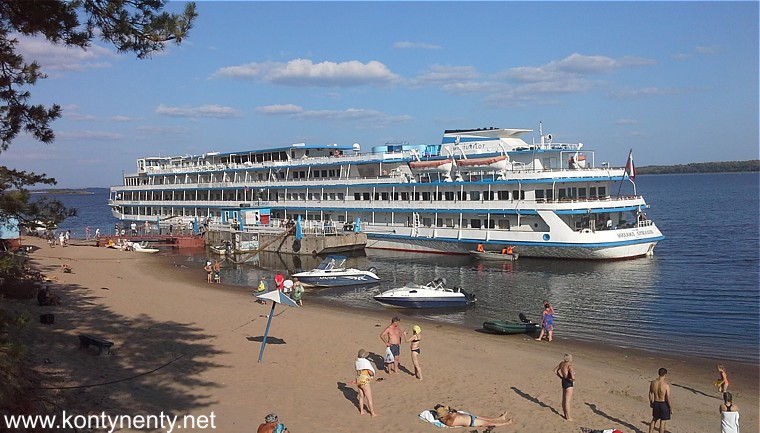
The next stop on the route down the river was Volgograd - the former Stalingrad, in which the fate of the Second World War was settled. The city was completely destroyed during the fightings and there are no historic monuments in it. The main attraction is the monumental (85 m high) statue on Kurgan Mamaya, where the hardest fights took place:
Następnym przystankiem na trasie w dół rzeki był Wołgograd - dawny Stalingrad, w którym rozstrzygały się losy drugiej wojny światowej. Miasto zostało podczas walk całkowicie zniszczone i nie ma w nim zabytków. Główną atrakcją jest monumentalny pomnik na Kurhanie Mamaja, gdzie toczyły się najcięższe walki. Pomnik Matki - Rosji ma 85 metrów wysokości:
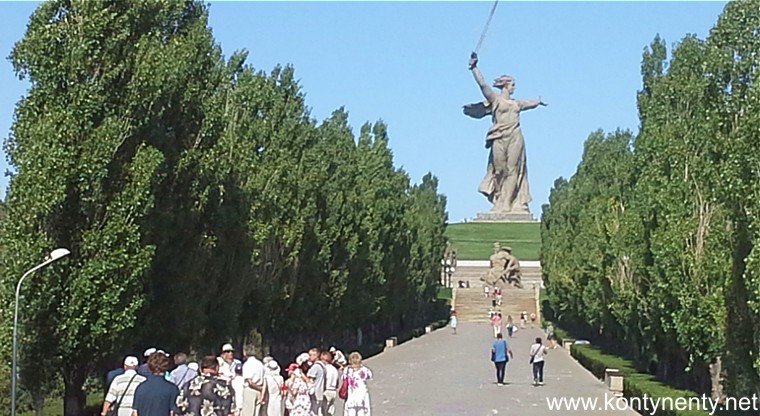
And the ship was sailing ... Weatheh was excellent. Time on the board passed quickly. There were dance classes, handicrafts for ladies, concerts, competitions and discos. I especially liked meetings at the stern at sunset when we sang melodious Russian songs by the accordion:
A statek płynął... Pogoda sprzyjała, podziwialiśmy piękne zachody słońca. Czas na pokładzie mijał nam szybko. Były zajęcia taneczne, rękodzieło dla pań, koncerty, konkursy i dyskoteki. Ja lubiłem szczególnie spotkania na rufie o zachodzie słońca, gdy przy akordeonie śpiewaliśmy melodyjne rosyjskie piosenki:
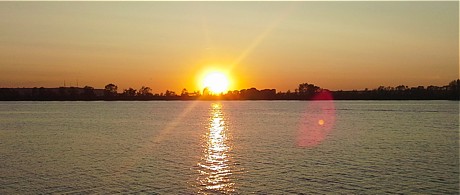
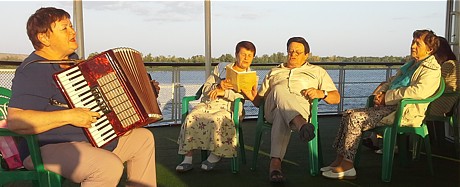
Sailing also at night, we soon reached the legendary Astrakhan - a city that was on the famous Silk Road. To this day, different cultures meet there: on the streets you can hear not only the Russian language, next to the churches there are mosques. In Astrakhan, caviar is still sold (unfortunately today it is rather expensive). The pride of the city is the Kremlin surrounded by well-preserved walls:
Płynąc także nocami wkrótce dotarliśmy do legendarnego Astrachania - miasta, które leżało na słynnym Jedwabnym Szlaku. Do dzisiaj spotykają się tam różne kultury: na ulicach słychać nie tylko język rosyjski, a obok cerkwi stoją meczety. W Astrachaniu dalej sprzedaje się kawior (niestety dziś raczej drogi). Dumą miasta jest otoczony dobrze zachowanymi murami kreml, wewnątrz którego turysta znajdzie pięknie odrestaurowane sobory:
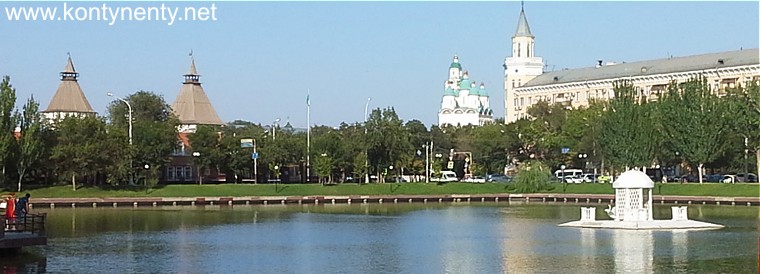
From Astrakhan, lying in the Volga delta, we turned north, stopping at new places. One of them was a large village Nikolskoje, where the residents spread a large bazaar on the shore, where not only you could buy caviar for the half of Astrakhan price, but also they offered watermelons, melons and fruits:
Z Astrachania, leżącego w delcie Wołgi zawróciliśmy na północ, zatrzymując się w nowych miejscach. Jednym z nim była duża wieś Nikolskoje, gdzie mieszkańcy rozłożyli na brzegu spory bazar, w którym nie tylko można było kupić kawior za pół astrachańskiej ceny, ale oferowano także wyroby rękodzieła, dorodne arbuzy, melony i owoce:
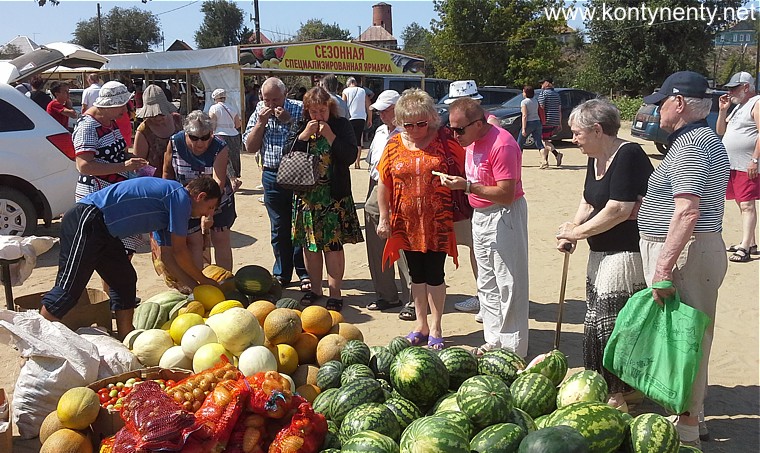
The next day we visited the beautiful city of Saratov, closed for many years to foreigners because of the military planes and rockets produced there. Today, Saratov can already be visited without any obstacles, admiring the beautiful architecture of the orthodox churches and former merchant houses. The city has a distinct European mark, because it was once the center of German settlements on the Volga. Germans were invited by Catherine II:
Następnego dnia odwiedziliśmy piękne miasto Saratow, przez wiele lat zamknięte dla cudzoziemców ze względu na produkowane tam samoloty i rakiety. Dziś Saratow można już zwiedzać bez przeszkód, podziwiając piękną architekturę cerkwi i dawnych kupieckich domów. Miasto ma wyraźne piętno europejskie, bo było niegdyś centrum niemieckiego osadnictwa nad Wołgą. Niemców, dla wprowadzenia zachodnich metod gospodarowania zaprosiła tu caryca Katarzyna II:
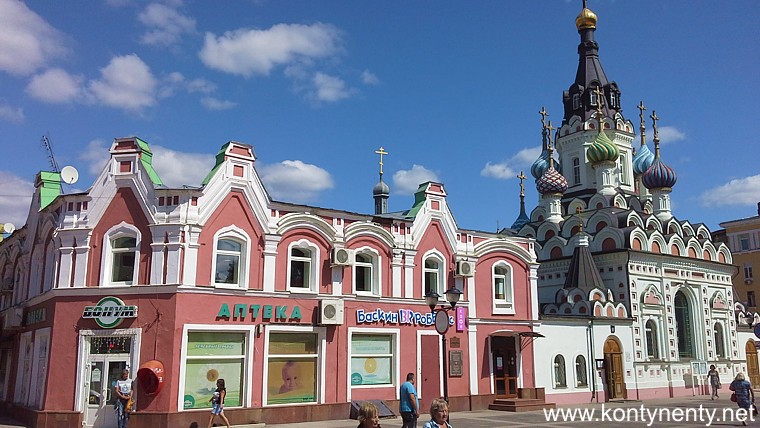
After few days
of sailing I had already many friends on the ship. I met our nice captain,
Ivan Grigoriewicz, who invited me to the bridge. We took a photo of
ourselves. The Captain shook his head in disbelief when I mentioned that I
had visited all the countries of the world. It turned out that there was no
custom on this ship to invite passengers to the captain's table.
Among the passengers there were two nice ladies from Tyumen in Siberia,
where I was a few years earlier - we had common topics for conversation:
Po kilku dniach żeglugi miałem już na statku wielu znajomych. Poznałem sympatycznego kapitana Iwana Grigoriewicza, który zaprosił mnie na mostek. Zrobiliśmy sobie wspólne zdjęcie. Kapitan z niedowierzaniem pokręcił głową, gdy wspomniałem, że odwiedziłem wszystkie kraje świata. Okazało się, że na tym statku nie ma zwyczaju zapraszania pasażerów do kapitańskiego stolika.
Wśród pasażerów były dwie miłe panie z Tiumienia na Syberii, gdzie byłem kilka lat wcześniej - mieliśmy wspólne tematy do rozmowy (to właśnie one na sąsiedniej kolumnie)
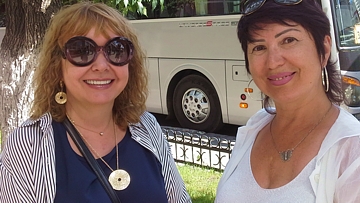
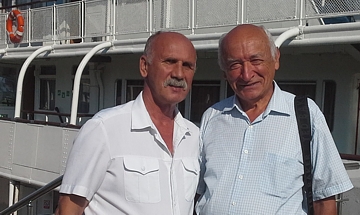
We had onboard the entertainment program. Our top artist was dr Natasha. Can you imagine a doctor who in his free time is learning oriental dances, and during the holidays shows these dances on cruise ships? This is the beautiful doctor Natasha - with me in the picture below. Gentlemen, I think each of you would be so delighted :)
Na statku w ramach programów rozrywkowych występowała doktór Natasza. Czy potraficie sobie wyobrazić lekarza, który w wolnych chwilach uczy się tańców orientalnych, a podczas urlopu pokazuje te tańce na statkach wycieczkowych? To właśnie piękna doktór Natasza - ze mną na zdjęciu poniżej. Panowie, myślę, że każdy z was byłby tak wniebowzięty :)
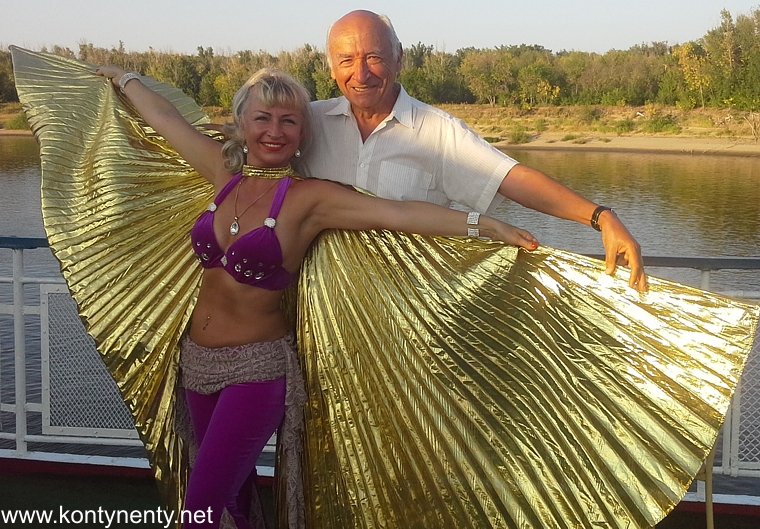
Sailing upstream Volga, we stopped again in Volgograd and Samara - I used these stops to see new parts of the cities. Then we visited Kazan - the capital of the Tatar Republic, known to me from the previous expedition. This time, however, I visited Kazan after sunset - it was a completely different view of the beautifully illuminated city:
Płynąc w górę rzeki zatrzymywaliśmy się ponownie w Wołgogradzie i Samarze - wykorzystałem te postoje, by zobaczyć nowe fragmenty miast. Potem był znany mi z wcześniejszej ekspedycji Kazań - stolica Republiki Tatarskiej, Tym razem jednak zwiedzałem Kazań po zachodzie słońca - było to zupełnie inne spojrzenie na pięknie iluminowane miasto:

I have not mentioned this before, but along the way our ship has overcome several high locks, built where the water stages and power stations were built on the river. It was a very interesting experience when in each such lock our ship was lifted 13 - 15 meters higher. The whole process could be photographed and filmed - it's not the time when all such objects were "secret" or "confidential".
Nie wspomniałem dotychczas o tym, ale po drodze nasz statek pokonywał kilka wysokich śluz, zbudowanych tam, gdzie zbudowano na rzece stopnie wodne i elektrownie. Było to bardzo ciekawe doświadczenie, gdy w każdej takiej śluzie nasz statek podnoszono o 13 - 15 metrów wyżej. Cały proces można było fotografować i filmować - to już nie te czasy, kiedy wszystkie takie obiekty były "tajne/poufne".
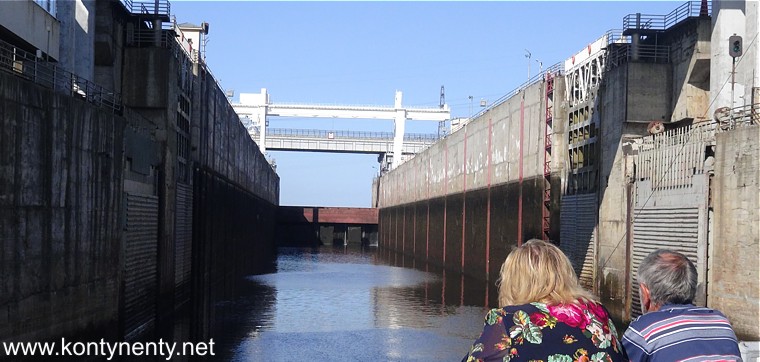
Apart from Russians, people of other nationalities live on the Volga. Already in AstrakhanI met the Kalmyks. Now we were to moor for half a day in Cheboksary - the capital of the small Republic of Chuvash. Wearing their national costumes, they greeted us with music and singing at the pier - like nowhere ...
Nad Wołgą żyją oprócz Rosjan także ludzie innych narodowości. Już w Astrachaniu spotkałem Kałmuków. Teraz mieliśmy zacumować na pół dniach w Czeboksarach - stolicy niewielkiej Republiki Czuwaszów. Przybrani w swoje narodowe stroje witali nas muzyką i śpiewem już na przystani - jak nigdzie...
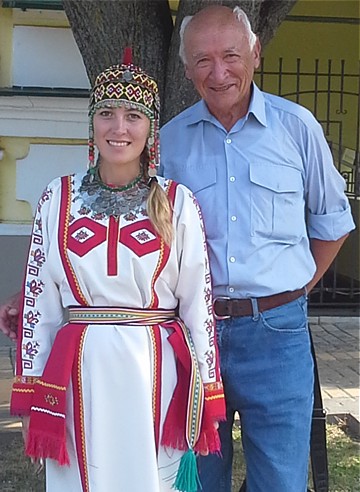
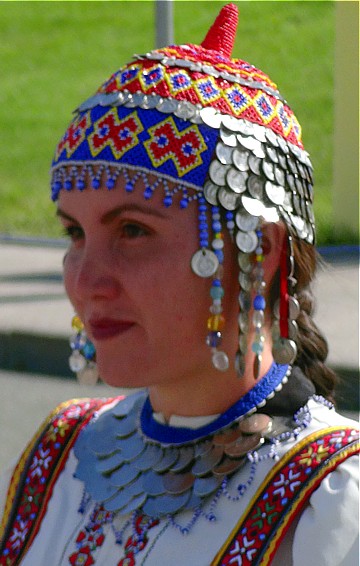
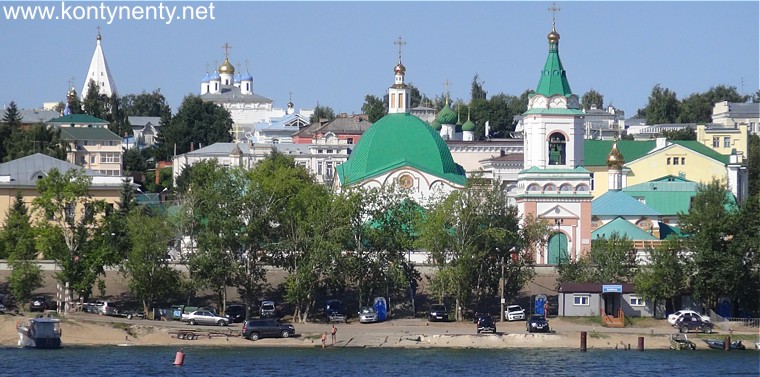
Have you heard about Mary - El Republic? This is not a joke. It exists in Russia, and lies on the Volga. We were there shortly, because the ship had to stand at anchor for a few hours before dawn because of the thick mist that had covered the river. But in the end, we reached the Kozmodemlyansk town, to have a to pass its center by foot and see the collections of pretty good paintings in the museum, which was created in the former home of a wealthy merchant.
Czy słyszeliście o Republice Mari - El? Nie, to nie jest żart! W Rosji jest taka republika i leży nad Wołgą. Krótko tam byliśmy, bo statek musiał przed świtem stanąć na kilka godzin na kotwicy ze względu na gęstą mgłę, która spowiła rzekę. Ale w końcu dotarliśmy do Miasteczka Koźmodemliańsk, by zajrzeć do kramów z rybami i pamiątkami a potem na piechotę przejść jego centrum i obejrzeć kolekcję całkiem dobrego malarstwa w muzeum, które powstało w dawnym domu bogatego kupca.
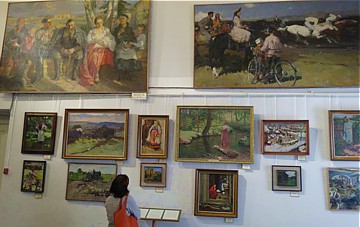
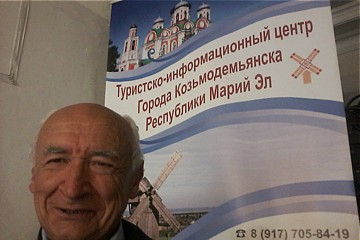
Finally, our ship reached over one million inhabitants-city Nizhny Novgorod, where it came to say goodbye to him. My host from Couchsufring - Slava was waiting here for me on the waterfront. He proved to be not only sympathetic, but also extremely reliable and at the same well-organized man. Throughout the day we visited this historic city together and in the evening at his house I showed my photos from seven continents. It was a very nice meeting. In the morning, Slava kindly drove me back to the airport - I flew to Kaliningrad via Moscow, and from there I got to Gdańsk by bus.
Wreszcie nasz statek dotarł do ponad milionowego Niżnego Nowgorodu, gdzie przyszło mi go pożegnać. Tu na nabrzeżu czekał mój host z Couchsufringu - Sława. Okazał się nie tylko sympatycznym, ale także niezwykle rzetelnym i przy tym dobrze zorganizowanym człowiekiem. Przez cały dzień wspólnie zwiedzaliśmy to historyczne miasto, a wieczorem w jego domu pokazałem moje zdjęcia z siedmiu kontynentów. To było bardzo miłe spotkanie. Rano życzliwy Sława odwiózł mnie jeszcze na lotnisko - przez Moskwę poleciałem do Kaliningradu, a stamtąd autobusem dotarłem do Gdańska.
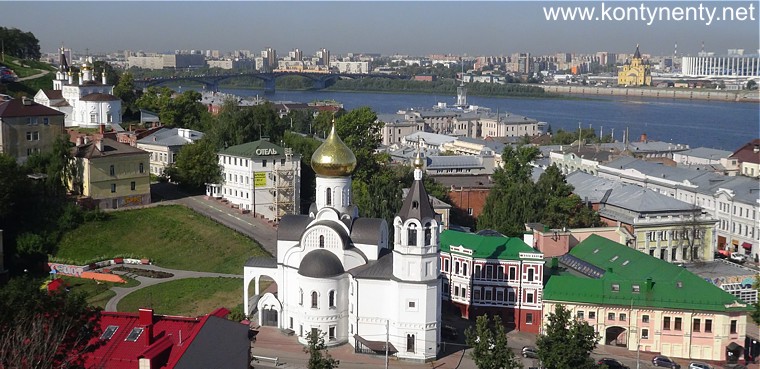
This cruise, although carried out on an old, junk ship, met all my expectations. I met many kind people. I saw the life of this great river... Who knows if I will not come back in the future to sail in a similar way on the route from Perm to Moscow...
You will find hot messages and photos from this expedition in my travel log. Soon a map of this Volga expedition and more pictures will appear on the separate page Volga_2018.
Ten rejs, choć odbywany na starym statku spełnił wszystkie moje oczekiwania. Spotkałem wielu życzliwych ludzi. Zobaczyłem jak żyje ta wielka rzeka... Kto wie czy w przyszłości nie wrócę, aby przepłynąć w podobny sposób trasą z Permu do Moskwy...
Pisane na gorąco wiadomości i fotki z tej trasy znajdziecie w moim dzienniku podróży, a mapka i więcej zdjęć z wołżańskiej trasy będzie już wkrótce w osobnej fotorelacji.
In September I went on a short trip to Finland. The main destination of the trip were the Åland Islands - belonging to Finland, although the majority of the population speaks Swedish there. I have wanted to go there since a long time, but I always postponed this journey "for later" - because it's so close and you can always go there without long preparations ... These rocky, smaller and larger islands (and there are more than 6,000 of them) ) are famous for beautiful, raw landscapes:
We wrześniu wybrałem się na krótką wycieczkę do Finlandii. Głównym celem podróży były Wyspy Alandzkie - należące do Finlandii, choć większość ludności mówi tam po szwedzku. Już dawno temu chciałem się tam wybrać, ale zawsze odsuwałem tę podróż "na potem" - bo to przecież to tak blisko i zawsze można tam pojechać bez długich przygotowań... Te skaliste, mniejsze i większe wyspy (a jest ich w sumie ponad 6000) słyną z pięknych, surowych krajobrazów:
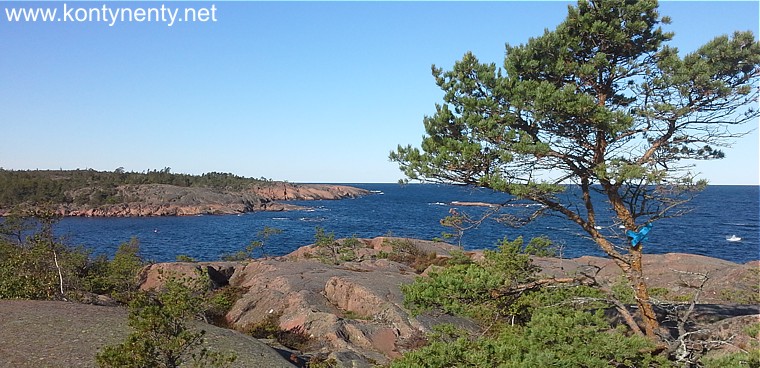
Alands have an interesting history. The Russians occupied these islands together with a large amount of Finland in the early nineteenth century and built here with the hands of prisoners and exiles solid fortifications. Their remains have survived to this day - among others, the ruins of the Bomarsund fortress. I visited them, and the boards at the ruins allowed me to imagine what the fortress looked like before the French-English attack:
Alandy mają ciekawą historię. Rosjanie zajęli te wyspy razem ze sporą połacią Finlandii na początku XIX wieku i zbudowali tu rękami więźniów i zesłańców solidne fortyfikacje. Do dziś przetrwały ich pozostałości - między innymi ruiny twierdzy Bomarsund. Odwiedziłem je, a ustawione przy ruinach plansze pozwoliły wyobrazić sobie, jak wyglądała twierdza przed francusko - angielskim atakiem:
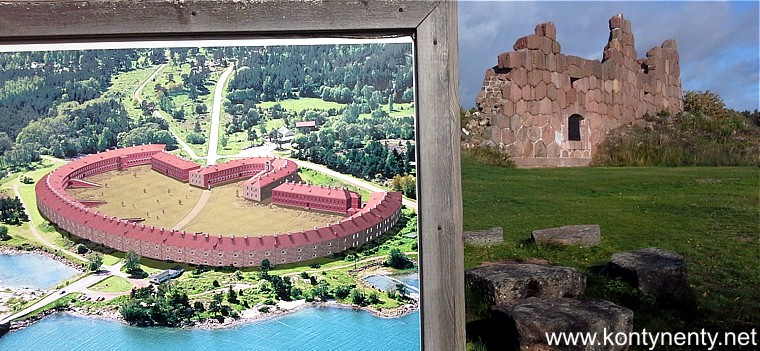
On the Alands, also survived monuments from the period when the Swedes ruled here - among others, Kastelholm castle, built in the fourteenth century. Unfortunately, such buildings are open here for visitors only until mid-September, so I could only see it from the outside:
Na Alandach przetrwałe też zabytki z okresu, gdy rządzili tu Szwedzi - między innymi zamek Kastelholm, zbudowany w XIV wieku. Niestety ruch turystyczny zamiera na Alandach z końcem lata i takie budowle otwarte są tutaj dla zwiedzających tylko do połowy września, więc mogłem go oglądać tylko z zewnątrz:
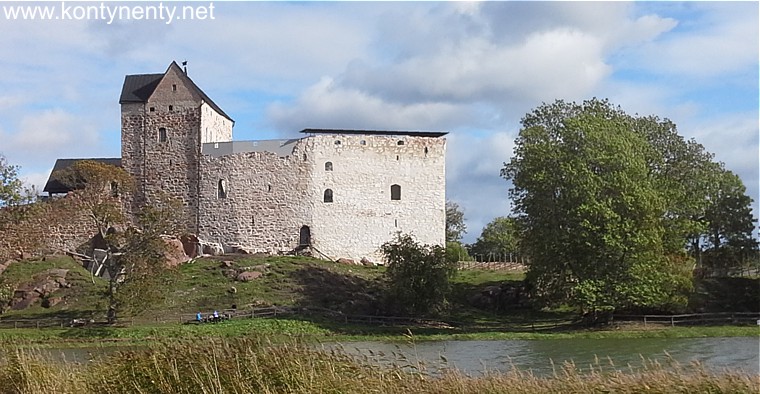
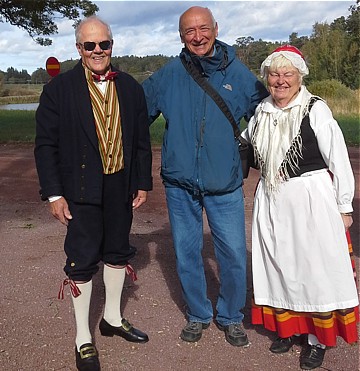
Publiczny transport na słabo zaludnionych Alandach jest zaledwie śladowy, więc podróżowałem po wyspach głownie pieszo i autostopem. Ta ostatnie metoda pozwalała mi spotykać ciekawych miejscowych ludzi. Są z natury pogodni i życzliwi. Na szczęście większość z nich mówi po angielsku, bo język fiński jest bardzo trudny :) Trwał akurat jakiś festiwal związany ze zbiorami płodów rolnych...
Public transport on sparsely populated Alands is barely trace, so I traveled the islands mainly on foot and hitchhiking. This last method allowed me to meet interesting local people. They are naturally cheerful and friendly. Fortunately, most of them speak English because the Finnish language is very difficult :)
From the Aland Islands I returned by ferry to Turku. This Finnish city is the gateway to the Alands. Several times a day ferries leave for the capital of the archipelago - Mariehama. Turku is a small but nice city, located at the mouth of the river. Here, too, the Swedes once built a solid castle. But I liked most the old cathedral, to which beautiful riverside boulevards lead:
Z Alandów wróciłem promem do Turku, to fińskie miasto jest bramą wjazdową do Alandów. Kilka razy na dobę odpływają stąd promy do stolicy archipelagu - Mariehamy. Turku jest niewielkim, ale ładnym miastem, położonym u ujścia rzeki. Tu także Szwedzi zbudowali kiedyś solidny zamek. Ale mnie najbardziej podobała się stara katedra, do której doprowadzają piękne nadrzeczne bulwary:
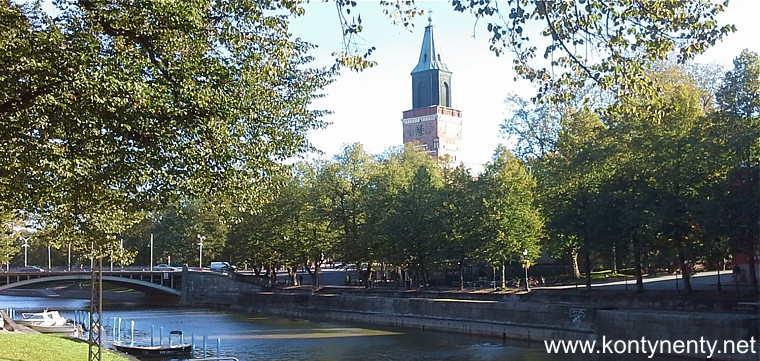
It was a journey for the proverbial pennies. I got my flight tickets for free - when I collected a lot of bonus money on my wizzair account, I thought it was worth taking the chance: fly straight from Gdańsk to Turku, from there take a ferry to the Alands, and after the cruise, add to the route also a small bus loop around unknown to me Western Finland. Thanks to the internet, I managed to buy three bus tickets by paying 1 euro for each and an inexpensive (24 euro, return) ferry ticket. The problem of accommodation, which in the Scandinavian countries is very expensive, remained. I decided to try couchsurfing. Finding hosts was not easy... The Finns answered negatively or did not answer at all. In the end, however, I received invitations for free accommodation: from Indian, from a German, from a Chinese from Taiwan, from a Russian. Honor of Finland was saved by a single Finn lady :) The route map you can find here.
From Turku I went by bus to the old port of Vaasa, where on the central Square you will find Freedom Monument:
To była podróż za przysłowiowe grosze. Bilety lotnicze dostałem gratis - gdy na moim koncie w linii wizzair pojawiło się sporo premiowych pieniędzy do wykorzystania pomyślałem, że warto wykorzystać szansę: polecieć prosto z Gdańska do Turku, stamtąd popłynąć promem na Alandy, a po rejsie dołożyć jeszcze do trasy małą pętlę autobusową po nieznanej mi Zachodniej Finlandii. Dzięki internetowi udało mi się kupić trzy bilety autobusowe płacąc po 1 euro i niedrogi (24 euro, powrotny) bilet na prom. Pozostał problem noclegów, które w krajach skandynawskich są bardzo drogie. Postanowiłem spróbować couchsurfingu. Znalezienie hostów nie było łatwe... Na moje rozesłane zapytanie Finowie odpowiadali negatywnie, albo nie odpowiadali wcale. W końcu jednak otrzymałem zaproszenia na darmowy nocleg: od Hindusa, od Niemca, od Chińczyka z Tajwanu, od Rosjanki. Honor Finlandii uratowała pewna Finka z Turku :) Mapkę całej trasy możecie zobaczyć tutaj.
Z Turku pojechałem autobusem do starego portu Vaasa, gdzie na centralnym placu stoi Pomnik Wolności:

On the next day, also by bus, I reached the second largest city of Finland - Tampere. This day in Tampere was the only rainy day on this trip. It was raining all the time, but still I managed to see the most interesting places in the city, which lies between two lakes. A curiosity of Tampere is ... Lenin Museum, which lived here before the revolution:
Kolejnego dnia, również autobusem dotarłem do drugiego co do wielkości miasta Finlandii - Tampere. Ten dzień w Tampere był to jedyny deszczowy dzień w całej tej podróży. Padało bez przerwy, ale mimo to zdążyłem zobaczyć najciekawsze miejsca w mieście, które leży między dwoma jeziorami. Ciekawostką Tampere jest... Muzeum Lenina, który mieszkał tu jeszcze przed rewolucją:
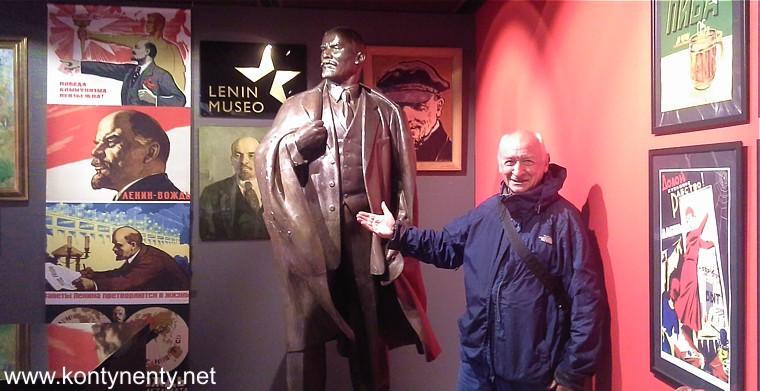
From Tampere by bus I came back to Turku and on the same day I flew by plane to Gdansk. One more voyage was completed. It was a very nice trip to a country whose main attraction is the beautiful and unspoilt nature. You can find hot travel news in my travel log
Z Tampere autobusem wróciłem do Turku i tego samego dnia poleciałem samolotem do Gdańska. To była bardzo sympatyczne podróż do kraju, którego główną atrakcją jest piękna i nieskażona przyroda. Wieści zapisywane na gorąco na trasie znajdziecie jak zawsze w moim dzienniku podróży
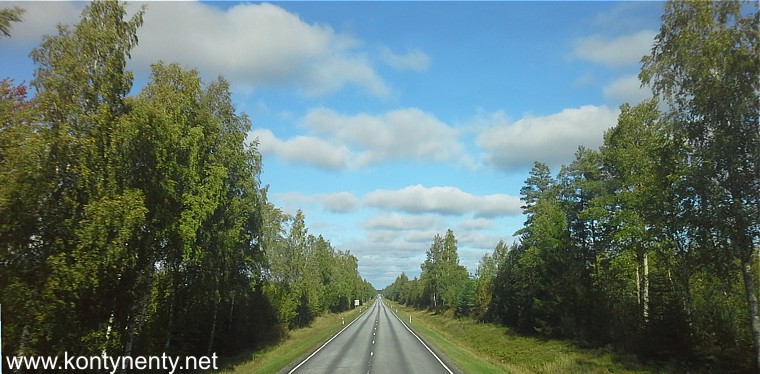
It was the sixth trip of 2018! You probably heard about the historic pilgrim route Camino de Santiago, which runs from the Pyrenees to the tomb of Saint James in Santiago de Compostela in Spain. Here is the charming little French town of Saint Jean Pied de Port, where pilgrims start the pilgrimage:
To była już szósta podróż 2018 roku! Słyszeliście zapewne o historycznym szlaku pielgrzymów Camino de Santiago, który prowadzi od Pirenejów do grobu Świętego Jakuba w Santiago de Compostela w Hiszpanii. Oto urocze, małe francuskie miasteczko Saint Jean Pied de Port, skąd wyruszają pielgrzymi:
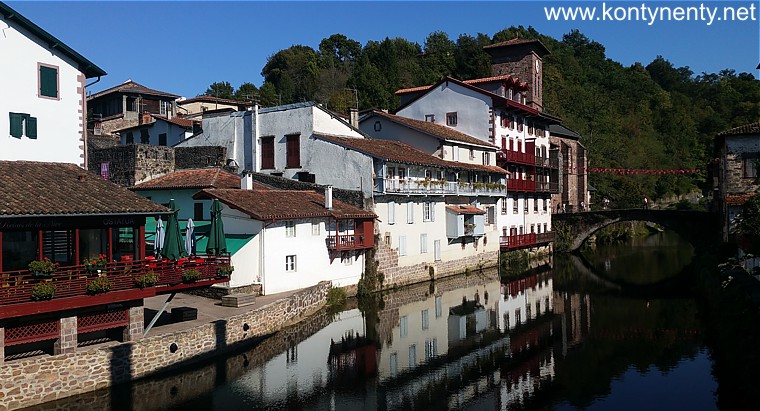
Then the trail climbs to the Ibaneta Pass through which runs the border between France and Spain and falls on the green Pyrenean slopes towards Pamplona, the capital of Navarra. Behind Pamplona, I was impressed by the moody town of Puente La Reina with a stone bridge built for pilgrims in the 11th century:
Potem szlak wspina się na Przełęcz Ibaneta przez którą przebiega granica Francji i Hiszpanii i opada po stokach zielonych Pirenejów ku Pampelunie - stolicy Nawarry. Za Pampeluną zachwyciło mnie nastrojowe miasteczko Puente La Reina z kościołami, wąskimi uliczkami i kamiennym mostem zbudowanym dla pielgrzymów już w XI wieku:
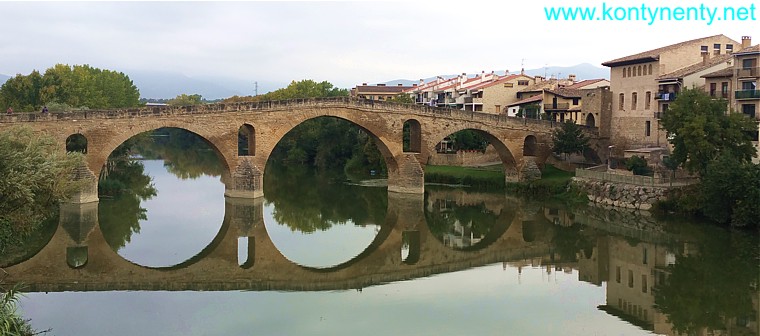
There are many old churches, monasteries, larger and smaller towns on the trail. Behind Estella, the trail leads to the great Irache monastery surrounded by vineyards. Perhaps this is the reason why the Fuente de Vino - a free wine fountain for passing pilgrims - has been running here for centuries. Two taps protrude from the bodega's wall: spring water flows from one, and in the other is a pretty good red wine. You just need to have your own vessel:
Na szlaku jest wiele starych kościołów, klasztorów, większych i mniejszych miast. Za Estellą szlak doprowadza do wielkiego klasztoru Irache otoczonego przez winnice. Być może to właśnie przesądziło, ze przy trakcie działa tu od wieków Fuente de Vino - darmowa pijalnia wina dla przechodzących pielgrzymów. Ze ściany bodegi wystają dwa krany: z jednego płynie źródlana woda, a z drugiego - zupełnie niezłe czerwone wino. Trzeba tylko mieć własne naczynie:
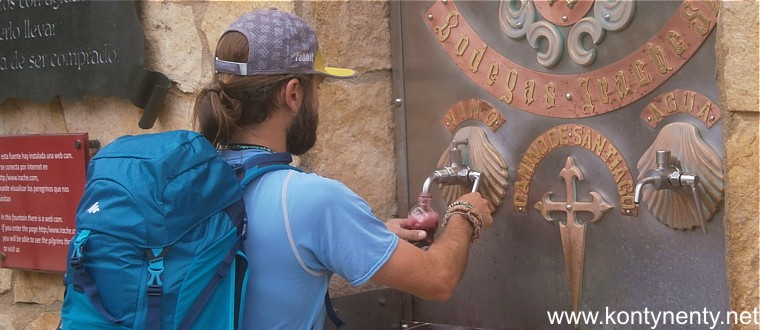
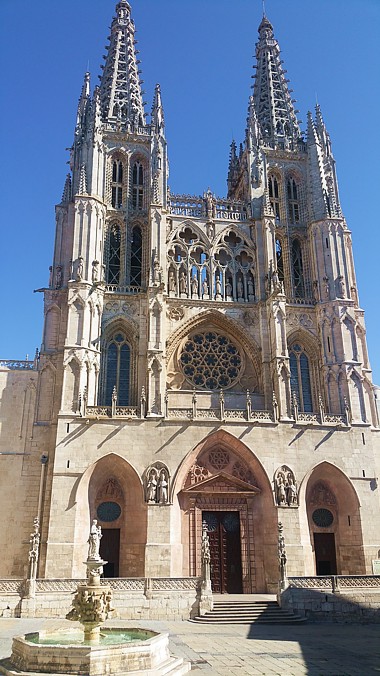
Nie sposób wymienić i pokazać wszystkie zabytki architektury, które widziałem na szlaku - wśród nich wyróżniała się na pewno katedra w Burgos (na zdjęciu obok). Nieprzyjemną niespodzianką był fakt, że za wstęp do katedr i innych ważniejszych świątyń pobierano opłatę po kilka euro - nawet od pielgrzymów. Szczerze mówiąc odcinki szlaku prowadzące przez wielkie, przemysłowe nowoczesne miasta nie podobały mi się wcale. Podobnie jak etapy prowadzące wzdłuż ruchliwych dróg przez płaską, kastylijską mesetę. Ale podobały mi się te małe miasteczka w których zatrzymał się czas i nastrój dawnych wieków jak Villafranca, a przede wszystkim wzniesiona z kamienia maleńka górska wioska O Cebreirio (na zdjęciu poniżej)
It is impossible to mention and show all the architectural monuments that I have seen on the trail - among them, the magnificent cathedral in Burgos (the picture on the left column) stood out for sure. An unpleasant surprise was the fact that they charge admission to the cathedrals and other major temples - a fee of a few euros - even from the pilgrims. Honestly, the sections of the route leading through large, industrial modern cities did not please me at all. Also the stages leading along busy roads through a flat Castilian meset. But I liked very much those small towns where time and the mood of old times stopped - like Villafranca, and above all - the little mountain village of O Cebreirio built from stone (pictured below)
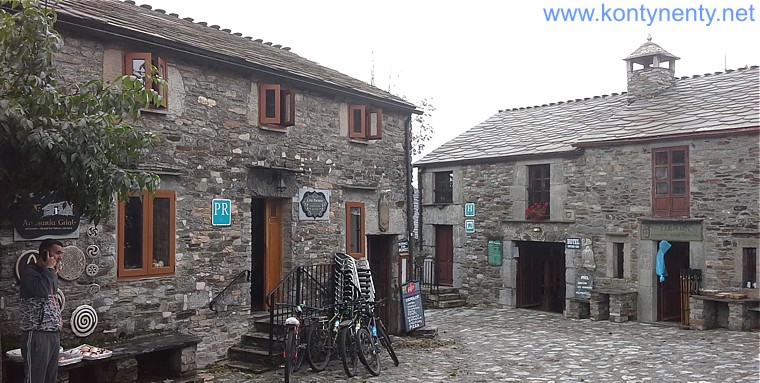
From O Cebreiro, two days I walked along mountain paths to the famous Samos Monastery, hidden in a deep valley:
Z O Cebreiro dwa dni szedłem górskimi ścieżkami do słynnego klasztoru Samos, ukrytego w głębokiej dolinie:
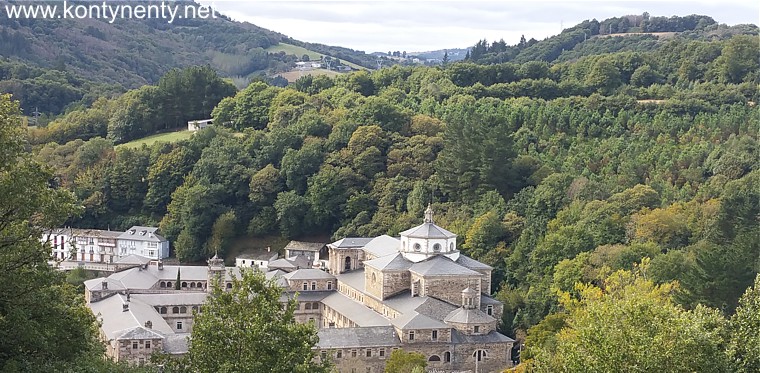
On the trail marked with milestones showing the distance to the tomb of the apostle James, I met hundreds of other travelers from around the world, with many pilgrims I have seen many times at various points of the route, such as this nice Japanese and Korean.
Na szlaku wyznaczonym słupkami pokazującymi odległość do grobu apostoła Jakuba spotykałem setki innych wędrowców z całego świata, z wieloma pielgrzymami widziałem się wielokrotnie w różnych punktach trasy, jak na przykład z tą sympatyczną Japonką i Koreanką:
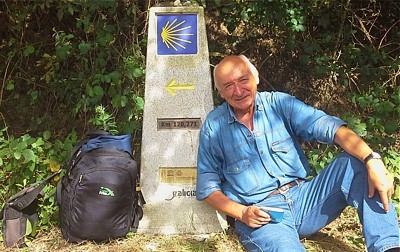
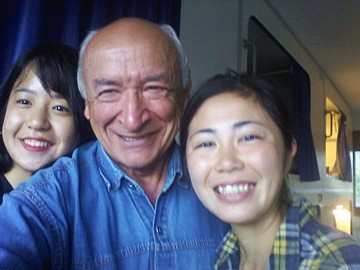
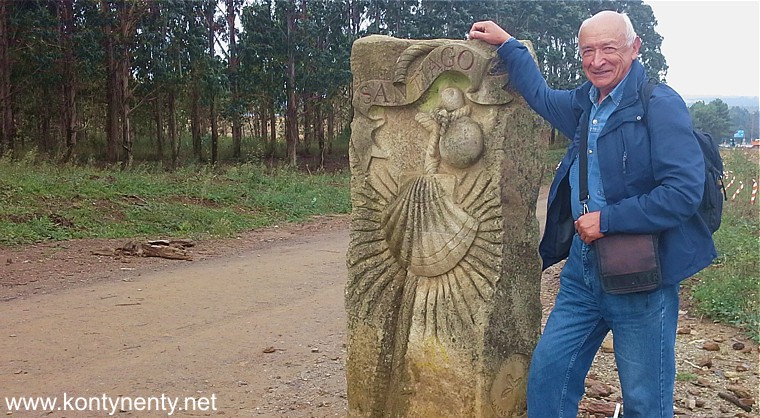
Pilgrims with the backpacks are not allowed to enter the cathedral! I was forced to go first to my pension to leave the bags. In the cathedral I saw a silver sarcophagus with the apostles' relics and in accordance with tradition I hugged (from the back) to the figure of a saint standing in the main altar. I also participated in a solemn holy mass for pilgrims.
Na miejscu okazało się, że do środka nie wpuszczają pielgrzymów z plecakami. Wróciłem po pozostawieniu bagażu na kwaterze by zobaczyć w krypcie srebrny sarkofag z relikwiami apostoła i zgodnie z tradycją przytulić się (od tyłu) do figury świętego stojącej w głównym ołtarzu. Uczestniczyłem też w uroczystej mszy św. dla pielgrzymów.
In the background - Mt Gozo monument:
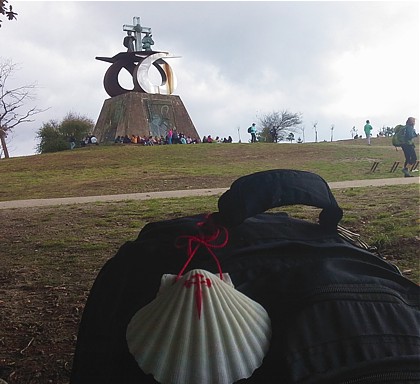
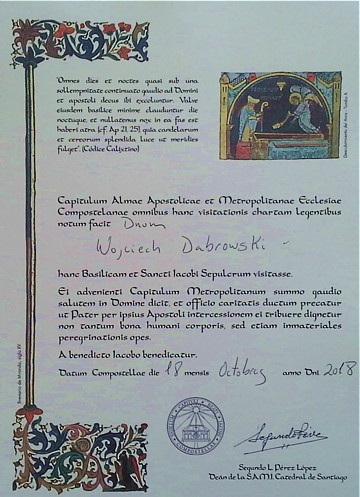
I have brought two souvenirs from the trail: a certificate about the passage of several hundred kilometers on a pilgrimage trail (on the right column above)) and a shell with a cross of Saint. James - a Camino symbol - most pilgrims put it on their backpacks.
Santiago turned out to be a beautiful city, I especially liked its romantic old town:
Z wędrówki przywiozłem dwie pamiątki: certyfikat o przejściu kilkuset kilometrów pielgrzymkowym szlakiem (powyżej) i muszlę z krzyżem Św. Jakuba, będącą symbolem Camino - większość pielgrzymów przytracza ją do swoich plecaków.
Santiago okazało się pięknym miastem, szczególnie podobała mi się jego nastrojowa starówka:
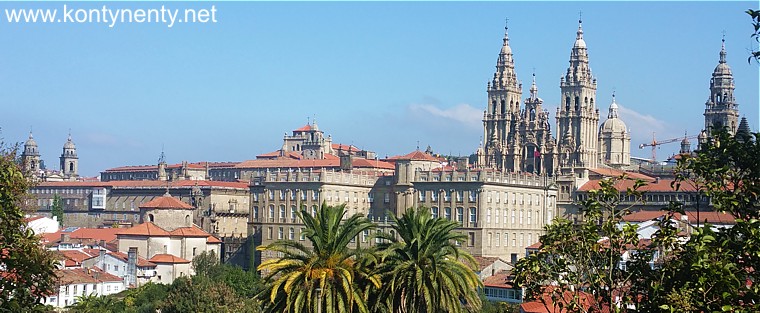
And then it was time for a well-deserved rest - I flew aboard low-cost plane to Barcelona, embarked there a cheap ship and sailed to those small Mediterranean ports in which I have not been yet. I especially liked sleepy Minorca Island, Portovenere and Portofino on the Ligurian coast of Italy. In Portovenere, I climbed there a 300-meter cliff to make such a panorama:
A potem przyszła pora na zasłużony odpoczynek - tanią linią poleciałem do Barcelony, wsiadłem na tani statek i popłynąłem do tych małych portów Morza Śródziemnego, w których jeszcze nie byłem. Szczególnie spodobała mi się senna Minorka oraz Portovenere i Portofino na liguryjskim wybrzeżu Włoch. W Portovenere wspiąłem się na 300-metrowy klif by zrobić taką oto panoramę:
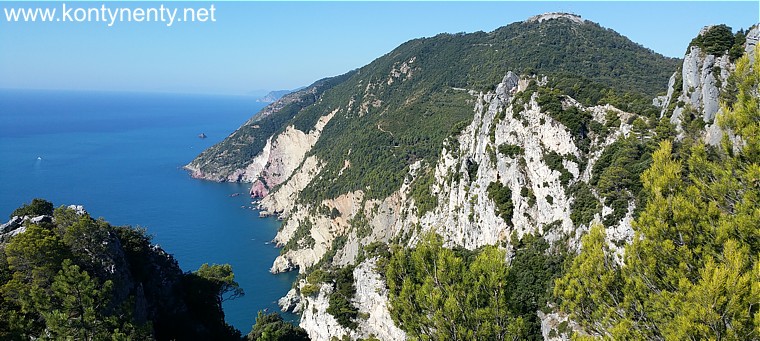
This voyage has met my expectations. I knew that it took more than a month to walk the entire Camino Frances route. I did not have that much time and I was not going to walk through those episodes where the path leads today along the roaring motorways or the highways. I chose for the hiking only the most interesting and the most picturesque fragments. You can see the map of the entire journey here. You can also find notes from the trip as always - in my travel log
Ta podróż spełniła moje oczekiwania. Wiedziałem, że na przejście pieszo całego szlaku Camino Frances trzeba poświęcić ponad miesiąc. Ja nie miałem tyle czasu i nie zamierzałem maszerować przez te odcinki, gdzie ścieżka prowadzi dziś wzdłuż ryczących motorami autostrad i przez rejony przemysłowe. Wybrałem dla pieszej wędrówki tylko najciekawsze i najbardziej malownicze fragmenty. Mapkę całej podróży możecie zobaczyć tutaj. A notatki z trasy znajdziecie jak zawsze w moim dzienniku podróży
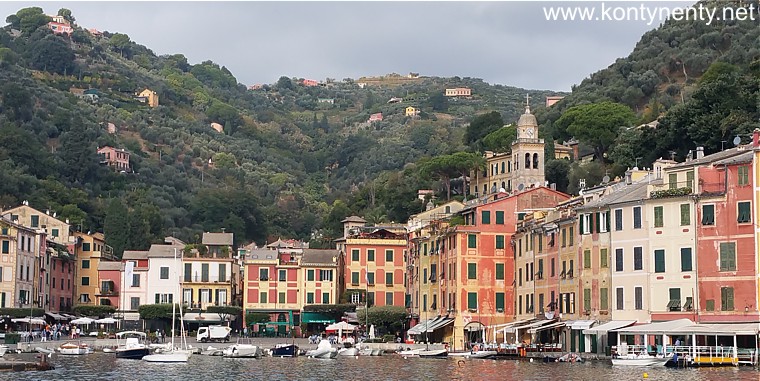
In December 2018 I came back from a trip to South America! The purpose of this trip was Brazil, or more precisely - Estrada Real - a route of historic towns built in colonial times, where gold and precious stones were mined. The trail led from the mines in the interior to the port of Paraty on the Atlantic coast, from where the treasures flowed into Portugal in the hold of the ships. The towns also grew rich, beautiful churches and monasteries were built in them.
W grudniu 2018 wróciłem z do Ameryki Południowej! Celem tej podróży była Brazylia, a dokładniej - Estrada Real - szlak historycznych miasteczek, zbudowanych w czasach kolonialnych tam, gdzie wydobywano złoto i drogocenne kamienie. Szlak prowadził z kopalń w interiorze do portu Paraty na atlantyckim wybrzeżu, skąd w ładowniach statków skarby odpływały do Portugalii. Bogaciły się także miasteczka, budowano w nich piękne kościoły i klasztory.
However, my path to Brazil started in Europe - in Sicily, which I decided to visit along the way, many years after my first visit. I stayed at the beginning in Catania to make a trip to the slopes of Etna, and then I went to Agrigento to see the famous ancient temples:
Moja droga do Brazylii zaczęła się jednak w Europie - na Sycylii, którą postanowiłem odwiedzić po drodze, po wielu latach od mojego pierwszego pobytu. Zatrzymałem się w Katanii, by zrobić wycieczkę na zbocza Etny, a następnie pojechałem do Agrigento obejrzeć słynne starożytne świątynie:
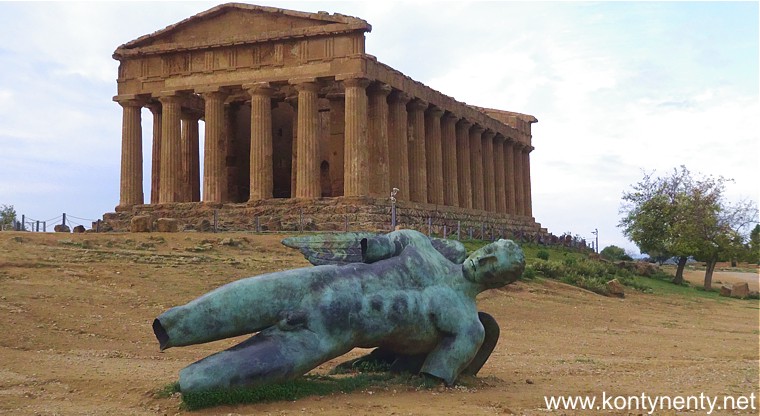
On the coast near Agrigento you can see the natural curiosity - the so-called Turkish stairs - white rocks falling into the sea with narrower and wider terraces. Theoretically, you can not walk on these stairs - the place is fenced. But after the season, no one is watching and tourists easily find a hole in the fence and enter the white headland - thanks to this, you can compare the height of the stairs with the human figure:
Na wybrzeżu w pobliżu Agrigento można zobaczyć osobliwość przyrodniczą - tzw. Tureckie Schody - białe skały opadające do morza węższymi i szerszymi tarasami. Teoretycznie nie wolno po tych schodach chodzić - miejsce jest ogrodzone. Ale po sezonie nikt tego nie pilnuje i turyści bez problemu znajdują dziurę w płocie i wchodzą na biały cypel - dzięki temu można porównać wysokość schodów z sylwetką człowieka:
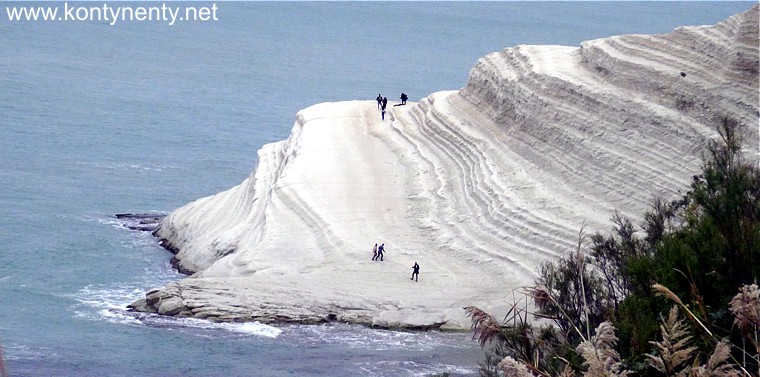
I flew from Sicily with cheap airlines to Barcelona - just to get on board of the ship heading for South America. We left the port of Barcelona at dusk - you could see the beautifully illuminated city:
Z Sycylii poleciałem tanimi liniami do Barcelony - tylko po to, by od razu zaokrętować się na statek zmierzający do Południowej Ameryki. Wychodziliśmy z portu w Barcelonie w porze zmierzchu - widać było pięknie iluminowane miasto:
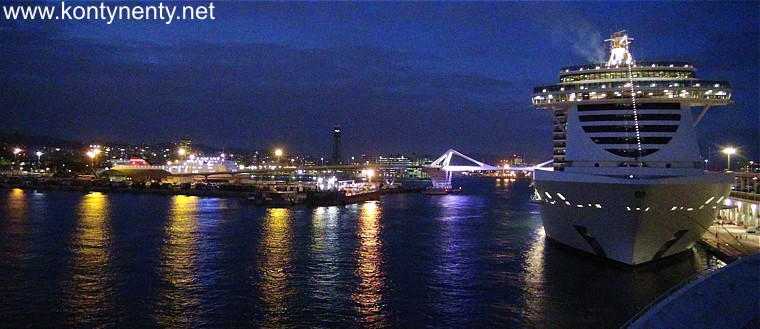
The next day our ship was arriving in Alicante, still in Spain, to board the remaining passengers. I have not been to Alicante before, so a day's stopover gave me the opportunity to visit this nice city, above which the castle - Castillo Santa Barbara is towering:
Następnego dnia nasz statek zawinął do Alicante, wciąż w Hiszpanii, by zabrać pozostałych pasażerów. Nie byłem dotąd w Alicante, więc całodzienny postój dał mi okazję do zwiedzenia tego ładnego miasta, ponad którym góruje zamek - Castillo Santa Barbara:
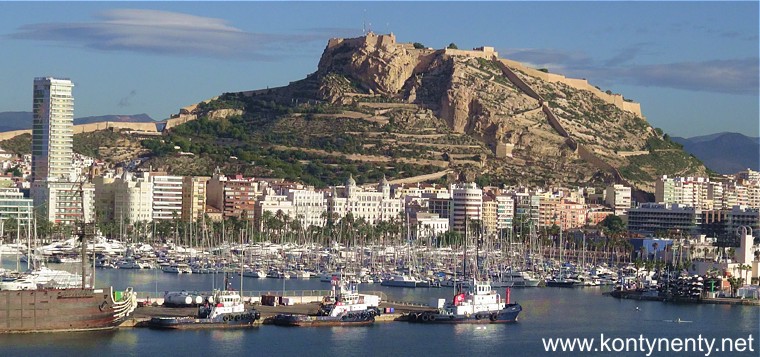
The next port of our cruise was Tenerife. As we approached the island with a strange whim of nature behind the curtain of clouds covering part of the island, two rainbows appeared at once (pictured below). I have been to Tenerife several times, so I used the time of the stop for a walk around the city and visiting an interesting (and in addition - free!) military museum.
Kolejnym portem naszego rejsu była Teneryfa. Gdy zbliżaliśmy się do wyspy dziwnym kaprysem przyrody za zasłonie chmur przesłaniającej część wyspy pojawiły się na raz dwie tęcze (na zdjęciu poniżej). Byłem na Teneryfie już kilkakrotnie, więc czas postoju wykorzystałem na spacer po mieście i odwiedzenie ciekawego (i w dodatku bezpłatnego) muzeum wojskowego.
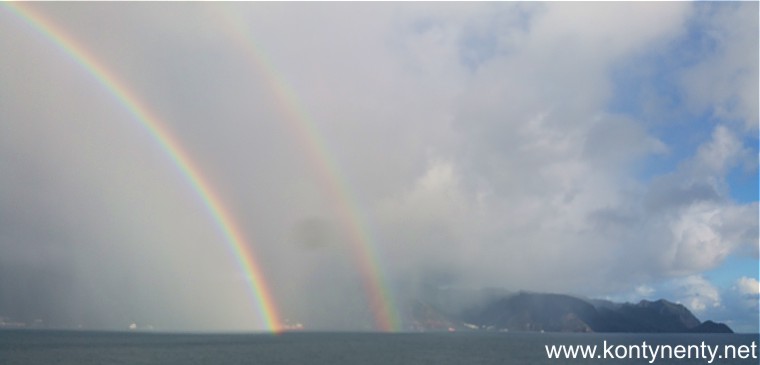
After another two days spent in the sea, our ship reached the Cape Verde Islands, and more precisely - to the island of Sao Vincente. I've been here once, but briefly. This stay allowed to organize the trip by car rented together with the Russians, during which we visited, among others the highest peak of the island - Monte Verde, visible in the photo:
Po kolejnych dwóch dniach spędzonych w morzu nasz statek dotarł do Wysp Zielonego Przylądka, a dokładniej - do wyspy Sao Vincente. Byłem tu już kiedyś, ale krótko. Ten pobyt pozwolił na wycieczkę wynajętym wspólnie z Rosjanami samochodem, podczas które dotarliśmy m.in. na widoczny na zdjęciu najwyższy szczyt wyspy - Monte Verde:
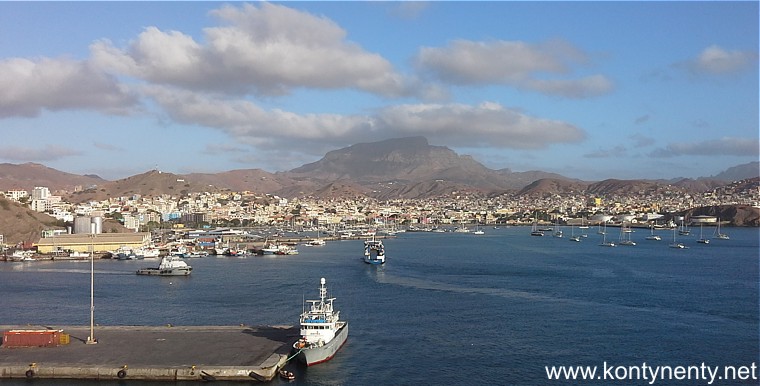
A few years ago a new section of the road was built along the east coast of the island. There are no settlements here, but there are nice beaches, and every turn of this road opens practically a new, beautiful panorama:
Kilka lat temu zbudowano nowy odcinek szosy wzdłuż wschodniego wybrzeża wyspy. Tędy właśnie jechaliśmy. Nie ma tu żadnych osiedli, ale są ładne plaże, a każdy zakręt tej drogi otwiera praktycznie nową, piękną panoramę:
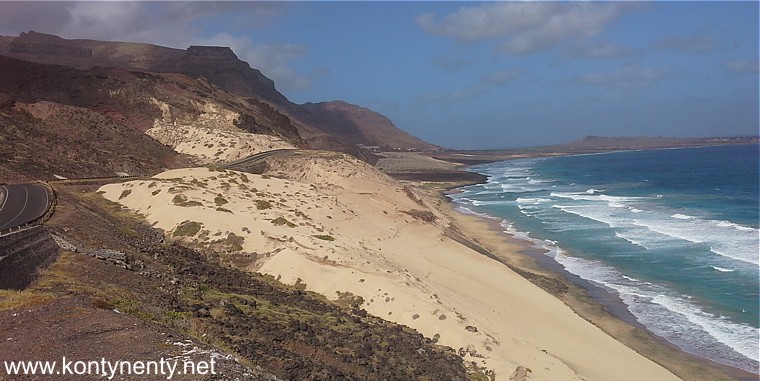
After returning to the capital of the island - Mindelo, I had time to see the old part of the city - including building of the Portuguese high school, which currently houses the university. I met a group of nice students there. They inquired curiously about my trip and my impressions from Cape Verde. Then they gave me the password to the university wi-fi network, and we took a souvenir photo:
Po powrocie do stolicy wyspy - Mindelo wciąż miałem czas, aby obejrzeć starą część miasta - m.in. budynek portugalskiego liceum, w którym obecnie mieści się uniwersytet. Spotkałem tam grupę sympatycznych studentów. Z zaciekawieniem pytali o moją podróż i o moje wrażenia z Cape Verde. Potem dali mi hasło do uczelnianej sieci wi-fi (trudno tu o internetowe połączenie), no i zrobiliśmy sobie pamiątkowe zdjęcie:
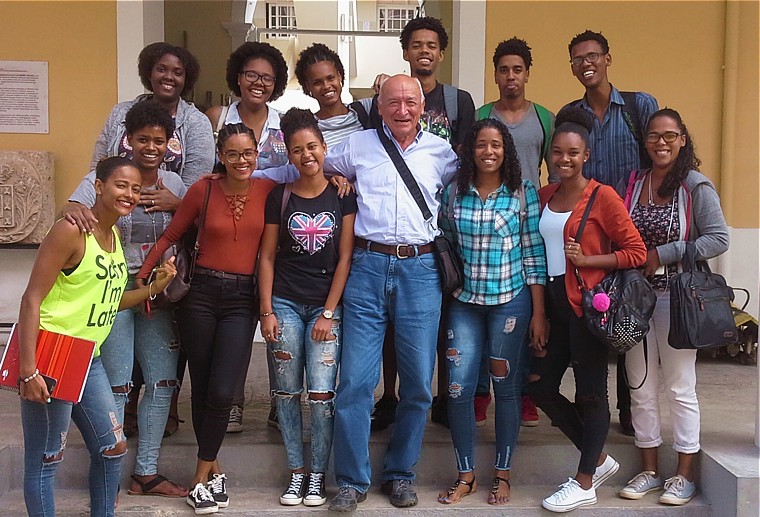
On the other side of the Atlantic I landed in the Brazilian port of Recife. I was there before, so the same day I flew to Belo Horizonte, from where the truck took me from the airport directly to the interior. The first goal on the Royal Road (or rather to the side of this road) was the third highest waterfall in Brazil - Cachoeira Tabuleiro - 273 m. In favorable weather I managed to reach this waterfall. The view was great and worth sweated sweat: Read more about this waterfall in my report.
Po drugiej stronie Atlantyku wylądowałem w brazylijskim porcie Recife. Byłem tam wcześniej, więc jeszcze tego samego dnia poleciałem do Belo Horizonte, skąd, z lotniska półciężarówka zabrała mnie w interior. Pierwszym celem na Królewskiej Drodze (a właściwie w bok od tej drogi) był trzeci co do wysokości wodospad Brazylii - Cachoeira Tabuleiro - 273 m. Przy sprzyjającej pogodzie udało mi się dojść pod ten wodospad. Widok był wspaniały i wart wypoconego potu. Więcej o tym wodospadzie przeczytacie w mojej relacji.
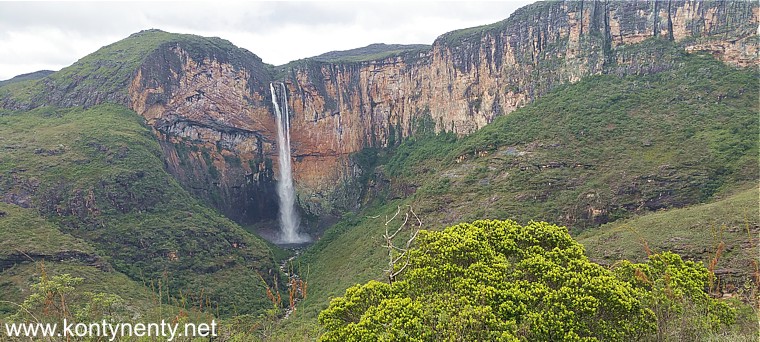
Then, on a gravel road covered with rainfall, I got to the first interesting town on Estrada Real - Serro. It has largely preserved its appearance from 300 years ago:
Następnie szutrową, rozmytą przez opady drogą dotarłem do pierwszego ciekawego miasteczka na Estrada Real - Serro. Zachowało ono w dużej mierze swój wygląd sprzed 300 lat:
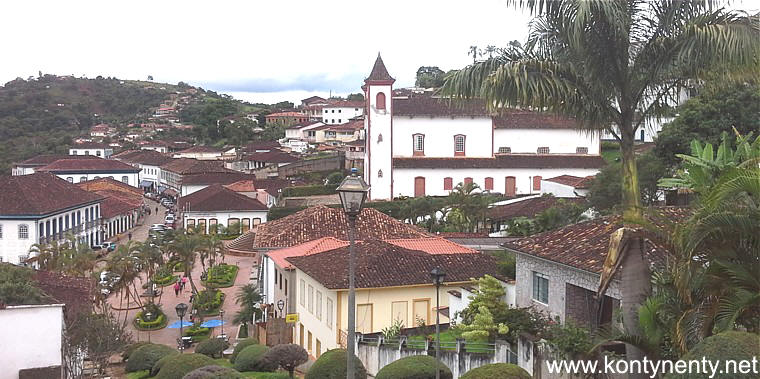
Diamantina - the nex visited town is similar, but slightly larger. And here are also steep streets paved with irregular stones, richly decorated churches and houses with colorful window frames. In the Diamantina area gold and diamonds are still legally (and illegally) extracted:
Podobna, lecz nieco większa jest Diamantina, dokąd potem pojechałem. I tu także zachowały się strome ulice brukowane nieregularnymi kamieniami, bogato zdobione kościoły i domy o kolorowych ościeżnicach okien. W okolicach Diamantiny wciąż jeszcze legalnie (i nielegalnie) wydobywa się złoto i diamenty:
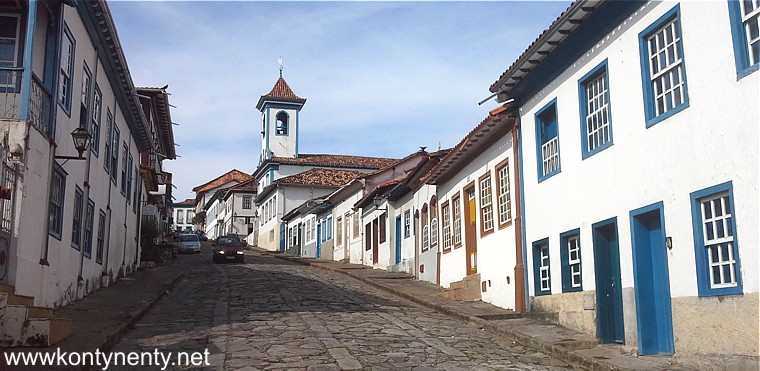
Tourists whom I met here are almost exclusively Brazilians. Museums are free here, but there is a fee for admission to richly equipped churches: 5-10 BRL. In the windows of many houses I saw souvenirs for sale. What I liked the most was those made of ceramics:
Turyści, których tu spotykałem to prawie wyłącznie Brazylijczycy. Muzea są tu bezpłatne, natomiast pobiera się opłatę za wstęp do bogato wyposażonych kościołów: 5-10 BRL. W oknach wielu domów widziałem wystawione na sprzedaż pamiątki. Najbardziej podobały mi się te, które wykonano z ceramiki:
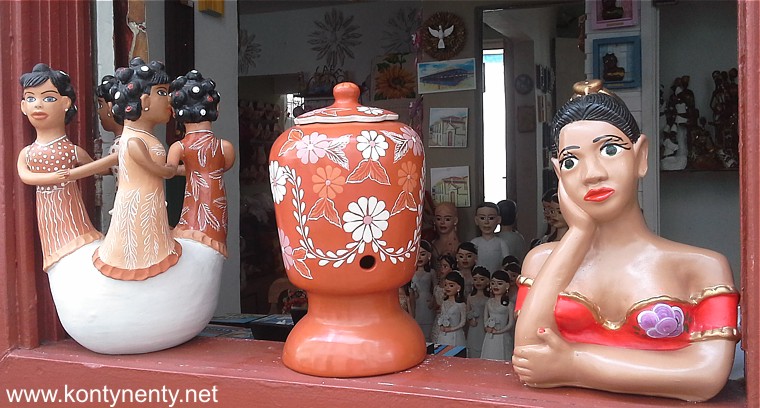
In Diamantina I lived at the Couchsurfing host. Victor drove me to the nearby Biribiri Nature Reserve this afternoon. There are, among others, small, picturesque waterfalls, and at their feet - small lakes where you can swim:
W Diamantinie mieszkałem u hosta z Couchsurfingu. Victor zawiózł mnie po południu do pobliskiego rezerwatu przyrody Biribiri. Są tam między innymi małe, malownicze wodospady, a u ich stóp - niewielkie jeziorka, w których można się kąpać:
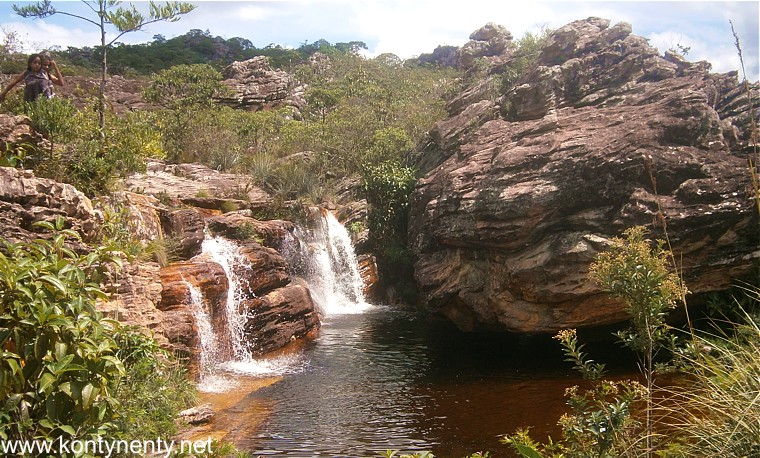
The next town that I visited by following Estrada Real in the south direction was called Sabara. I found in it not only old architecture, but also a museum of gold, where they show not only ways of extracting this metal changing over the centuries, but also gold products secured in solid old safes behind the armored glass:
Kolejne miasteczko, które odwiedziłem podążając Estrada Real w kierunku południowym nazywało się Sabara. Znalazłem w nim nie tylko starą architekturę, ale także muzeum złota, gdzie pokazują nie tylko sposoby wydobywania tego kruszcu zmieniające się na przestrzeni wieków, ale także zabezpieczone w solidnych starych sejfach za pancerną szybą wyroby użytkowe ze złota:
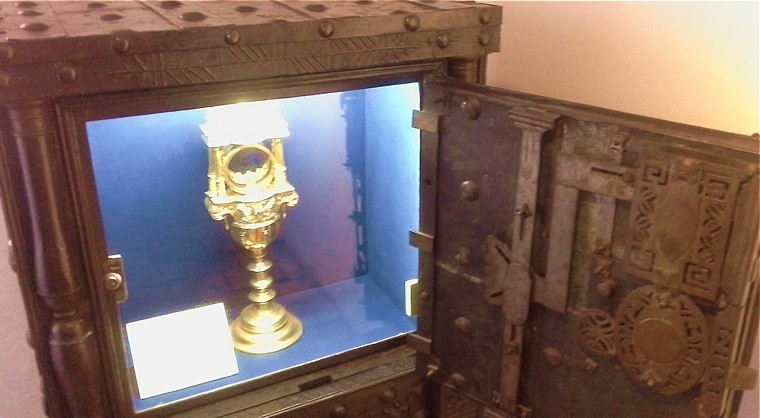
Then I had to go back to Belo Horizonte to change the bus to the one that goes to the colonial town of Caete. In similar places visited by tourists, you can easily find accommodation in pousadas or small guesthouses, which are equivalent to our private accommodation. A room with bathroom and breakfast costs 70-80 BRL, and with shared bathroom is 50-60. From the terrace of my quarters at Caete, a view of the most beautiful Matriz church in the city was opened:
Potem musiałem wrócić do Belo Horizonte, by zmienić autobus na ten, który podąża do kolonialnego miasteczka Caete. W podobnych miejscach odwiedzanych przez turystów można bez trudu znaleźć nocleg w pousadach czyli małych pensjonatach, będących odpowiednikami naszych kwater prywatnych. Pokój z łazienką i śniadaniem kosztuje zazwyczaj 70-80 BRL, a ze wspólna łazienką 50-60. Z tarasu mojej kwatery w Caete otwierał się taki widok na najpiękniejszy w mieście kościół Matriz:
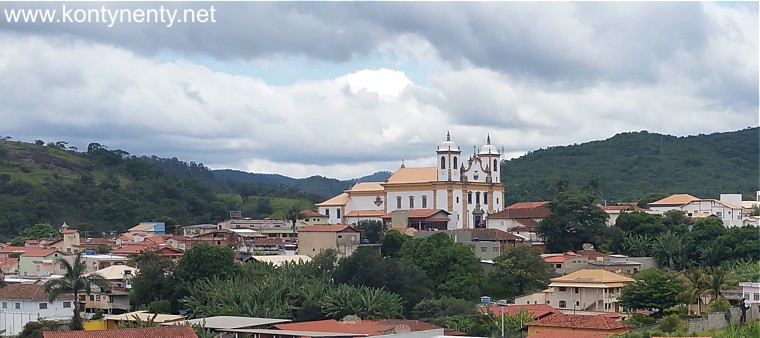
From Caete to the Sanctuary of Caraca, you can take a partially gravel road through the mountains. But public transport on this road is missing. Even taxi drivers refuse to drive this shortcut, explaining that there are weaponed bandit raids on the road. I had to take the circuitous route - first to Santa Barbara. But I got anyway to the beautifully located Caraca Sanctuary. Here it is, 1300 m above sea level:
Z Caete do Sanktuarium Caraca można dojechać drogą częściowo szutrową przez góry. Ale publicznego transportu na tej drodze brak. Nawet taksówkarze odmawiają jazdy tym skrótem, tłumacząc, że na drodze zdarzają się bandyckie napady z bronią. Musiałem zatem jechać okrężną drogą - najpierw do Santa Barbara, bezskutecznie próbując autostopu. Ale do pięknie położonego wśród gór Sanktuarium Caraca jednak dotarłem. Oto ono, 1300 m npm:
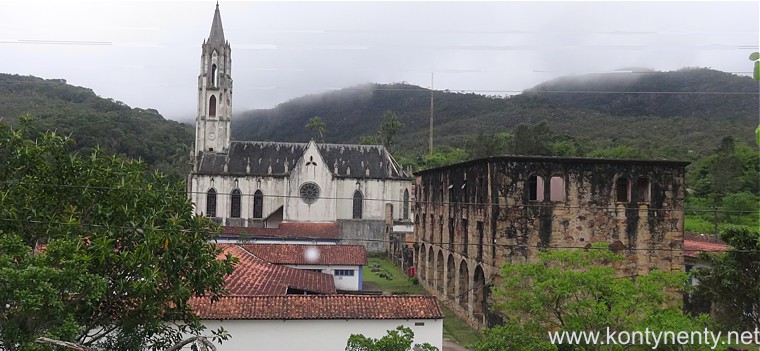
Later that same day I found myself further south - in the colonial settlement of Catas Altas, located at the foot of a high mountain ridge. This picturesque, quiet settlement can be recommended to those who are looking for peace and atmosphere from before the age. Nowhere on the Estrada Real route has I found such a romantic place:
Jeszcze tego samego dnia znalazłem się dalej na południe - w kolonialnej osadzie Catas Altas, położonej u stóp wysokiego górskiego grzbietu. Tą malowniczą, cichą osadę można polecić tym, którzy szukają spokoju i atmosfery sprzed wieku. Są tu kwatery prywatne. Nigdzie na mojej trasie Estrada Real nie znalazłem tak nastrojowego miejsca:
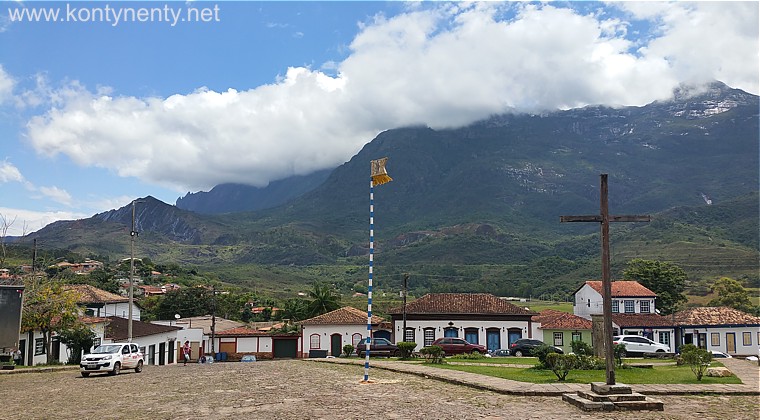
A completely different atmosphere prevails in the town of Mariana. Here, in the old part of the city, beautiful colonial churches, the seat of the city council and pelurinho have been preserved - a stone pole at which the slaves were flogged with slaves. But this old Mariana has grown into huge, new suburbs and today has nearly 60,000 inhabitants, many of whom work in the surrounding mines:
Zupełnie inna atmosfera panuje w miasteczku Mariana. Tu też w starej części miasta zachowały się ładne kolonialne kościoły, siedziba rady miejskiej i pelurinio - kamienny pal przy którym wymierzano karę chłosty niewolnikom. Ale ta stara, urokliwa Mariana obrosła ostatnio wielkimi, nowymi przedmieściami i ma dziś blisko 60 tysięcy mieszkańców, wielu spośród nich pracuje w okolicznych kopalniach:
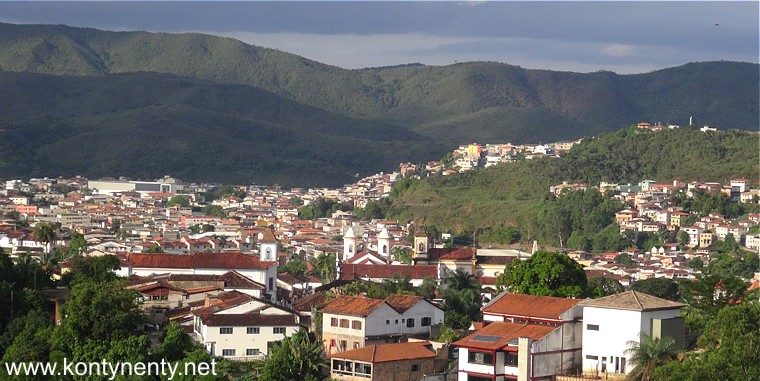
Just a few kilometers further lies the town of Ouro Preto (Black Gold), which has been placed on the UNESCO World Heritage list. Its very location on the steep hills is unique. Thirteen historic churches, a fort and public buildings from the 17th and 18th centuries create a wonderful complex of monuments - perhaps the most interesting in Brazil. Only Salvador / Bahia can compete with him:
Zaledwie kilkanaście kilometrów dalej leży miasteczko Ouro Preto (Czarne Złoto), które umieszczone zostało na liście Światowego Dziedzictwa UNESCO. Niezwykłe jest już same jego położenie na stromych wzgórzach. Trzynaście zabytkowych kościołów, fort i budynki publiczne z XVII i XVIII wieku tworzą wspaniały kompleks zabytków - bodaj, czy nie najciekawszy w Brazylii. Konkurować z nim może tylko Salvador/Bahia:
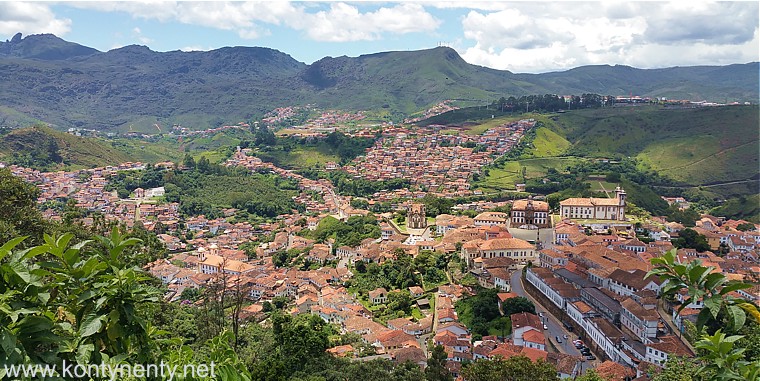
I stayed in Ouro Preto for 2 days and then went to Congonhas - a city famous for its rich basilica. In front of it there is a gallery of 12 statues of prophets (those from the Old Testament) - this is the work of Aleijadinho - the most famous architect and sculptor of the Brazilian Baroque era. For many years the Basilica has been the destination of Catholic pilgrimages:
W Ouro Preto zostałem 2 dni, a potem podążyłem do Congonhas - miasta słynącego z bogatej bazyliki. Przed nią umieszczono galerię 12 posągów proroków (tych ze Starego Testamentu) - to dzieło Aleijadinho - najsłynniejszego architekta i rzeźbiarza epoki brazylijskiego baroku. Bazylika jest od wielu lat celem pielgrzymek katolików:
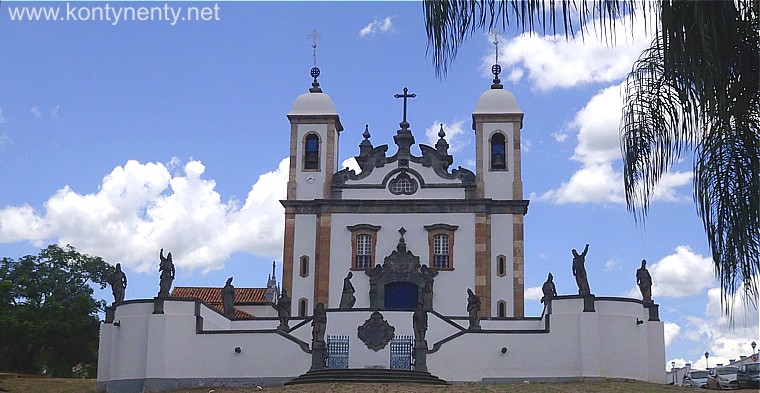
In the incredibly richly decorated interiors of colonial churches throughout Estrada Real, taking pictures is difficult, sometimes even forbidden. After arriving in Tiradentes, I managed to take a fairly good photo at the church of San Antonio (below). It gives an idea of the internal richness of churches, which from the outside usually look very modest:
W niesłychanie bogato zdobionych wnętrzach kolonialnych kościołów na całej Estrada Real robienie zdjęć jest utrudnione, czasem wręcz zabronione. Po przybyciu do Tiradentes udało mi się zrobić dość dobre zdjęcie w kościele San Antonio (poniżej). Daje ono wyobrażenie o wewnętrznym bogactwie kościołów, które z zewnątrz wyglądają zazwyczaj bardzo skromnie:
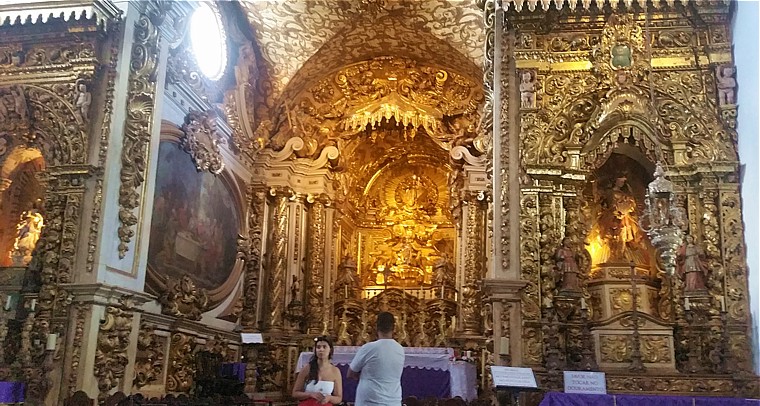
Aa addictional tourist attraction in Tiradentes is also a narrow-gauge train, traveling with tourists on weekends only to Sao Joao del Rei. The wagons with wooden benches are pulled by an archaic steam locomotive, nicknamed "Maria Fumaca" (Smoky Mary), here it is:
Ciekawostką turystyczną w Tiradentes jest także wąskotorowy pociąg, kursujący z turystami w weekendy do Sao Joao del Rei. Wagoniki z drewnianymi ławkami ciągnie archaiczna parowa lokomotywka, nazywana pieszczotliwie "Maria Fumaca" (Dymiąca Maryśka) oto ona:
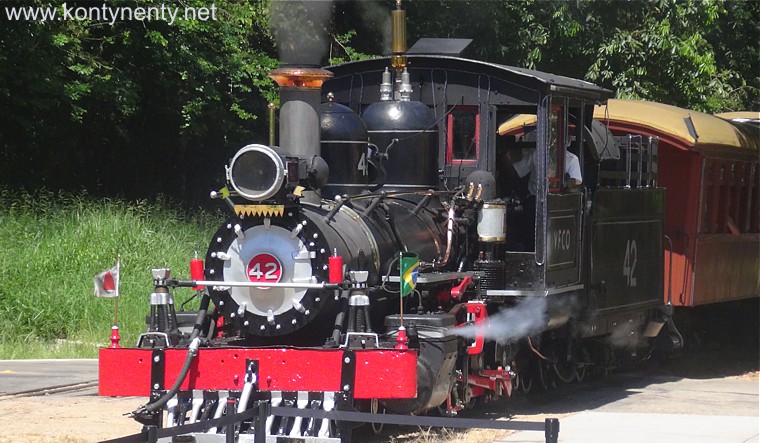
The return journey aboard "Mary" costs as much as 60 real, so I preferred to go to Sao Joao by bus for 3.80 :)
Sao Joao was the last town on the route of my journey by the Royal Road. The city has a beautifully preserved Old Town, creating a unique architectural complex with several churches, among which Pillar and San Francisco Asisi stand out. In front of the latter is a beautiful garden (pictured below) with ever-blooming hortensia flowers...
Powrotny przejazd "Maryśką" kosztuje aż 60 reali, więc ja wolałem jechać do Sao Joao autobusem za 3,80 :)
Sao Joao było ostatnim miasteczkiem na trasie mojej podróży Królewska Drogą. Miasto ma pięknie zachowaną Starówkę, tworzącą unikalny kompleks architektury z kilkoma kościołami wśród których wyróżniają się Pillar i San Francisco Asisi. Przed tym ostatnim jest piękny ogród (na zdjęciu poniżej) z wiecznie kwitnącymi hortensjami...
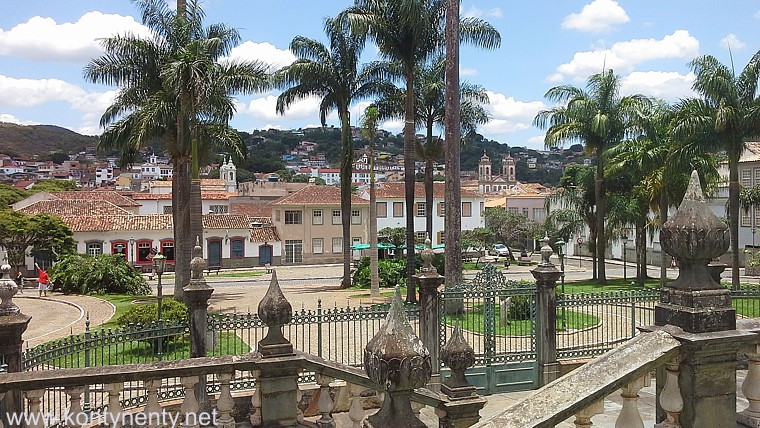
My return flight to Poland began in Sao Paulo. I got there by bus and for that with many adventures (damage and exchange of the bus, triple ramming of the highway... It was dark when I got to the quarters offered by nice Brazilian travelers: Mariana and Andre.) Interesting conversations and exchange of experiences lasted almost until midnight.
I had the opportunity to go arouid this monster city (11 million people live here!). As years ago I was shocked by the number of people sleeping on the streets. The most interesting place seemed to be the square in front of the Se cathedral:
Mój powrotny lot do Polski zaczynał się w Sao Paulo. Dotarłem tam autobusem i do tego z wieloma przygodami (uszkodzenie i zamiana wozu, trzykrotne taranowanie szlabanów autostrady... Było już ciemno, gdy dotarłem na kwaterę do sympatycznych brazylijskich podróżników: Mariany i Andre. Ciekawe rozmowy i wymiana doświadczeń trwały prawie do północy.
Rano miałem okazję przypomnieć sobie to wielkie miasto (11 mln ludności!). Jak przed laty zaszokowało mnie ilością ludzi śpiących na ulicach. Najciekawszym miejsce wydał mi się być ruchliwy plac przed katedrą Se:
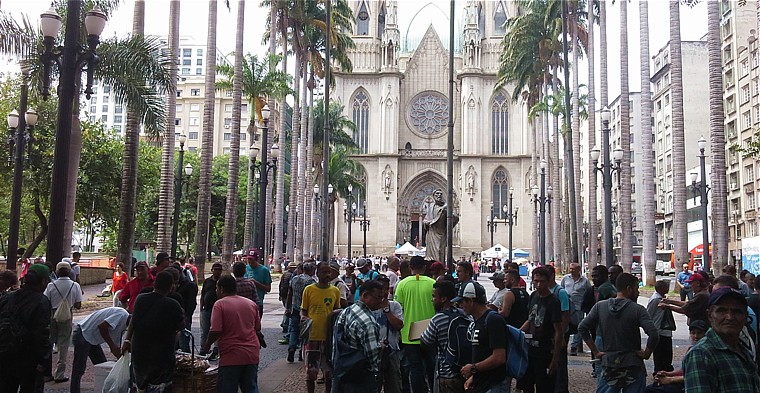
Without any unpleasant adventures, I returned to Gdansk flying three consecutive planes. I managed to implement the plan of a unique journey in its entirety. I saw new, interesting places, met new people and experienced new adventures. You can see the map of the entire journey here. Hot news from the route can be found, as always, in my my travel log
Bez żadnych nieprzyjemnych przygód trzema kolejnymi samolotami wróciłem do Gdańska. Plan unikalnej podróży udało mi się zrealizować w całości. Zobaczyłem nowe, ciekawe miejsca, poznałem nowych ludzi i przeżyłem nowe przygody. Mapkę całej podróży możecie zobaczyć tutaj. Wieści zapisane na gorąco na trasie znajdziecie jak zawsze w moim dzienniku podróży